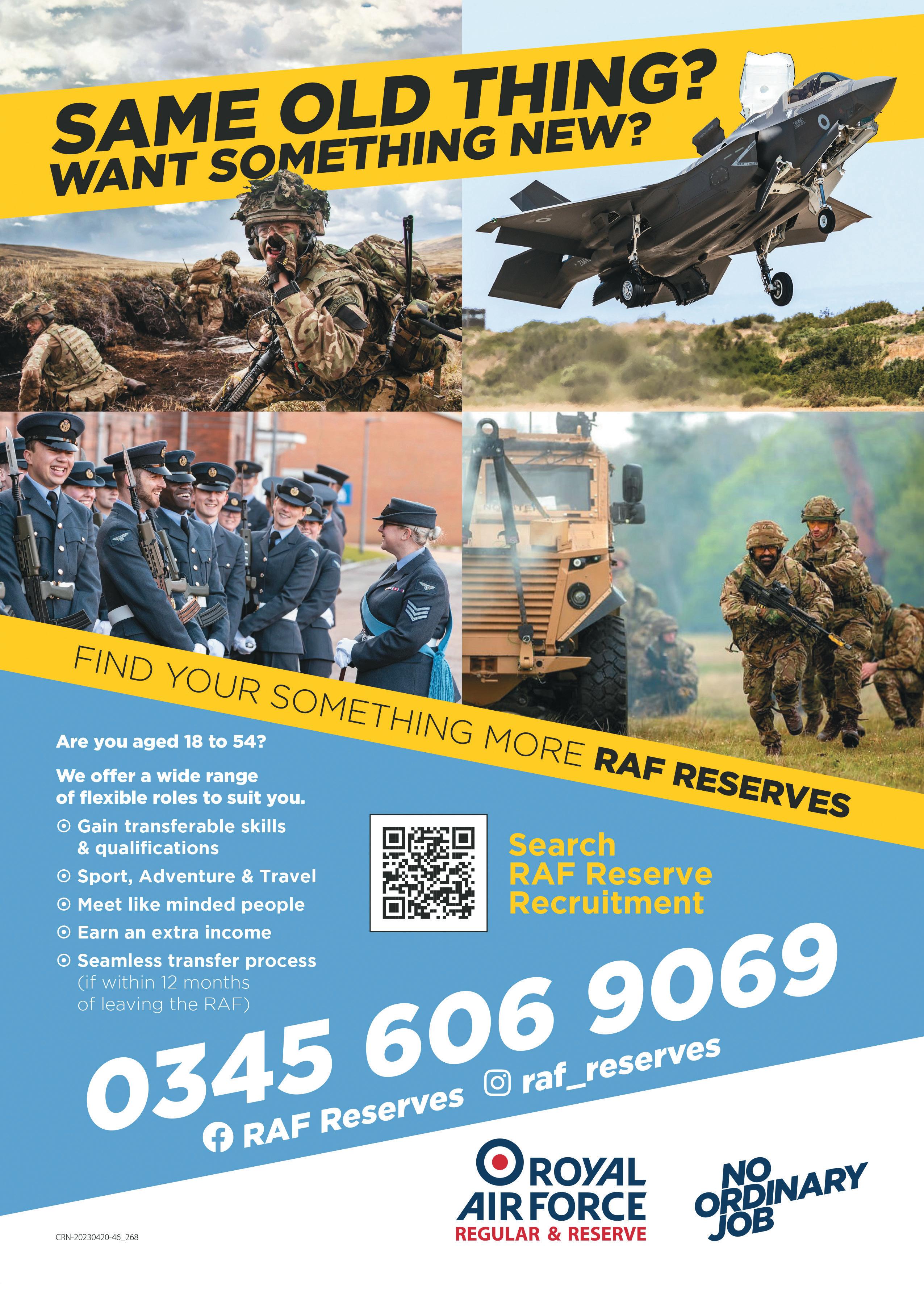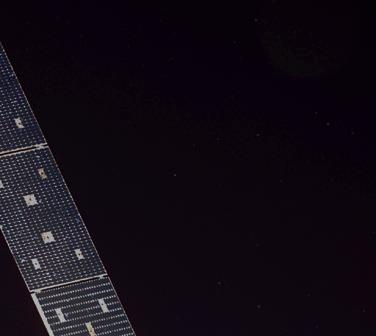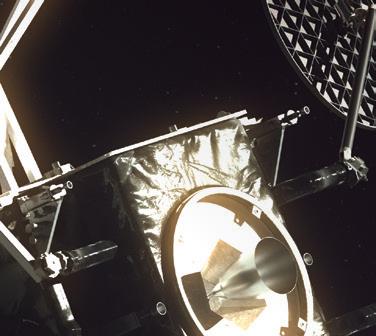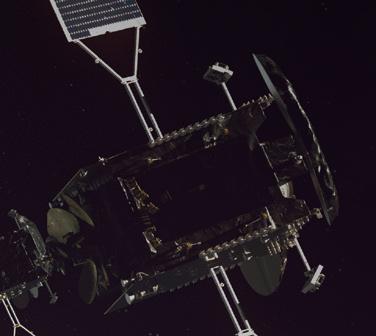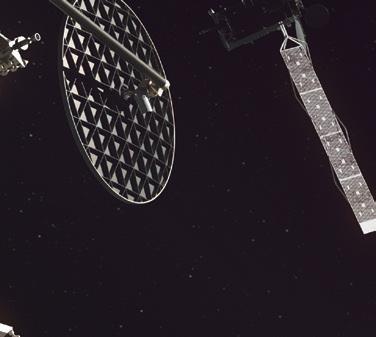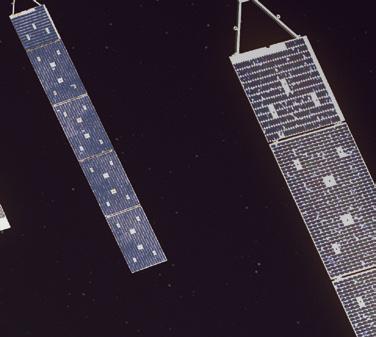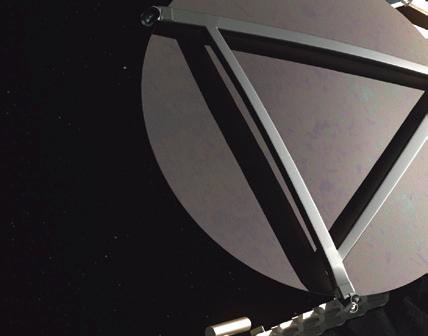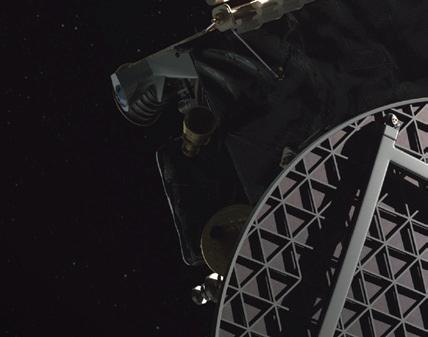Air & Space



KC-390 MILLENNIUM
















From the outset, the KC-390 Millennium was designed to set a new benchmark in the medium-size military transporter segment. Developed with support from the Brazilian Air Force (FAB) and Brazilian Government, the largest and most complex aircraft ever built in the southern hemisphere has gone through a rigorous and challenging testing program, including 3,500 prototype flight test hours and close to 85,000 hours of lab tests. In March 2023, it received the coveted Full Operational Capability certification from the Brazilian Military Certification Authority (IFI – Institute of Industrial Development and Coordination), with the platform meeting or exceeding all requirements. This seal of approval, which is extremely difficult to attain, confirms the KC-390 Millennium is ready for full operational duties in all missions and showcases to the world its class-leading reliability, flexibility and performance.
#C390UnbeatableCombination c390foc.com/en/
Editor Simon Michell
Project Manager Group Captain Paul Sanger-Davies, Director of Defence Studies (RAF)
Editorial Director Barry Davies
Designer Ross Ellis
Managing Director Andrew Howard
Printed by Pensord
Front cover image: Cpl Hazel Reader (RAF)
Published by Chantry House, Suite 10a High Street, Billericay, Essex CM12 9BQ
United Kingdom
Tel: +44 (0) 1277 655100
On behalf of the Royal Air Force Ministry of Defence Main Building, Whitehall, London SW1A 2HB, UK www.raf.mod.uk
© 2023. The entire contents of this publication are protected by copyright. All rights reserved. No part of this publication may be reproduced, stored in a retrieval system, or transmitted in any form or by any means: electronic, mechanical, photocopying, recording or otherwise, without the prior permission of the publisher. The views and opinions expressed by independent authors and contributors in this publication are provided in the writers’ personal capacities and are their sole responsibility. Their publication does not imply that they represent the views or opinions of the Royal Air Force or Global Media Partners and must neither be regarded as constituting advice on any matter whatsoever, nor be interpreted as such. The reproduction of advertisements in this publication does not in any way imply endorsement by the Royal Air Force or Global Media Partners of products or services referred to therein.
As a founding member of Tempest, Leonardo UK is helping to secure the RAF’s combat air advantage for future decades. In the Global Combat Air Programme (GCAP), Leonardo is the UK lead for the ISANKE (integrated sensing and non-kinetic effects) and ICS (integrated communications system) domain, meaning that Leonardo’s advanced electronics will be at the core of the future system’s combat capabilities.


Building on 100 years of heritage in advanced design and manufacturing in the UK, Leonardo’s work on this iconic project will galvanise future generations and contribute to the nation’s prosperity.
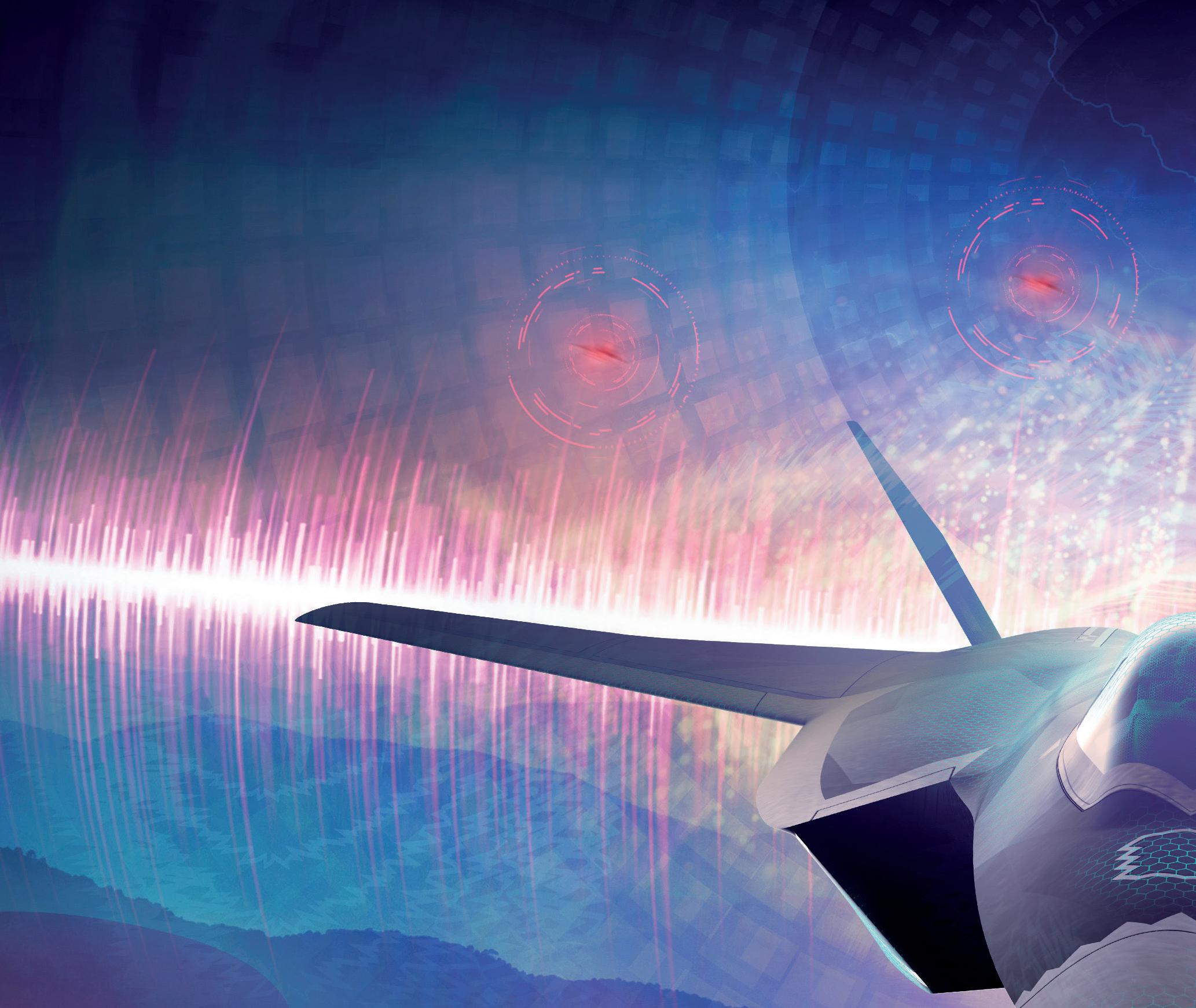

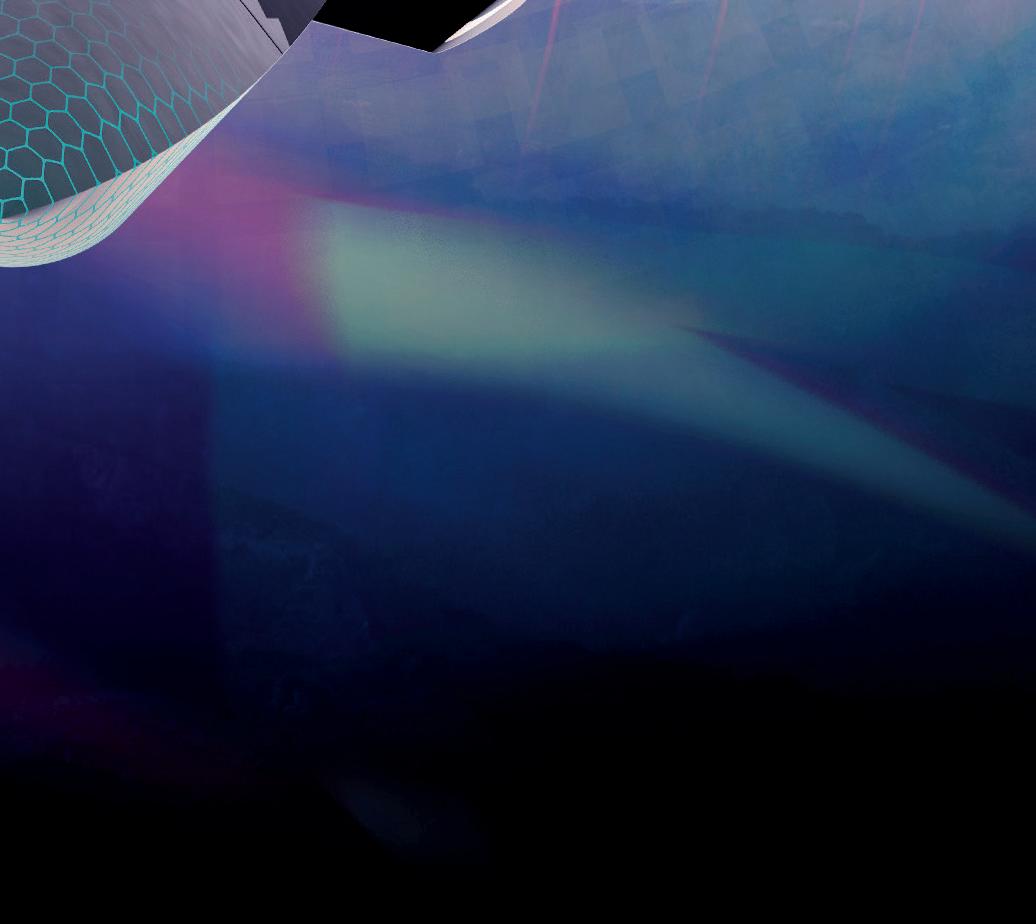

Chief Marshal Sir Richard Knighton
32 Lessons from Ukraine
Air Marshal (Retd) Greg Bagwell, President, Air & Space Power Association
33 Space capability integration: integrating with allies and partners
Air Commodore Adam Bone, Head of Space Operations, Planning and Training at UK Space Command, explains what needs to be done to deliver the requisite levels of integration
37 Providing advanced modern capabilities
Kevin Craven, Chief Executive O cer, ADS Group
38 Evolving global multi-domain operations
Northrop Grumman UK’s Paul Tremelling explains how global multi-domain operations will transform the speed with which decision-quality information is relayed to the e ector of choice for optimum e ect
40 ACE – Agile Combat Employment, delivered globally
Group Captain Jason Payne, No 11 Group’s Deputy Assistant Chief of Sta , discusses the development of the ACE concept, designed to enable the RAF to operate from a greater number of locations

Air Marshal Johnny Stringer, Deputy Commander of Allied Air Command at Ramstein Airbase, Germany, reveals how his command ensures the security of NATO territory
44 RAF strategic support to Ukraine and lessons learnt
Air Vice-Marshal Phil Robinson, Air O cer Commanding No 11 Group, on how UK support to Ukraine will inform the development of future RAF capabilities and doctrine
47 Global Enablement and future Force Protection
Air O cer Global Enablement, Air Commodore Jamie Thompson, explains how the Global Enablement Organisation will deliver enhanced security and capability to the UK
49 AUKUS strategic partnership
Air Vice-Marshal Simon Edwards, Assistant Chief of the Air Sta (Strategy), outlines the bene ts of the Trilateral Security Pact between Australia, the United Kingdom and the United States, which incorporates collaboration across a range of capability areas
52 Number 1 Group transformation
Air Vice-Marshal Mark Flewin explains how Number 1 Group is evolving to ensure that it can continue to deliver decisive air power across all its roles
55 RAF Lossiemouth: enhancing strategic importance

The RAF’s E-7A Programme Manager, Wing Commander Ben Fletcher, reveals how the arrival in 2024 of three new E-7A Wedgetail airborne early warning aircraft will enhance RAF Lossiemouth’s already signi cant strategic importance to UK defence
57 Projecting air and space power in the 21st century
Peter Round, President, Royal Aeronautical Society
58
Introducing Protector
Group Captain Rob Barrett, the ISTAR Force Headquarters Deputy Head of Capability, highlights how the MQ-9B Protector RG Mk 1 will complement the capabilities of the ISTAR Force from next year, when it is due to enter service
62
GLOBAL STRATEGIC PARTNER PERSPECTIVE

Lieutenant General Luca Goretti
Chief of Sta of the Italian Air Force
63 Typhoon radar capability upgrade
Air Commodore Ian ‘Cab’ Townsend, Assistant Chief of the Air Sta Capability Delivery Combat Air, outlines the outstanding bene ts of the Typhoon’s next radar system – ECRS2
67 F-35 capability growth
Air Commdore Howard Edwards, the newly appointed Combat Air Force Commander, describes how the RAF is enhancing the combat capability of the F-35B Lightning
70 GLOBAL STRATEGIC PARTNER PERSPECTIVE General Shunji Izutsu
Previous Chief of Sta of Japan Air Self-Defense Force
71 Delivering mission readiness through training
BAE Systems’ Lucy Walton explains how the company is leading the development of technologies that will train the military forces of tomorrow
74 Driving more resilient and secure satellite communications
Hisham Awad, new Managing Director of Viasat UK, explains why an agile, adaptable development process is needed to procure satellite communication systems
76 The evolution of UK Space Command
Air Vice-Marshal Paul Godfrey, Commander of UK Space Command, talks about the Command’s expansion since it was established in April 2021
79 Strategic cybersecurity: partnership by default and the importance of a Whole Force paradigm
Air Vice-Marshal Tim Neal-Hopes, Director of Cyber Intelligence and Information Integration (DCI3), highlights how Russia’s cyber onslaught on Ukraine and its allies emphasises the need for a partnership and Whole Force approach to cyber operations
81 RAF technology and innovation strategy
Cecil Buchanan, the RAF’s Chief Technology O cer and Head of Science at the Rapid Capabilities O ce, explains his technological vision
84
Innovative by design and innovative by instinct
Wing Commander Matt Morris reveals how the RAF is embedding its innovation mindset to maintain its operational edge
87 Team Tempest – developing next generation capabilities
Interviewed prior to becoming Chief of the Air Sta , Air Marshal Sir Richard Knighton examines what the new trilateral partnership between the UK, Japan and Italy to develop the UK’s Tempest ghter aircraft means to the UK Defence community
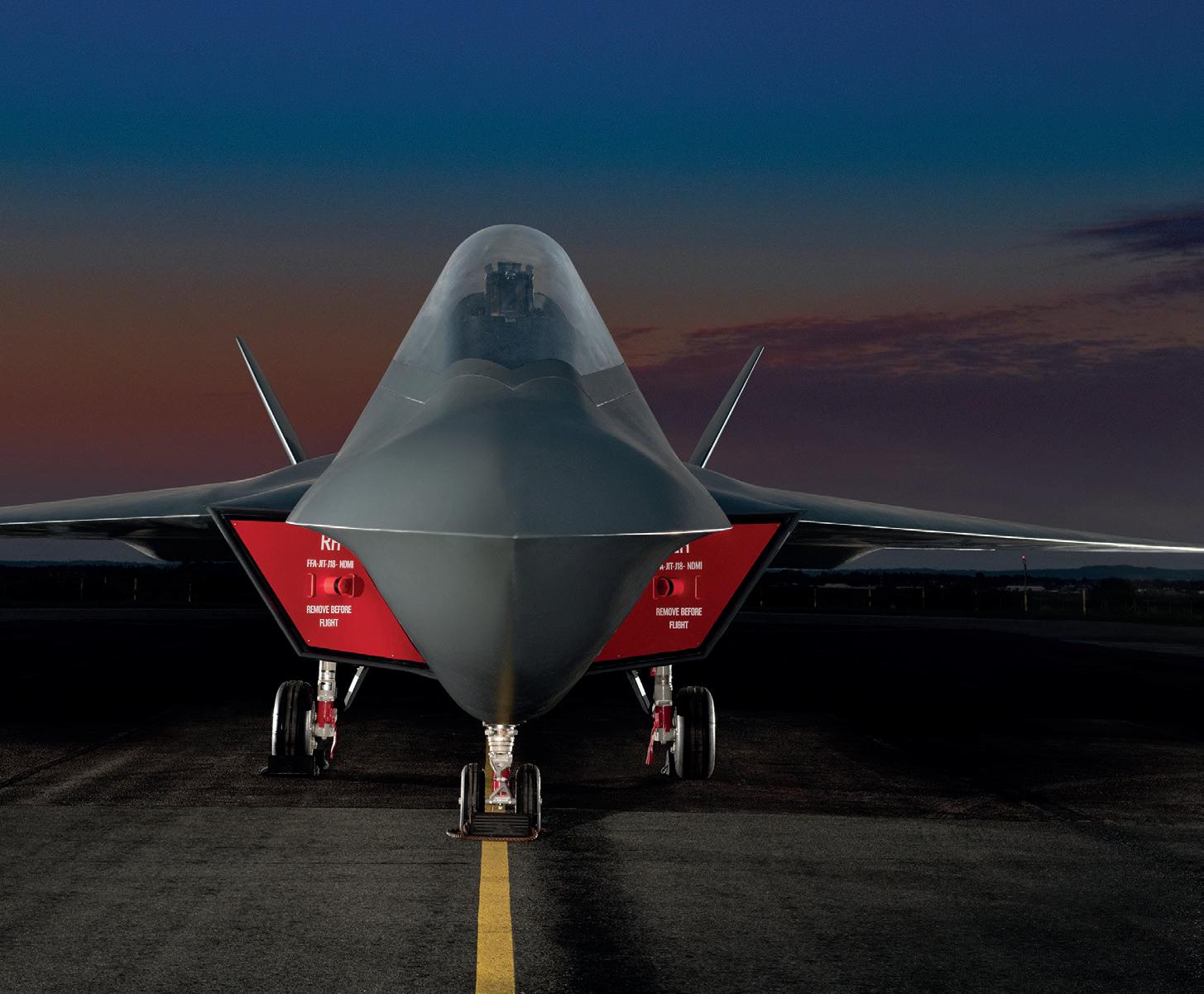
90 GCAP – reducing cognitive burden
MBDA UK’s Chris Allard reveals how arti cial intelligence and machine learning are being used to reduce the cognitive burden of future pilots
92
AI-enabled air command and control and information management
Air Vice-Marshal Linc Taylor, Chief of Sta , Capability, and Chris Platt, Arti cial Intelligence (AI)
Experimentation Programme Leader at the Rapid Capabilities O ce, discuss progress towards the RAF’s future AI-enabled Command and Control capability
94 Gaining and maintaining digital and data dominance
The RAF’s rst Chief Digital Information O cer, Dr Arif Mustafa, talks about what his job entails and how he will enhance RAF capabilities
Creating the Combat Cloud –Nexus and Raven
Group Captain Ian Bews and Wing Commander Dave Collins reveal how two game-changing components of the UK’s Combat Cloud were developed
Cohering credible counter-UAS capabilities
Group Captain Gary Darby, Head of the Joint Counter-UAS O ce (JCO), describes how his team is developing counter-drone capabilities
Changing with the generations
Air Vice-Marshal Maria Byford, Chief of Sta Personnel, outlines how the RAF is driving forward attraction, recruitment and retention initiatives
Introducing DCDC
Air Vice-Marshal Fin Monahan, Director of the Developments, Concepts and Doctrine Centre (DCDC) at Shrivenham, outlines the role that the Centre plays in evolving UK Defence capability
105 Enhancing UKMFTS capabilities and the wider training pipeline
Group Captain Ryan S Morris, Assistant Director Plans at the Directorate of Flying Training, o ers up a reassuring account of the current state of UK military ying training and a compelling insight into its future
108 Cyber Reserve
Wing Commander Martin Smith of the Cyber Reserve Force explains how the RAF is tackling the issue of attracting su cient people to assure data and achieve information advantage
110
Group Captain Paul Sanger-Davies considers how the RAF can best develop its cognitive capabilities in order to outthink and out ght potential enemies
112
The Commandant of the Tedder Academy of Leadership, Group Captain Emma Keith, explains how she ensures that leadership and command education is accessible to everyone across the Whole Force
116 The next o set strategy
Honourable Group Captain Kevin Billings from 601 Squadron explains why it is the right time to double down on the RAF’s commitment to addressing climate change







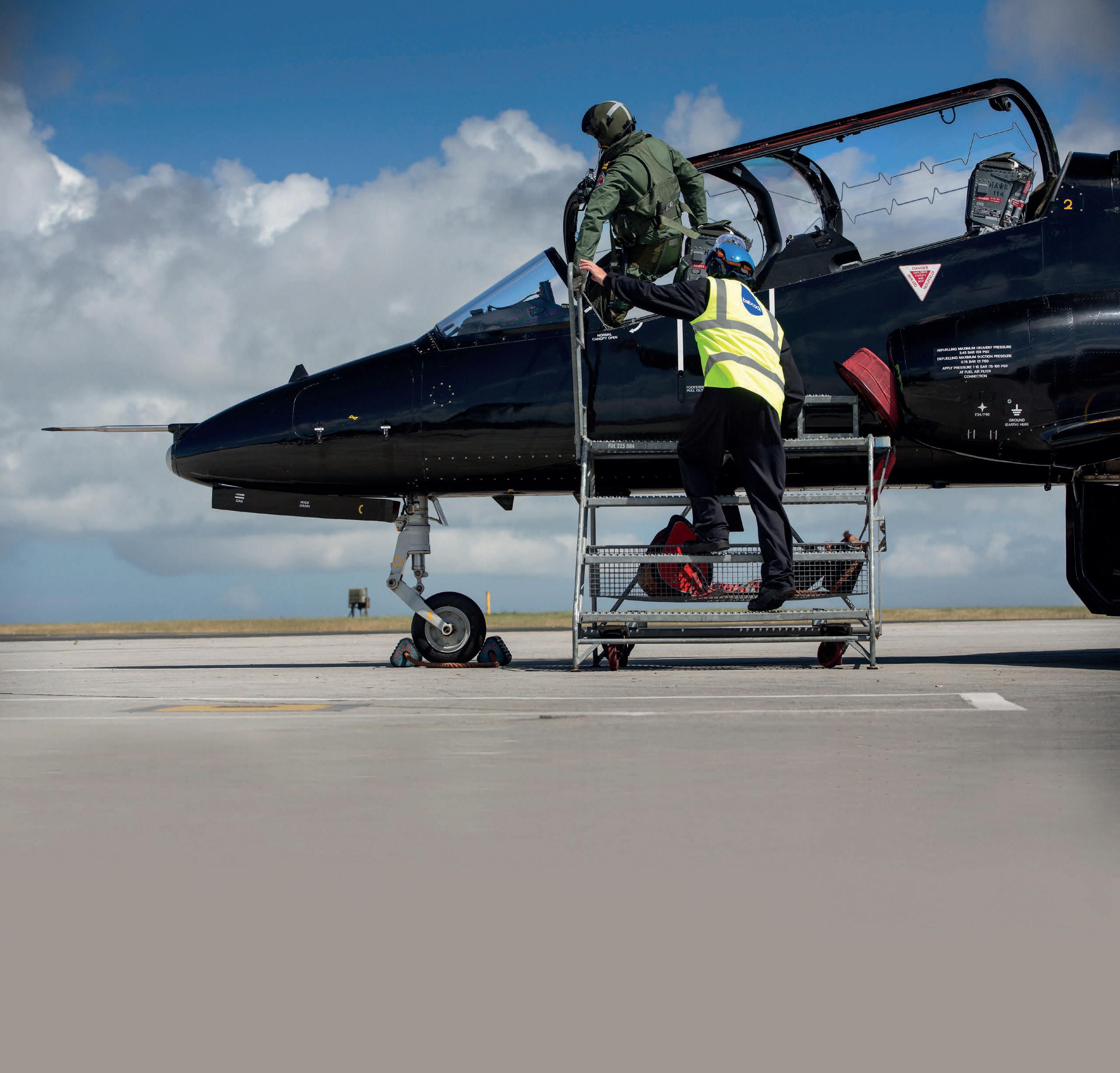
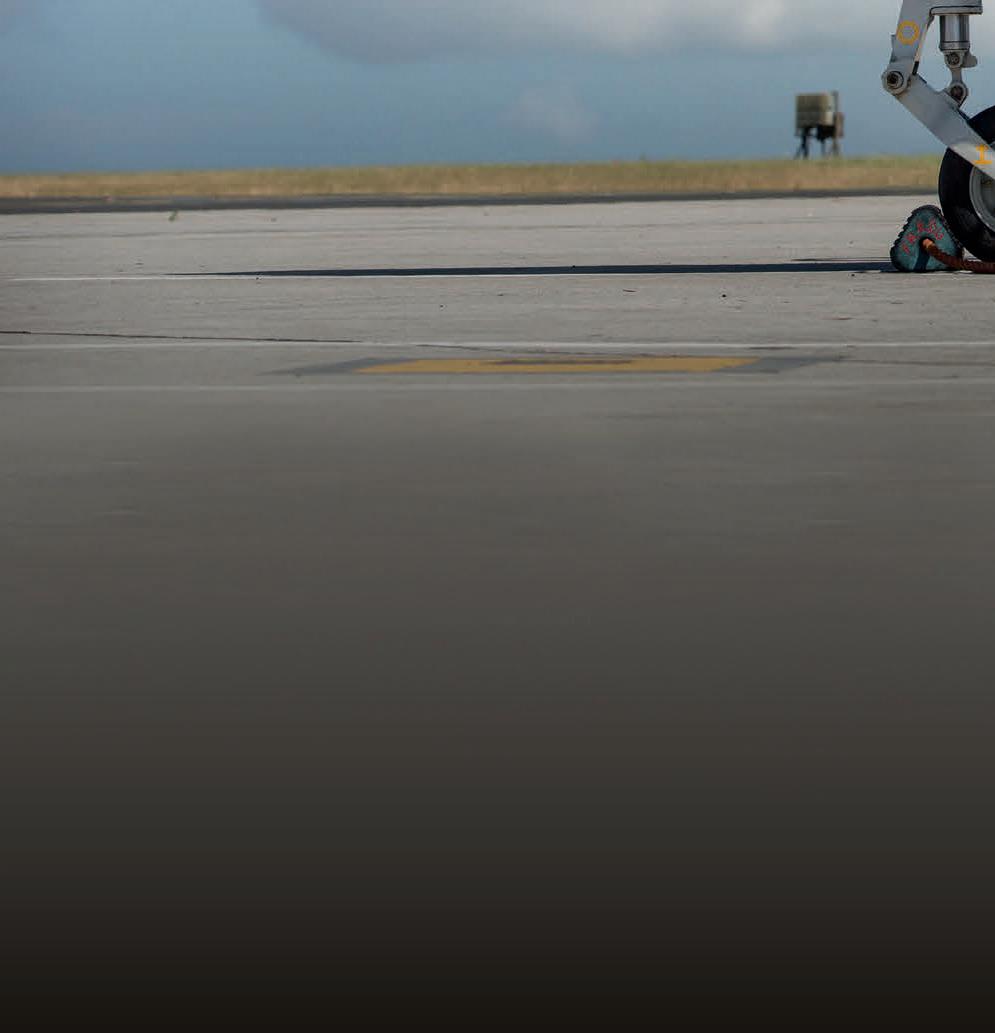



has con rmed the criticality of maintaining world-class air and space capabilities, to deter our adversaries and, if required, to defeat them. The Integrated Review Refresh highlighted the epoch-de ning challenges we are facing, with Russia trying to rede ne the international order through force, and China challenging us using constant competition to create a new world order aligned with its own grand design.
We must have the means to defend what is ours and protect what we value. Our air and space capabilities are central to the UK’s ability to do this, providing the agility, precision and lethality we need. Quick Reaction Alert forms the backbone of the United Kingdom’s Air Defence, in safeguarding the security of our airspace. We are investing in our infrastructure to further enhance our operational resilience. Our Homeland Defence is being strengthened through the development of space-based
capabilities and airborne early warning and control aircraft. And our P-8 Poseidons are integrating seamlessly with the Royal Navy to ensure maritime security, both above and below the surface.
The proliferation of long-range and high-speed missiles, combined with the rising threat from a spectrum of drones, also means that we will have to integrate our sensors and kinetic capabilities seamlessly to protect and defend our Critical National Infrastructure.
We must prepare to ght for control of the air, and the electromagnetic spectrum, to ensure that our forces, and those of our allies, retain their freedom to operate e ectively.
We are continuing to provide our Ukrainian allies with the precision capabilities they need to turn the tide of Russian aggression and restore their territorial integrity. The airbridge we have established is maintaining a steady stream of lethal and non-lethal aid, while also bringing Ukrainian recruits to the UK to be trained by our Armed Forces, before returning to
ght for their freedom. And we are training Ukrainian pilots to use the NATO aircraft that will be critical in guaranteeing their longer-term security and protection from attack.
The indivisibility of defence and security across the EuroAtlantic and Indo-Paci c Regions is highlighted by our international partnerships. Our AUKUS Trilateral Security Pact with Australia and the United States is facilitating cooperation across a spectrum of emerging technologies, including the development of future capabilities.
The Global Combat Air Programme with Italy and Japan is creating a world-leading sixth-generation combat air system to protect our security and prosperity in the decades ahead. And such relationships will open opportunities for further international collaboration. Our Joint Typhoon Squadron with Qatar serves as an example of how we can build shared capability through cooperation and integration with other leading air forces.
Our F-35 deployments are providing fth-generation air power to NATO and Joint Expeditionary Force partners, focused upon the collective defence of the North and High North. We are already planning the return of our Carrier Strike Group to the IndoPaci c. And we demonstrated the agility and responsiveness of our rapid global mobility in Sudan recently, from where thousands of British Nationals were airlifted to safety at very short notice.
We are implementing the lessons from Ukraine, noting that pervasive commercial low-earth communication satellites have been a critical capability in the ght for freedom. As a result, we are focusing on increasing collection and enhancing coherence through the Space Operations Centre. We are playing a leading role in the Combined Space Operations Alliance, with our FiveEyes partners, plus France and Germany. And our agreements with Australia, Japan and the Republic of Korea are increasing
vital cooperation with like-minded space-faring nations. The accelerated delivery of our National Space Operations Centre is providing important integration across Government and with Industry, and we are looking into the space skills of our future workforce with the development of the UK Space Academy.
As we consider and prepare for the future evolution of air and space power, we must focus upon the threats and opportunities aligned with developments in missile technologies, so that we can better defend the United Kingdom using integrated defence and utilise the advantages of longer-range and higher-speed precision strike capabilities. Our complex weapons strategy is playing a critical part in strengthening our resilience, while ensuring long-term cost avoidance. We can enhance our capabilities further using greater numbers of uncrewed and autonomous systems, while bene ting from their persistence, survivability and increased combat mass. We must focus upon the enhanced operational e ectiveness that will be generated from increased levels of human-machine teaming and the novel application of emerging technologies.
The UK aerospace sector has accounted for 83% of the UK’s defence exports over the past decade. Our involvement and long-term investment in international programmes, including Typhoon and F-35, highlight the enormous potential of aerospace to enhance UK prosperity, while augmenting our industrial resilience and strengthening our operational independence. And the Global Combat Air Programme will allow us to share the technological innovation and creative energy of Italy and Japan throughout this century and beyond. This spectrum of capabilities and initiatives highlights how the United Kingdom remains very much one of the world’s leading global air and space powers.
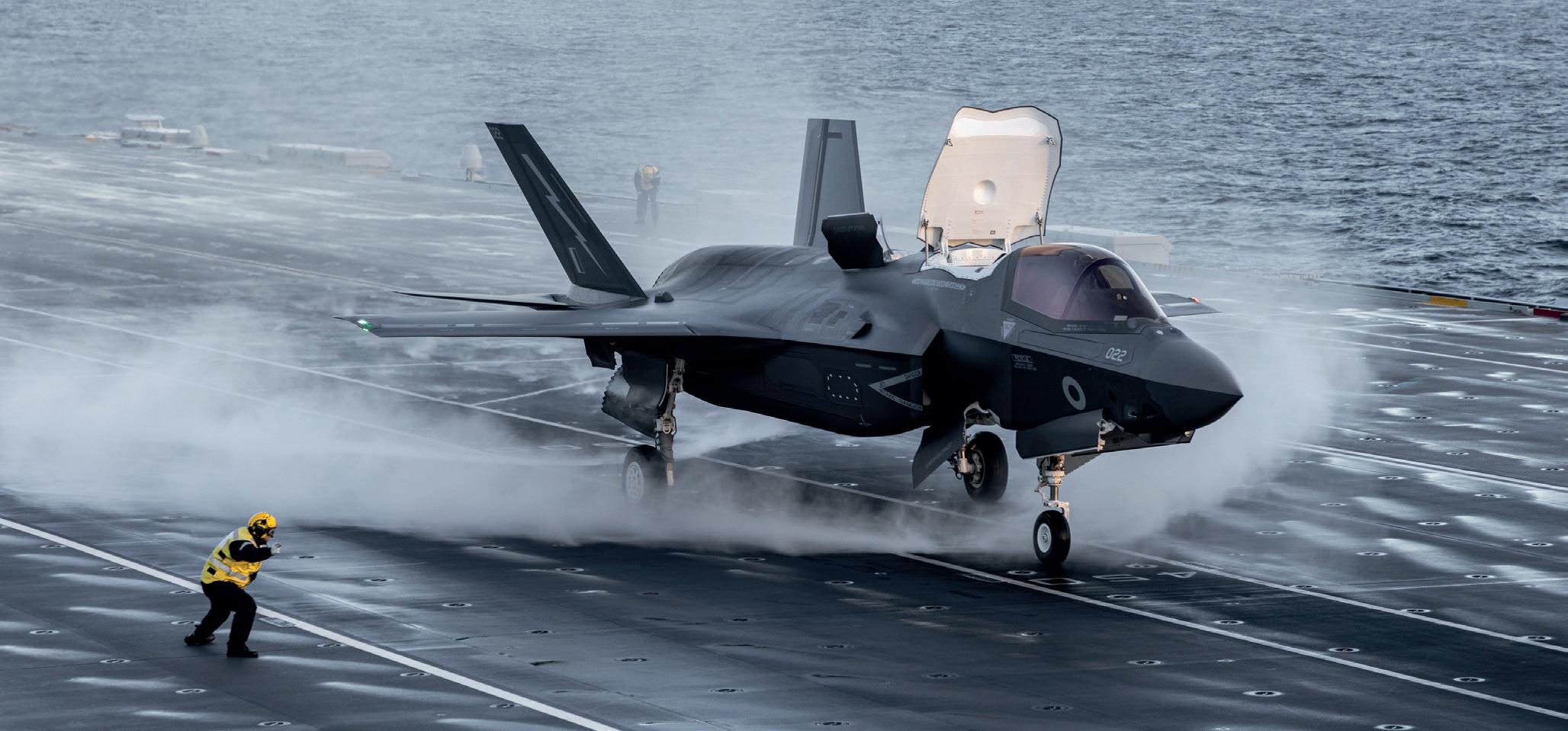






































































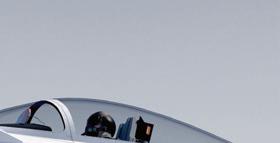




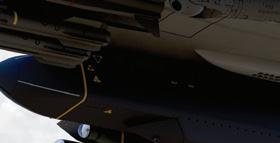
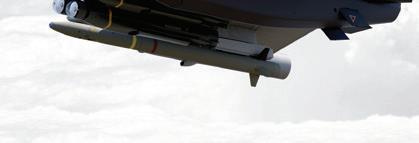


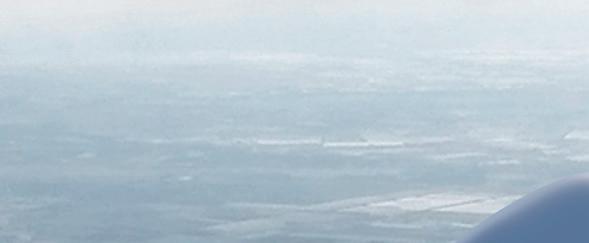



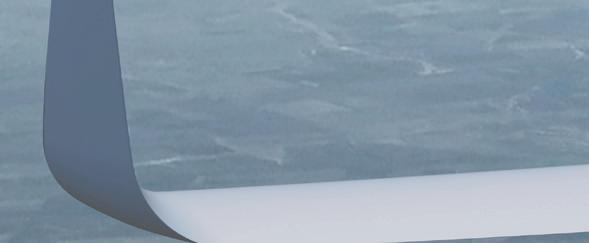
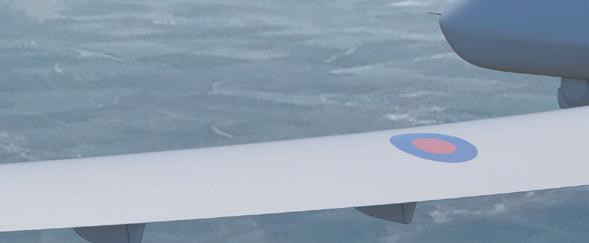

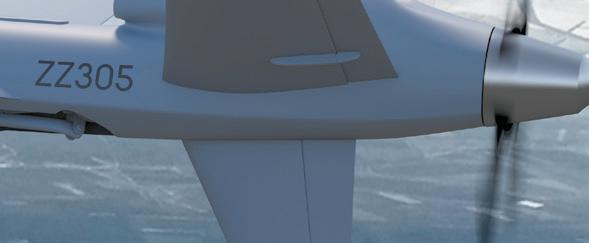






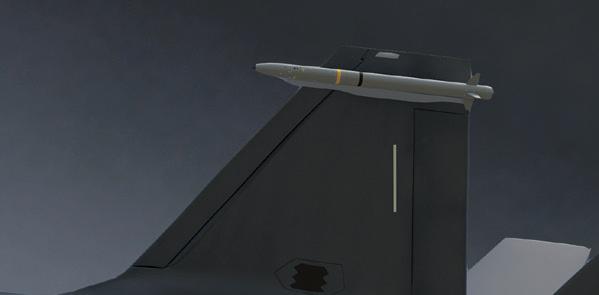


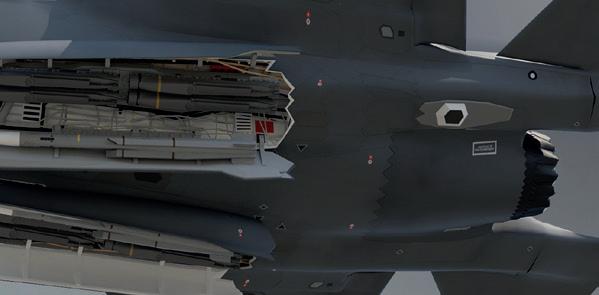













As we celebrate 15 years of Ascent, we are proud to deliver the UK’s Military Flying Training System – creating the next generation of military aircrew.


Ascent’s integrated training solutions bring together classroom teaching, simulators, virtual reality environments and live flying. Producing the adaptable aircrews our customers need, and making our trainees’ dreams a reality.

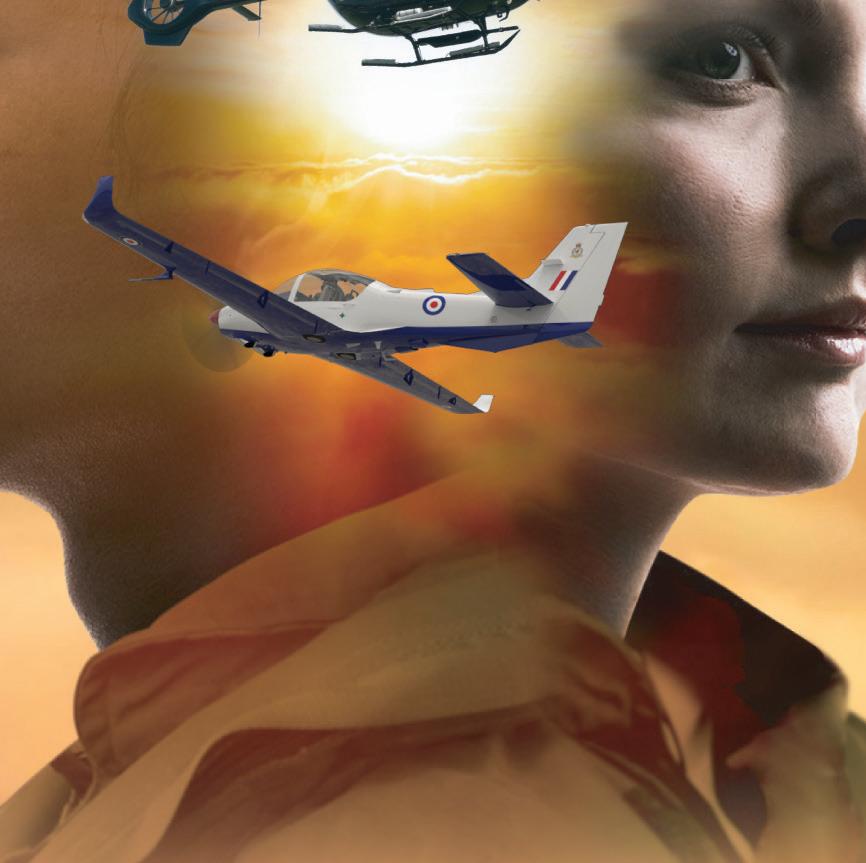

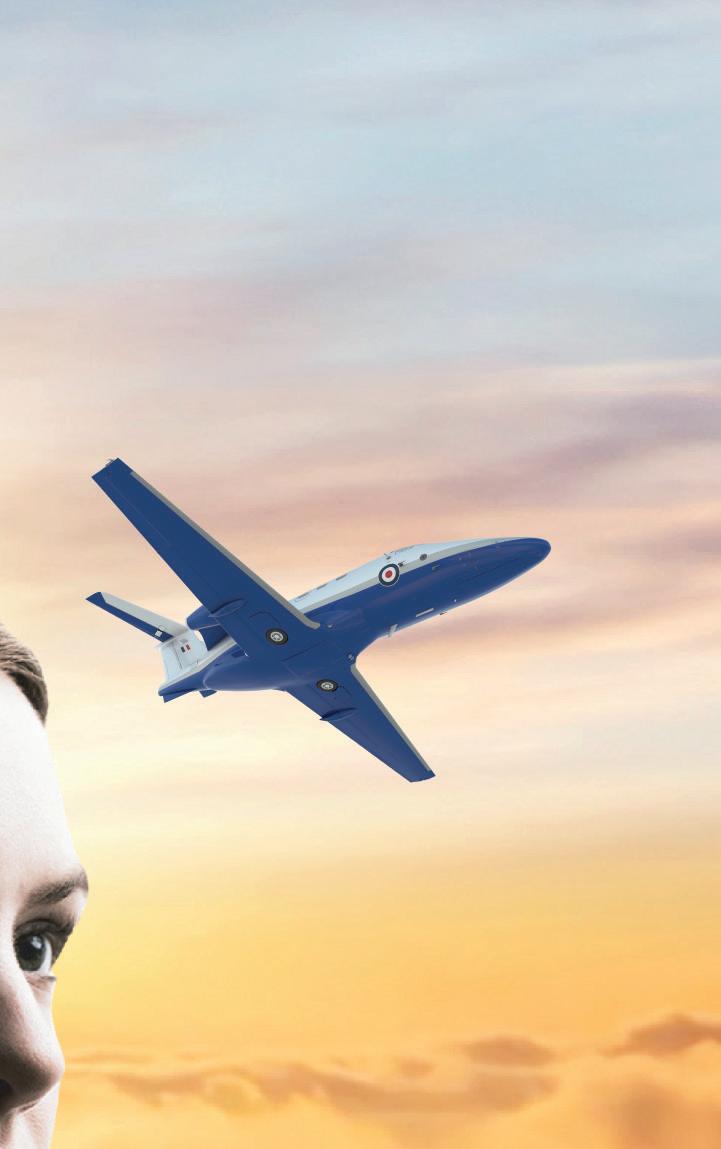

See the UKMFTS fleet of training aircraft and meet some of our current trainees at the Ascent showcase at:

@ascentflighttraining ascentflighttraining.com @ascentflight

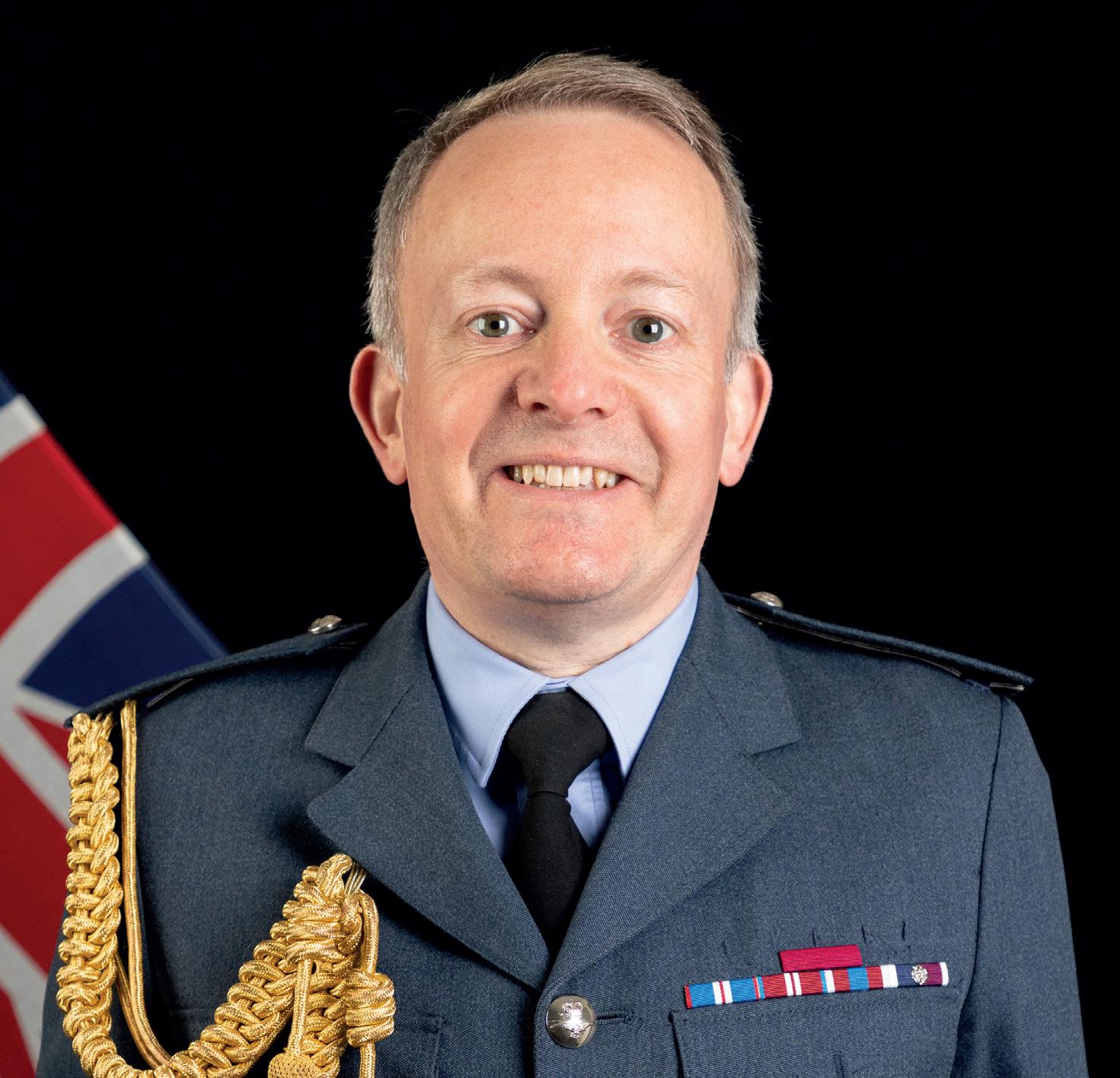 KCB ADC FREng, Chief of the Air Sta
KCB ADC FREng, Chief of the Air Sta
Welcome to this 2023 edition of Air & Space Power, the theme of which is ‘Global Air & Space Power’. As global air and space leaders, we are charged with defending our airspace and deterring aggression against our nations, our allies and our alliances. These roles are especially important as we witness states who seek to undermine the current international order by force, and others who are using constant competition to evolve the international system in their favour. This is why our collective actions going forward, including how e ectively we deter and defend against aggression and how actively we integrate and evolve our capabilities, will help to determine the relative peace, stability and prosperity of our nation and those of our allies.
As we examine the ongoing con ict in Ukraine, and Russia’s continuing aggression against its neighbouring sovereign state, we are continually evolving and re ning our perspectives of the value of air and space power. We must avoid the type of brutal, industrialised slaughter that is being prosecuted by Russia against our Ukrainian allies. We must do everything possible to ensure that Ukraine wins this bitter con ict and that unrelenting Russian aggression fails. And we must also do everything to ensure that such aggression will fail if it is ever used against us.
We will do this by focusing relentlessly on achieving our core mission of gaining, maintaining and sustaining control of the air, and of guaranteeing assured freedom of action for our capabilities across all of the operational domains, especially
the land and the sea. We will do this by integrating seamlessly across all operational domains and with our allies and partners, so that our collective capabilities are ampli ed, making any potential adversaries think twice before engaging us.
One thing is certain in our increasingly uncertain future –that the most agile and innovative air and space forces will win against our adversaries. So, in delivering global air and space power, we must focus upon increasing the agility of our air and space operations, by always staying ahead of our adversaries and e ectively complicating their strategic calculus.
We will do this, alongside our allies, using Agile Combat Employment and utilising dynamic deployments of our air, space and cyber capabilities across and around the globe. Our agility will be enhanced by evolving our global air and space capabilities using constant innovation in how we operate and ght. The increasing agility of our air and space forces will rely upon how e ective we are at adapting to and embracing the next generations of technological developments, so that we can incrementally enhance and
improve our current air and space capabilities, together with the supporting systems and personnel that operate them.
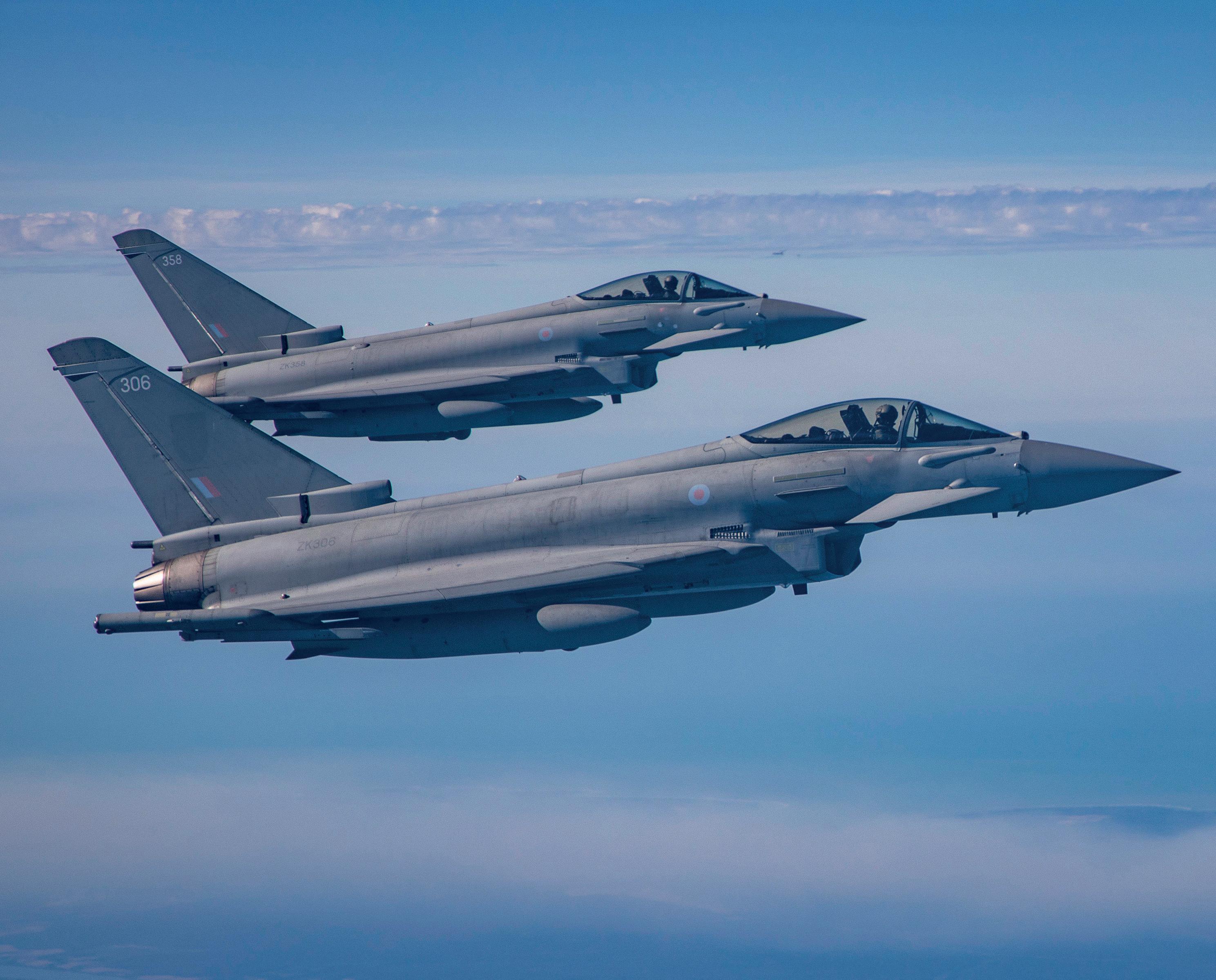
And most important will be the agility that we develop within the mindsets of our people, for many of the innovations, improvements and enhancements envisaged will only be successful due to the resourcefulness, resilience and mental agility of our aviators. This is why our focus on our people, their skills and the sustainability of our operations is so vital to our future success.
I am especially thankful to my fellow air chiefs from Italy, Japan and the United States for their contributions to this key air and space power publication. These highlight the signi cant value of our strategic partnerships in developing and delivering air and space power globally, which I am certain will endure throughout this century and beyond.
I hope that you enjoy this comprehensive and thoughtprovoking spectrum of articles from our aviators, senior civil servants and aerospace industry leaders. These highlight that developing and delivering world-class and world-beating air and space capabilities will only be achieved by working together as one team, cohesively and collaboratively, to protect what we value, using global air and space power.










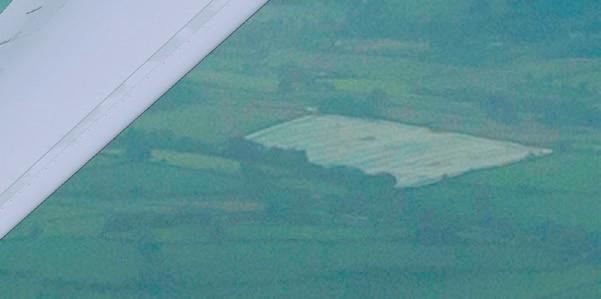





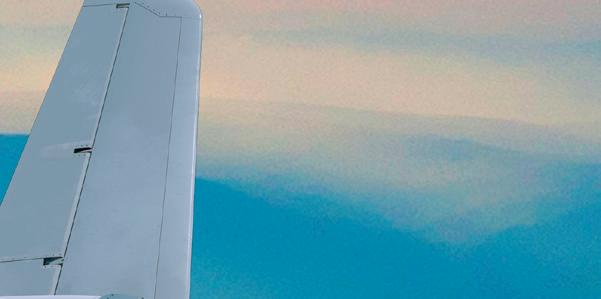


Leveraging the United Kingdom’s world-class defence and aerospace capabilities, the RAF’s Protector RG Mk1 will provide unmatched awareness and multi-domain integration. Together, we make Protector the most advanced and versatile remotely piloted aircraft system ever built.
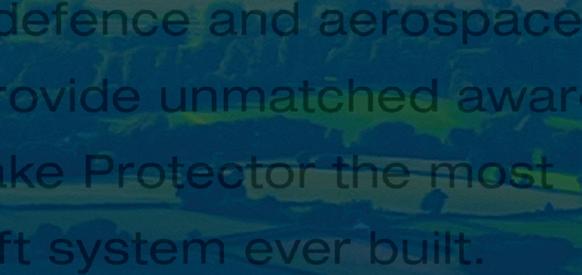
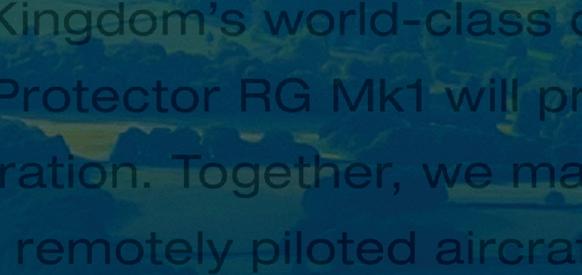
















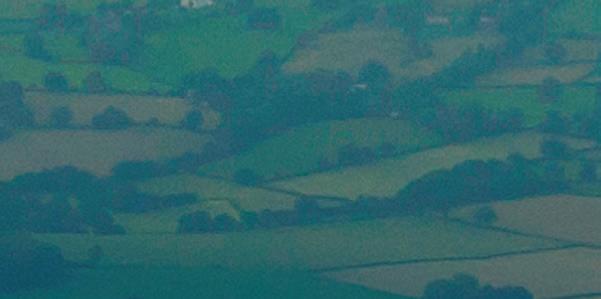



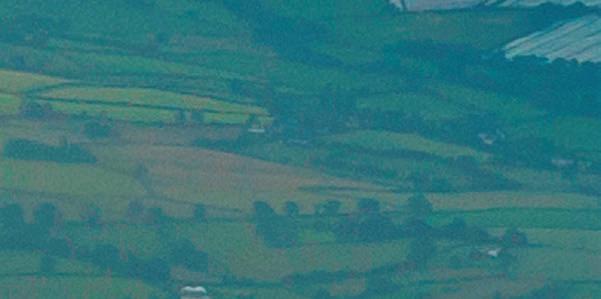



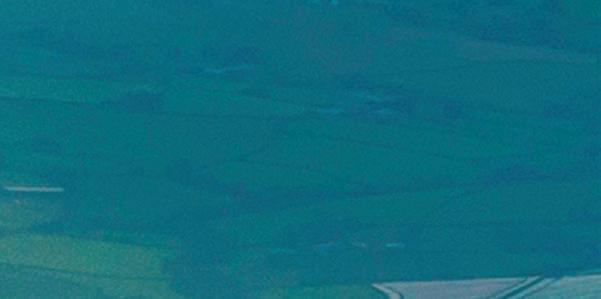

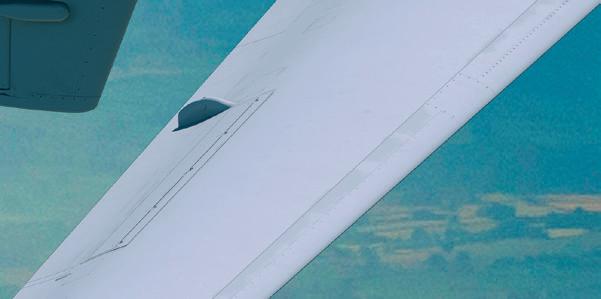


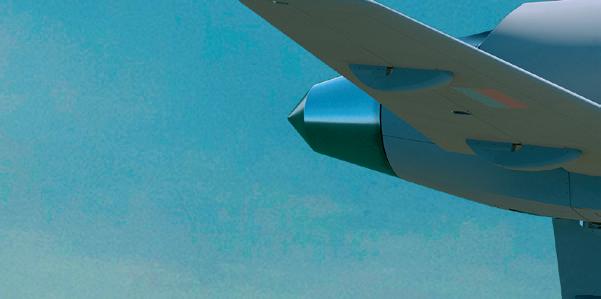






Supporting the UK Government’s Global Britain vision requires a military capability that is equipped, sta ed and trained to operate, often at a moment’s notice, almost anywhere in the world. Even the most casual of observers cannot miss the fact that, when immediate action is required, it is almost always the RAF that is in the vanguard of that response – be it delivering actual repower, humanitarian aid or evacuating those in danger.
The ability to step up to the mark instantly to whatever the task may be re ects a constant renewal and refocusing of air and space power. Air Marshal Harv Smyth reveals how this is achieved and the extent of this activity over the past year. Crucially, he highlights that a global capability requires a global network of allies, partners, suppliers, supporters and hosts. It also necessitates an ability to protect and sustain forces while on global operations – hence the RAF’s Global Enablement concept, which is expertly explained by Group Captain Jason Thompson in his piece on Agile Combat Employment, backed up by his namesake, Air Commodore Jamie Thompson, in his article on the reorganisation of the RAF Force Protection forces into a single ‘Global Enablement Organisation’.
Perhaps the most headline-grabbing activities with which the UK and, with it, the RAF have been associated over the past year or so are the AUKUS Trilateral Security Pact and the GCAP collaborative agreement. Air Vice-Marshal Simon Edwards reveals a far greater scope to the AUKUS agreement than is commonly expressed. Pillar 2 will see Australia, the UK and the
US collaborate on the vital emerging technologies of arti cial intelligence, cybersecurity and quantum computing. Mastery over these vital technologies will almost certainly represent the backbone of the RAF’s future ability to project global capabilities.
More recently, the signing of an agreement to design a sixth-generation ghter aircraft with Italy and Japan marks an astonishing milestone.
Having been established two years ago in April 2021, the UK’s RAFled Space Command continues to go from strength to strength, with over 500 sta members in place across the three armed services, industry and the civil service. Its Commander, Air ViceMarshal Paul Godfrey, highlights the growing responsibilities it is incorporating into its structure and its aspirations for the future.
Another new entrant into the RAF’s ranks is the Chief Digital Information O cer, Dr Arif Mustafa, who has been tasked with overseeing and implementing the digital transformation strategy that must provide the RAF with next-generation technologies and capabilities. This task will inevitably be reliant on an e ective cybersecurity infrastructure and capability, which is superbly explained by Air Vice-Marshal Tim Neal-Hopes.
As ever, we are indebted to those serving in the RAF, industry and elsewhere who give up their time to support this key RAF Air and Space Power publication. I have named but a few of them. I would also like to extend our gratitude to the Air Chiefs of Italy, Japan and the US, who have also contributed to this year’s issue.









The demands of military aviation in the 21st century leave no room for compromise – or outdated solutions. With cutting-edge technology and unrivalled build quality, the EJ200, installed in the Eurofighter Typhoon, has proven time and again to be the best engine in its class. To find out more about our market-leading design and unique maintenance concept, visit us at www.eurojet.de
The EJ200: Why would you want anything less?
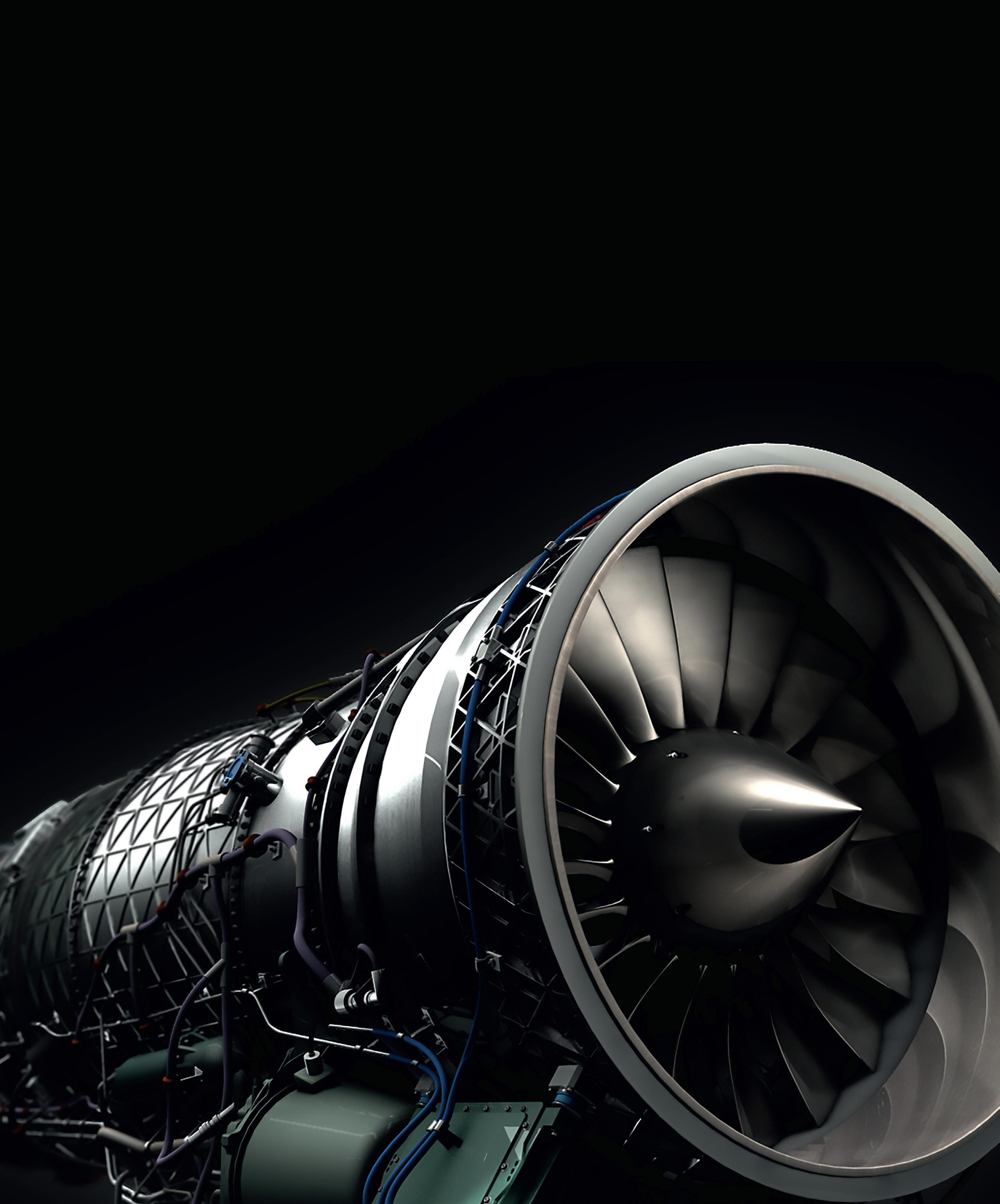
The United States does not ght alone. We cannot deter alone or succeed alone. These truths are not new or novel, nor are they subject to doubt or change. What is changing, however – by necessity – is what ‘ ghting together, deterring together, succeeding together’ means in an age of strategic competition and multi-domain con ict encompassing cyber and space.
The successful practices of the past must adapt to meet the emerging threats and challenges in the Indo-Paci c and around the world. In short, we must integrate. Our alliances, cooperative agreements and partnerships must be modernised with increasing collaboration.
To succeed, we must innovate and accelerate, and we must do it together.
What does this mean? It means our e orts must be integrated by design, for one.
It means emphasising collective ‘capabilities’ along with raw ‘capacity’ to nd ways of merging systems, equipment, personnel and doctrines across all domains like never before. It means dictating conditions, so the totality of our combined forces present so many potential actions from so many avenues and domains, and with breathtaking speed, that no competitor can expect advantage or success. It’s a tall order, but I am optimistic.
One reason is the health of our alliances and partnerships, as well as the enduring cooperation and bond between the U.S. and United Kingdom.

NATO remains the standard by which alliances are measured. That truth has been validated – even strengthened –in the face of Russia’s brazen invasion of Ukraine. The same is true for our partnership with the United Kingdom.
Each of our nation’s air forces play an essential and instrumental part in maintaining – and enforcing, when necessary – the global rule of law and providing the backbone to our alliances and partnerships. By locking arms and working together
need to start with that approach at the beginning, versus building from our individual perspectives, then trying to gure out how we bring our allies and partners in. We are working hard across the U.S. Air Force to achieve this goal. While we have more to do, we can also point to progress. Our collaboration with Australia and the United Kingdom in developing the E-7A battle management, command-and-control aircraft is a good example of an ‘integrated by design’ opportunity. This e ort is predicated on a long-term partnership with the Royal Australian Air Force and the Royal Air Force based on sharing information and experiences, as well as personnel.
as many of our nations have for generations, we underwrite peace, global stability and deterrence.
To sustain this history and performance, however, we must adapt our forces, our alliances and our partnerships to meet the challenges of today and those of the future. This is the reason I stress ‘integrated by design’.
To be integrated by design, we need to start at the beginning with the ‘end’ in mind. If the goal is to be integrated with allies and partners as a combined and credible force, we
The Royal Air Force and U.S. Air Force have sent operators and maintainers to train, assess and be on hand as the Royal Australian Air Force carries out the latest E-7 upgrade. We are using data shared by Royal Air Force and Royal Australian Air Force testing to inform our own independent Air Force Operational Test and Evaluation Center assessments. Moreover, both the Royal Air Force and Royal Australian Air Force were invited to participate in the drafting of the U.S. Air Force’s Capability Development Document to help ensure that our path forward on this critical capability remains aligned. Another example is the F-35; designed by eight international partners, the fth-generation aircraft is the backbone of not only the U.S. Air Force, but 16 other nations ying
“To succeed, we must innovate and accelerate, and we must do it together”
a plane designed from the start to be interoperable with allies and partners.
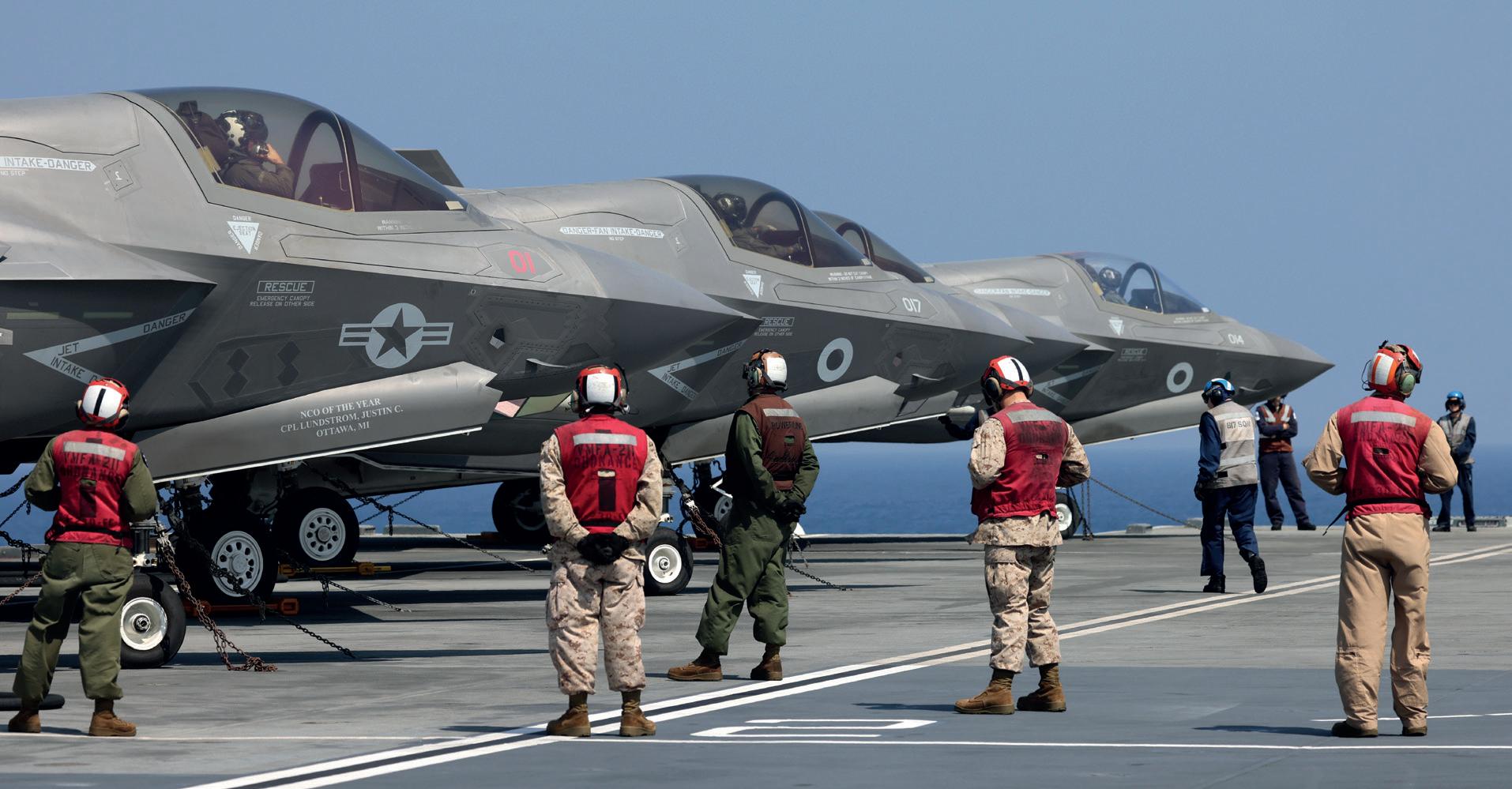
The experiences and bonds gained from our E-7 and F-35 e orts, along with others, allow us to rapidly integrate current and new technologies in response to future threats as they emerge across the spectrum of operations, and we will continue to develop future capabilities with allies and partners in mind. While doing so brings important capabilities to all our forces faster, and at less cost, and makes us more interoperable, being integrated by design with allies and partners isn’t just about platforms and hardware – just as important is the way we develop our people, policies and processes.
We are extending the presence of exchange o cers and liaison o cers to help cultivate strategic dialogue and approaches to future operational challenges and expanding collaboration on such things as war games. We are ensuring the U.S. Air Force’s contribution to Joint All Domain Command and Control, known as Advanced Battle Management System, which is designed to maximise the Joint Force’s capabilities, choices and
decision-making, is built on a common foundation and compatible with allies and partners. We are reviewing policies and processes that may unnecessarily restrict information sharing with allies and partners, and encouraging our members to share information more broadly.
directs the Triangle Institute for Security Studies and the Duke University Program in American Grand Strategy, correctly concluded in a 2021 analysis: “Alliances... help create a sense of permanence and shared purpose in key relationships; they provide forums for regular
It’s complicated work, but we have adapted before, and our alliances and partnerships have evolved time and again to successfully meet new challenges and crises, sometimes in the face of daunting odds.
As Hal Brands, the Henry A Kissinger Distinguished Professor of Global A airs at the Johns Hopkins School of Advanced International Studies, and Peter B Feaver, who
interaction and cooperation; they conduce to deeply institutionalised exchanges (of intelligence, personnel, and other assets) that insulate and perpetuate friendly associations even when political leaders clash.”
That was true during both World Wars, during the Cold War and in con icts since. We have adapted and strengthened, and remained e ective and resolute, each step along the way. We will once again.
“Our alliances and partnerships have evolved time and again to successfully meet new challenges and crises, sometimes in the face of daunting odds”
The UK’s senior air and space war ghter, Air Marshal Harv Smyth, tells Simon Michell how the RAF is sustaining high-end operations and activities across the globe – west to North America, east to Australia, up in the High North and down in the South Atlantic from beneath the waves all the way up to geostationary orbit
By
2025,the Queen Elizabethclass aircraft carriers will have two front-line F-35 squadrons at their disposal
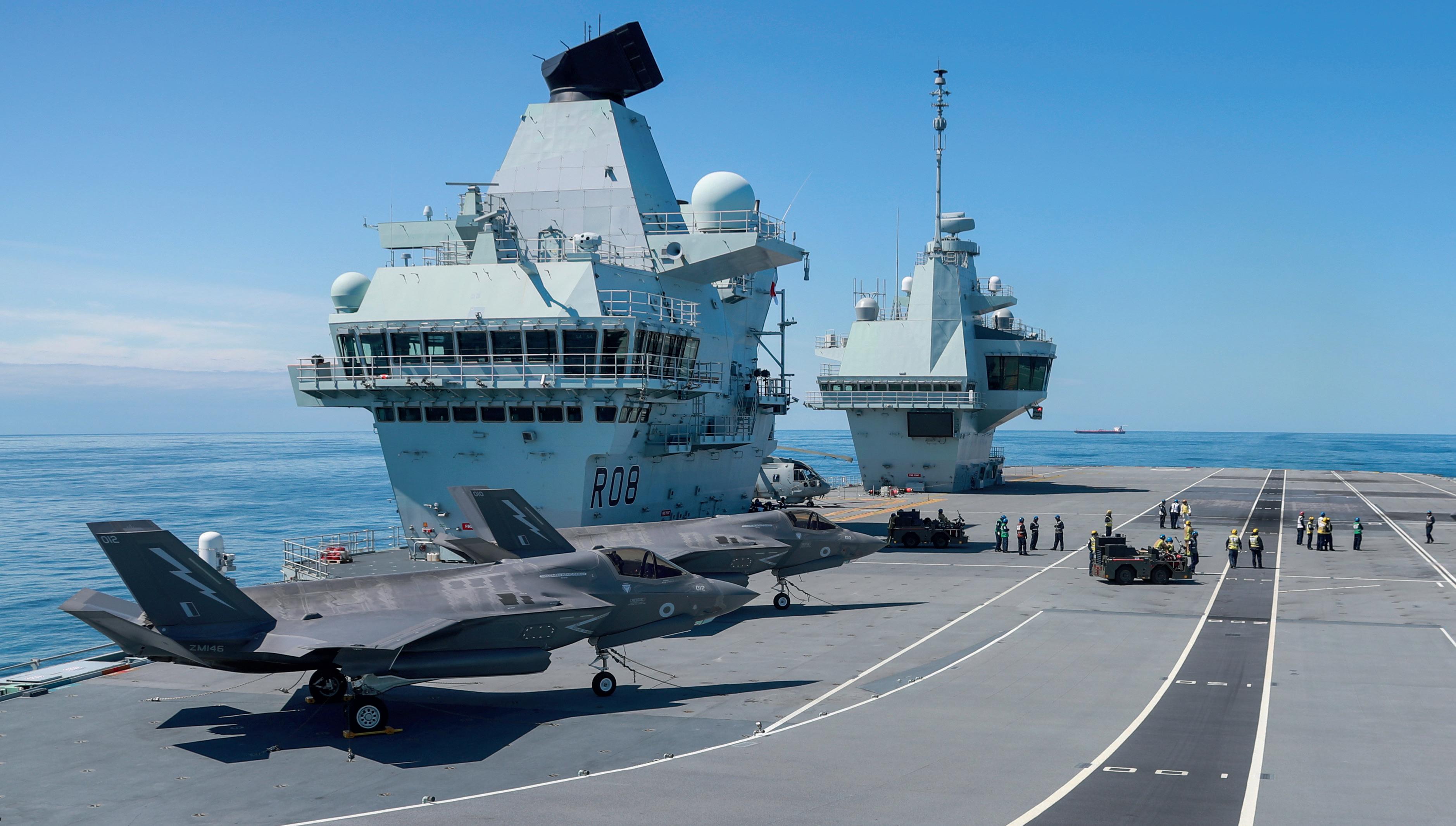
– 617 Squadron
‘The Dambusters’ and 809 NAS ‘The Immortals’ (PHOTO: MOD/ CROWN COPYRIGHT)
“As the RAF’s senior war ghter, my job is to generate the required air and space forces according to our Command Plan, and deliver the appropriate decisive operational e ect across all operating domains – air, land, sea, cyber and space – from beneath the sea all the way through the air domain into geostationary orbit,” explains the RAF’s Air & Space Commander (ASC), Air Marshal Harv Smyth. To make that task even more challenging, all the capabilities and personnel at his disposal have to be delivered on a global basis – across the Atlantic to North America and the Falkland Islands,
over the deserts of the Middle East, into the heart of Africa and out to the furthest shores of the Paci c to Australia on the other side of the world. These operations are not restricted to a single type of activity, far from it. According to Smyth, “They encompass everything from protecting the homeland and UK overseas territories, to ensuring the safety of RAF equipment and people wherever they are based – so-called ‘Global Enablement’ –as well as delivering air support to current operations, including in the oft forgotten Iraq and Syria.” His role also covers elding the F-35 Lightning Force, not just from RAF Marham and other land bases, but also
from the Queen Elizabeth-class aircraft carriers, in whichever sea or ocean they are tasked to sail.
Also sitting under his remit is the delivery of humanitarian aid to those in regions hit by natural disaster, such as the recent earthquakes in Türkiye and Syria. And, as if that were not enough of a challenge, he has within his bailiwick all RAF bases and Space Command, which he helped to establish two years ago in his previous job as Director Space within the Ministry of Defence, and which now boasts over 500 personnel from across all three Services, the Civil Service and Industry on its roster. Without doubt, there are few people in the UK Defence community quite as busy as ASC.
Things are getting busier. In February 2023, his Air O cer Commanding (AOC) Number 11 Group, took over operational control for air activities based in the Middle East; these used to be run by the Chief of Joint Operations (CJO) out of Permanent Joint Headquarters (PJHQ) in Northwood, North London. This transfer of duties has been implemented to free up the CJO and PJHQ to concentrate on the ‘Big Picture’, while ASC and 11 Group can focus on what they are better suited to – managing and sustaining day-to-day activities – or what Smyth calls “getting down into the weeds of the implementation of air and space power.”
Of all these taskings, Smyth is quick to point out that his overriding priority is the defence of UK homeland and sovereign territory, wherever that may be. This is not just maintaining a Quick Reaction Alert (QRA) force of Typhoon jets at RAF Coningsby and Lossiemouth to be ready to deter Russian longrange bombers and rogue commercial airliners all day every day, it is also safeguarding UK critical national infrastructure such as undersea electricity and communications cables and gas pipelines, a role taken forward magni cently by the RAF’s new P-8A Poseidon maritime patrol force. ASC’s Poseidons are experts at hunting adversary submarines, alongside ensuring the nation’s continuous at sea deterrent (CASD) is not interfered with.
Smyth points out that, in essence, the defence of the UK is inextricably linked to the NATO Alliance and the defence of the transatlantic community, and so much of this work is a joint e ort. Testament to this axiom is the UK’s enthusiasm for partnerships. Beyond NATO, the RAF plays a leading role in the Joint Expeditionary Force comprising 10 nations from Scandinavia and the Baltics alongside Denmark and the Netherlands. The UK is also a major player in the Five Eyes group of Australia, Canada, New Zealand, the UK and the US, the origins of which predate NATO. In 2014, Germany and France joined a Five Eyes grouping to create the CSpO (Combined
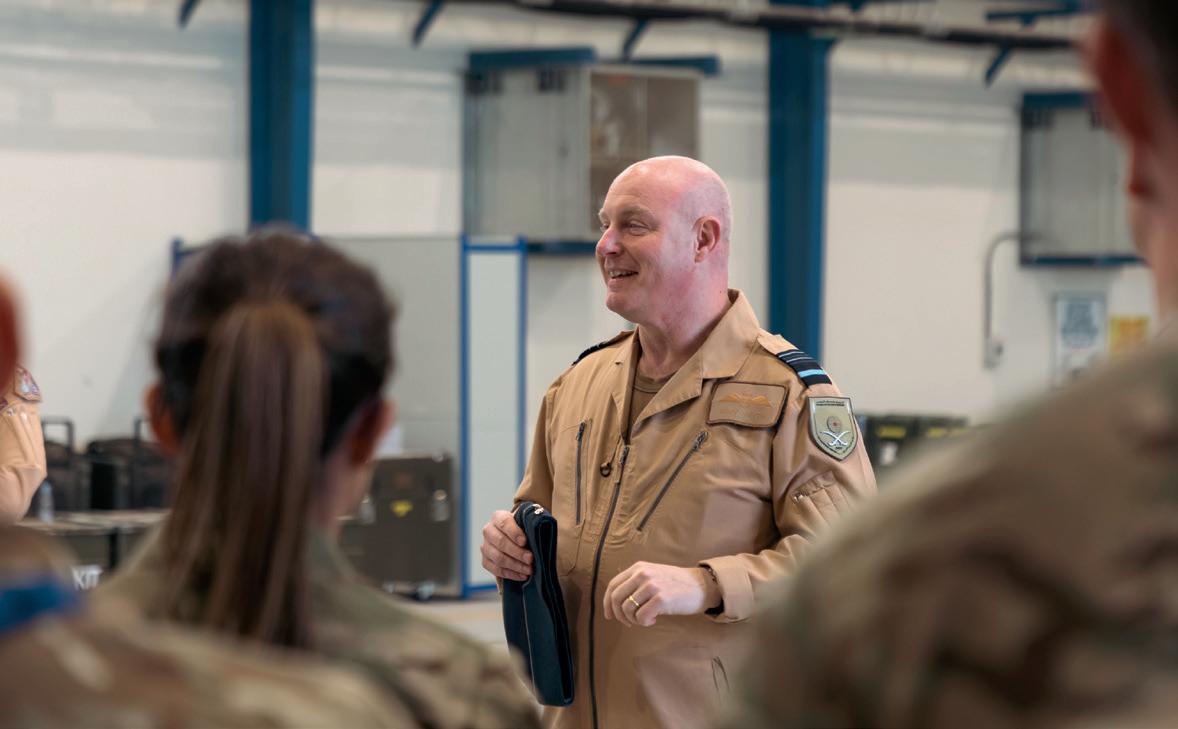
Space Operations) initiative. This group keeps an extremely close eye on what is happening in space and is very active at the United Nations to reign back irresponsible behaviours. This work is vital to the security of the UK, as the protection of the country’s space-based assets is paramount, “Protecting a Skynet satellite in its geostationary orbit is every bit as important to this nation as protecting our aircraft carriers when they go on operations,” says Smyth.
Since independence, the relationship with Australia has always been very close and is getting strategically more important. Having been invited by the Royal Australian Air Force to participate in Exercise Pitch Black in the summer of 2022, Typhoons from 6 Squadron left RAF Akrotiri, accompanied by a Voyager air-to-air refueller and an A400M Atlas. After a successful visit, they returned home via India and Malaysia, undertaking a soft power engagement role to cement ties with those important partners in the Far East.
Pitch Black came on the back of the enhanced Trilateral Security Pact, AUKUS, announced in September 2021, that created a collaborative partnership between Australia, the UK and the US to supply Australia with a nuclear-powered submarine capability. “Pillar 2 of AUKUS will see us collaborate on areas such as arti cial intelligence, cybersecurity, electronic warfare, hypersonics and quantum computing,” Smyth highlights.
A quick scroll down Smyth’s Twitter feed (@HarvSmyth) highlights just how busy 2023 has been so far. The January Red Flag exercise in the US, which Smyth describes as “the hardest three weeks of ying any air crew will endure”, was extensively redesigned to enable the participants to simulate a war in the Paci c, the key factor being preparing for what ASC refers to as “the tyranny of distance”. By combining the air training ranges from Utah
to the west coast of the US, and projecting them a further 600 miles into the Paci c Ocean, it was possible to replicate the types of onerous 12-hour missions that a con ict in the Paci c would demand.
The Middle East has also seen plenty of spectacular activity, thanks in no small part to RAF Akrotiri on Cyprus, which serves as a hub for most of the activity in the region, and the Al Udeid base in Qatar, which houses 83 Expeditionary Air Group. Over the space of a week in February, Smyth visited Al Minhad Air Base in the UAE to drop in on the RAF’s 906 Expeditionary Air Wing, which had just played a critical role in enabling humanitarian aid delivery to earthquake victims in Türkiye and Syria. From there he jumped to Thumrait Air Base in Oman to be briefed on Exercise Magic Carpet, in which Typhoons and Voyagers were taking part. Next stop was Dhahran Air Base in Saudi Arabia to see how more RAF Typhoons were getting on as part of Exercise Spears of Victory. Although this was not quite as large or complex as the benchmark Exercise Red Flag, Smyth is very e usive with his compliments for this training module and foresees a time when it might become comparable.
Perhaps no other geopolitical event highlights ASC’s role and signi cance for UK Defence better than the UK’s response to the illegal invasion of Ukraine by Russia. Almost every aspect of Smyth’s capability portfolio has been involved in the e ort to shore up Ukraine’s ability to resist Russian forces and their Wagner Group paramilitaries. The Air Mobility Force out of RAF Brize Norton has ferried tens of thousands of rounds of ammunition to Ukraine, as well as equipment – helmets, body armour, night vision goggles and medical supplies. On their return journeys, these aircraft have brought back thousands
of Ukrainian recruits for training. The RAF Regiment has then helped to train these recruits, alongside their counterparts from the British Army. Once they have completed their training, the Air Mobility Force takes them back to Ukraine to join the ght.
Furthermore, the RAF Combat Air Force has patrolled NATO’s eastern borders as far down as the Black Sea. It should also not be forgotten that RAF reconnaissance and surveillance aircraft continue to patrol the skies adjacent to Ukraine, gathering vital intelligence that is then delivered to the Ukrainian forces. RAF intelligence analysts have been working at out, turning the “beeps and squeaks” that the RC-135W Rivet Joint electronic surveillance aircraft have swept up into actionable intelligence. “Make no mistake about it, these people are the silent heroes. In a world where information is key, our ISTAR Force is generating the information dominance that is such a game-changer. I take my hat o to them,” says Smyth.
When asked what value he thinks all this activity and capability adds to global security and stability, Smyth insists that it is not just hard power that makes a di erence – soft power has an equal role to play. “The convening power of the RAF is something to be immensely proud of,” he says. The Chief of the Air Sta ’s conference in London is an exemplar of this: last year, some 67 air and space chiefs from around the world were in attendance. And, in what was a global rst, more than 30 of them took to the stage at the Institution of Engineering and Technology to sign a declaration of intent on climate change collaboration to ensure that military aviators make a decisive contribution to ensuring the world remains a place in which humans can prosper. It is ASC’s job to sustain and maintain the RAF operations that will ensure they can do so in a secure and stable world.
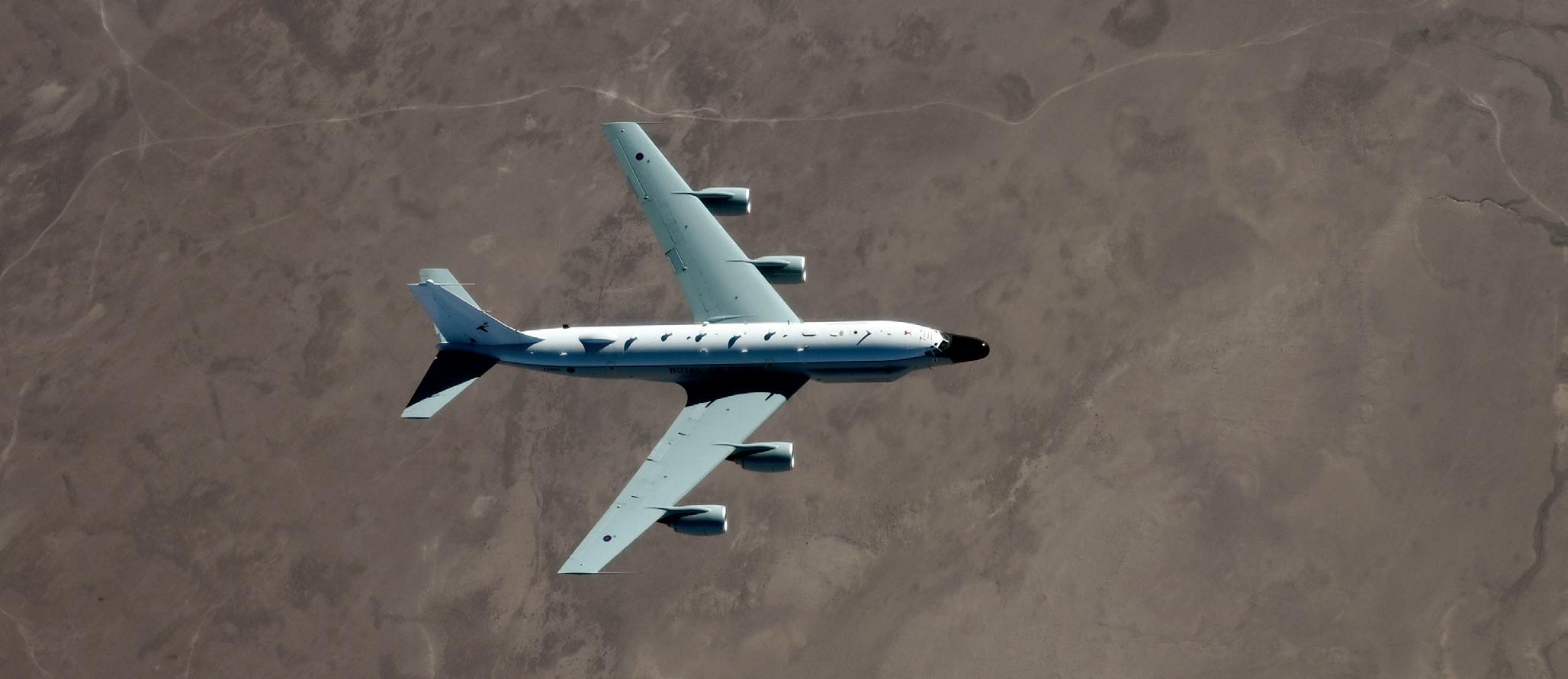
universe of information can be collected, analysed and acted upon will hold a key to the e ective projection of force across domains that are becoming increasingly interconnected. E orts such as the UK’s Multi Domain Integration (MDI) are vital to ensuring our war ghters have the information they need to achieve their goals.
How can we move MDI from concept to reality?
Nick Cha ey Chief Executive UK, Europe and Middle East, Northrop Grumman Corporation
What lessons can military planners take from what we have seen in the Ukraine war?
I think one the biggest lessons we can take from Ukraine’s valiant defence of their country has been the impact of leveraging Information Advantage in the battlespace, and the advantages this can be bring when leveraged within a digital- rst mindset.
How Ukraine has achieved this has been remarkable. Since the invasion began last year, they have exploited the ubiquity of open-source information in a manner never before seen in con ict, alongside a proliferation of low-cost commercial platforms, like consumer-grade drones as information sources. The digital devices from which tactical information can be gleaned are in the hands of almost everyone in and around the battle eld, generating a constant ow of data –intentional and unintentional, accurate and false, from friends and from foes.
As allied nations look to future con icts, the myriad ways this new
What makes MDI such an essential pillar of future war ghting?
MDI is about developing a more holistic approach to meeting threats in the future battlespace. Intelligently connecting sensors to fuse information and then exploit the conclusions e ciently and e ectively through the optimal e ectors across every domain will result in a system of systems that can accelerate responsiveness and reduce costs without hindering the tactical exibility of the commander.
It will provide a new level of Information Advantage, allowing leaders to make smarter decisions, faster, and helping to keep our war ghters safe. It will also enable true interoperability across allies, by joining up of forces through the ability to seamlessly share information and capabilities.
MDI is about more than just making systems talk to each other. It enables a new way of operating across every area of the armed forces, from people and processes to procurement. It leverages the adoption of open modular architectures, to ensure that every new platform/system can be integrated into a common operating picture.
We think there is a clear path to accelerating the UK’s MDI position through taking advantage of tested interoperable capabilities that can help the UK leapfrog the challenges it faces today. Investment in proven, truly open, multi-domain architectures can provide the UK not just with a battle-ready system, but the framework and capability to proliferate this approach to other programmes.
A good example of this approach in action is IBCS: NG’s integrated air and missile defence battle command system, which recently began full rate production for the U.S. Army. As a fully open, modular and softwarede ned capability, it is the U.S. Army’s Programme of Record and serves as their chief contribution to JADC2.
More than just a smart piece of software, the system’s resilient, open, modular, scalable architecture is foundational to deploying a truly integrated network of all available assets in the battlespace, regardless of source, service or domain. It enables the e cient and a ordable integration of current and future systems, including assets deployed over IP-enabled networks, counter-UAS systems, fourth- and fth-generation aircraft, space-based sensors and more.
A digital- rst, software-de ned mindset empowers rapid and, crucially, e cient integration of new capabilities, regardless of service or manufacturer. It’s an approach that should de ne the future of defence capability and procurement for the 21st century.
Air Marshal Johnny Stringer, Deputy Commander of Allied Air Command at Ramstein Airbase, Germany, reveals how his command ensures the security of NATO territory, from the High North to southern Italy and from the Azores to eastern Türkiye

The unprovoked and illegal invasion of sovereign Ukraine by Putin’s Russia has upended the post-Cold War security consensus in Europe. NATO Allied Air Command, and the national air forces of Alliance members, have been on point since 24 February 2022 to keep our nations safe. What has that looked like, and how might it evolve in the future?
The most obvious manifestation of enhanced vigilance activities in the air domain were the 24/7 combat air patrols (CAPs) own on NATO’s eastern
ank at the start of the Russian invasion. Fighter aircraft from across the Alliance were operating from both forward and home bases, fully armed to ensure the defence of our airspace. Less obvious, but essential, were the air-refuelling tankers and airborne early warning (AEW) aircraft to keep them fuelled while on CAP, and to provide situational awareness to Alliance members and partners. The RAF has provided Typhoon and F-35B fast jets, either ying from home bases in the UK or deployed forward to other NATO nations, supported by Voyager tankers.
On the ground, forward-deployed surface-to-air missile (SAM) batteries provided additional defence and reassurance. The entire enterprise was and is commanded and controlled (C2’d) by the standing Air C2 footprint that protects NATO airspace across from northern Norway to Sicily, and from the Atlantic Ocean to eastern Türkiye – in total, 81 million sq km. This is NATINAMDS, or the NATO Integrated Air and Missile Defence System. And we continue to maintain enhanced, rotational deployments to deter Russian aggression and reassure our populations.
Our aircraft have also been at the heart of NATO’s intelligence collection to understand what is going on in and around Ukraine. For the RAF, our River Joint intelligence, surveillance and reconnaissance (ISR) aircraft have made a vital contribution. The RAF’s P-8 Poseidon maritime patrol aircraft have also own operational missions to help secure our seas, as well as our skies.
For the past three decades, NATO’s air and missile defence shield was orientated towards an air policing mission, ensuring the peacetime integrity of NATO airspace. Like much of the Alliance, the reduced threat allowed reduced investment: we have seen this manifest in many ways (including
the ex-military bases in continental Europe now much favoured by the burgeoning cut-price airline sector). The past 15 months have, thus, been instructive in many ways, with the geopolitical and the technological posing challenges that we had hoped had been consigned to history.
The nature of the threat has expanded and proliferated enormously in the space of a decade. We must now conceive of Integrated Air and Missile Defence (IAMD) as being one of our most challenging tasks: from weaponised commercial and one-way attack drones, through a multitude of cruise missiles launched from land, sea and the air, to hypersonic air-launched missiles, such as the AS-24 ‘Killjoy’. This last weapon is actually an air-launched ballistic missile, illustrating how the boundaries between IAMD and Ballistic Missile Defence (BMD) are becoming increasingly blurred. And with much of Russia’s tactical activity blunted by the heroic and imaginative Ukrainian Armed Forces, they have become more reliant on their stand-o missile systems.
How do we meet this ever-evolving and complex IAMD mission? We can see it through four elements. Firstly, we need the Capabilities
RAF Rivet Joint intelligence aircraft have been helping NATO monitor Russian activity in and around Ukraine
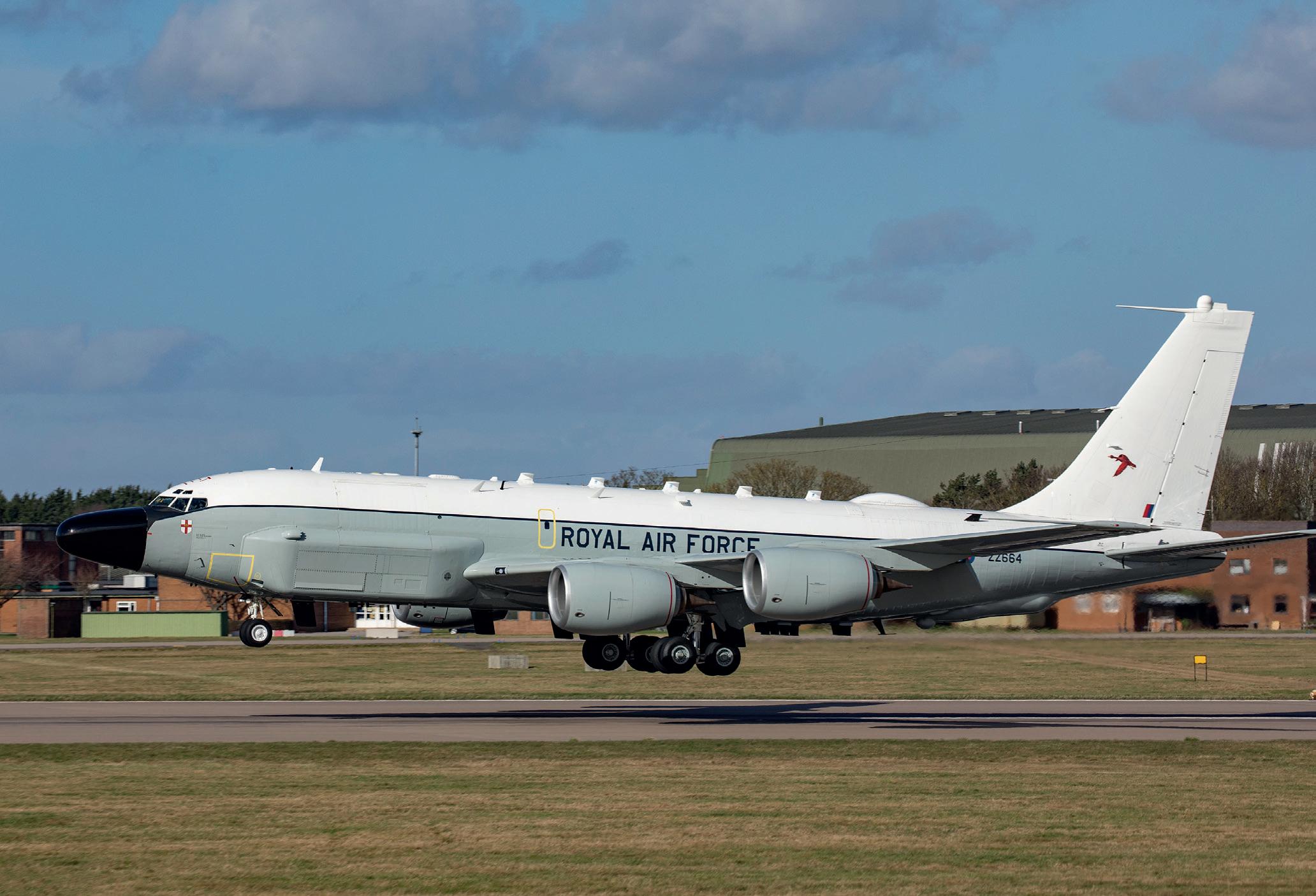
RAF Typhoon fast jets have been undertaking enhanced air patrolling of NATO’s eastern ank (PHOTO: MOD/ CROWN COPYRIGHT)
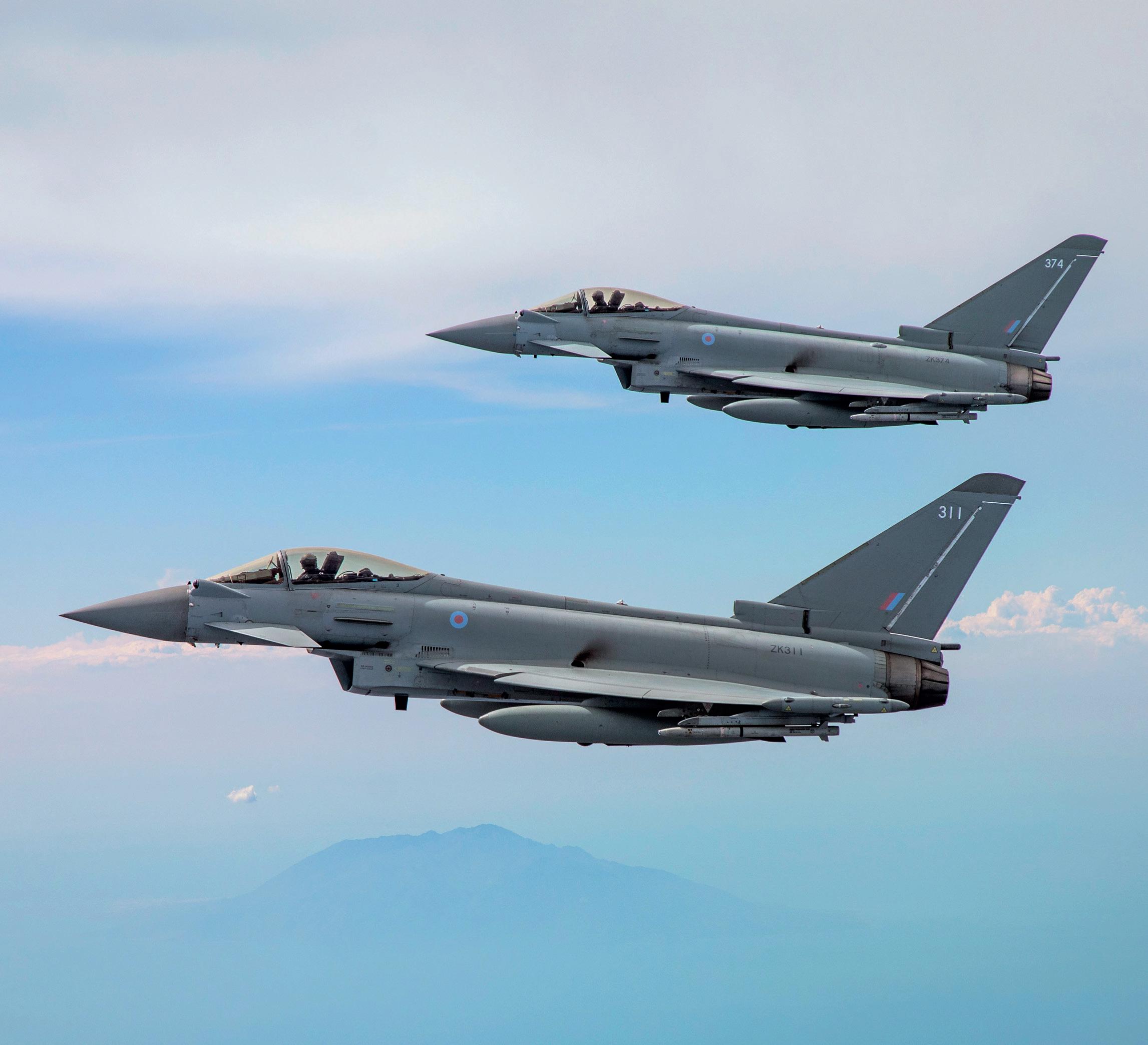
that allow us to detect (or sense) and engage any threat coming at us through the air domain; for BMD, this includes space too. The radars and other sensors that allow us to develop the highest-quality Recognised Air Picture will be augmented and enhanced by a variety of new equipment being elded by NATO’s air forces, and its surface-based air and missile defence units.
Secondly, we are evolving the overall IAMD Architecture: how we link bases, units, C2 centres, radars and platforms, and across all domains too –this not just the preserve of the Air Component. We need to understand, decide and act faster than we’ve been used to, and within an extremely complex operating environment. This then speaks to ensuring that our Authorities (or permissions) continue to evolve to match the threat; like many things, this is a political and policy issue, as well as a military one.
Finally, we must ensure that how we posture our forces is optimised against our adversaries. As noted above, there are signi cantly fewer bases (and aircraft and SAMs) than during the Cold War. We need to be basing our assets, our logistics and our people where they can be most e ective... and most survivable too. Accordingly, signi cant conceptual and practical e ort is being put into Agile Combat Employment across NATO’s air forces. This is (far) more than a back-to-thefuture reprise of Cold War operations – although there are many valuable lessons from that era – and elsewhere in this journal you’ll nd AVM Phil Robinson’s insights on this key topic.
For now, NATO Allied Air Command maintains its 24/7 watch over the skies of our 31 nations, deterring and reassuring, yet ready to engage at a moment’s notice – as we have for over 70 years.

What kind of support does BAE Systems provide to the RAF’s frontline eet?
BAE Systems has a long history of providing support to the RAF’s frontline. Today, we support both Typhoon and F-35 eets, where our team ensure eets are ready when and where they are needed, whether that is to deliver on operations or securing the skies with Quick Reaction Alert. Maintaining operational readiness, often in complex and challenging environments, is key and we understand operational e ectiveness not only relies on the availability of equipment, but on welltrained people with the capability to operate and support the frontline.
How has BAE Systems played a part in supporting the UK’s response to heightened tensions in Eastern Europe?
The RAF’s Typhoon and F-35 eets have played a vital role in supporting NATO-led operations as part of the
response to the Russian aggression seen in Ukraine. Our teams at RAF Coningsby, RAF Lossiemouth and RAF Marham have been at the heart of the team that has responded to the ramp-up in operational tempo. Particularly across RAF Lossiemouth and RAF Coningsby, our teams have stood-up new maintenance capabilities to ensure the availability of the aircraft. We are proud of the way our people have brought their vast experience in fast-jet support to ensure Typhoon and F-35 continue to deliver as part of the NATO Alliance.
Our position at the centre of Typhoon’s development gives us a unique insight into the support and training requirements as the aircraft evolves and as we support the RAF and others transition to a sixth-generation
Training strategy, ensuring pilots are ready for the future battlespace. One example is the work we’re doing with leading innovative technology companies to create a collective training environment, enabling air, land, sea, space and cyber forces to plug in and train together. This knowledge will be essential as we work with the UK to determine the training requirements for Tempest.
What are you doing to prepare future support for Tempest?
We’re already looking at the support solutions that Tempest will demand and the increase of software capability that will be needed. We are also working alongside the RAF to use transformative technologies – from exo-skeletons to virtual reality, robotic ‘teammates’ and digital twinning – to meet the support demands of the future, as well as enhancing what we deliver now. The introduction of these
capability. Our support to the RAF Typhoon eet is underpinned by a long-term contract, the Typhoon Total Availability Enterprise (TyTAn), which is aimed at improving aircraft availability while reducing operating costs. This has generated £500m in savings, which have enabled further investment into additional capability development. Our pedigree on Hawk provides a solid foundation for our Next Generation
technologies can be used to reduce costs and improve the availability of the frontline forces, while improving safety.
As we develop the future support solutions we will need to consider how technology can help us to deliver capability and readiness at speed and lower cost, while developing the skills and knowledge to provide the right support for a complex sixth-generation combat aircraft such as Tempest.
“Our position at the centre of Typhoon’s development gives us a unique insight”
Air Marshal (Retd) Greg Bagwell, President of the Air & Space Power Association, explains how the war in Ukraine has reinforced the doctrine of air superiority and the value of investing in air power
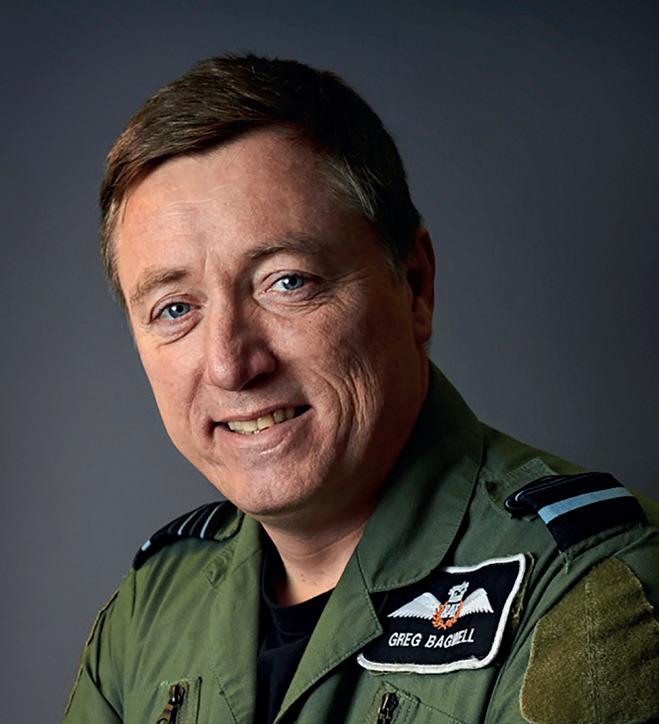
Some have heralded this war as a portent for future wars, but to what extent is this true? What is clear is that, while this duel continues at the strategic level, we have seen minimal operational or tactical e ect of air attacks on the battlefront. Here, brutal urban and trench warfare readily demonstrates how land ghting descends to the visceral without the decisive e ect of manoeuvre and joint res, and the almost absence of e ective air strikes.
to the systematic suppression and, ultimately, destruction of the enemy’s ability to compete both in the air and, increasingly, from the ground.
The Russian invasion of Ukraine is now well into its second year and Ukraine continues to defy the odds. Not least of Ukraine’s attributes is its heroic stoicism, but it has also become a master of information, deception and adoption. Of these, its adoption of a myriad of conventional equipment and, increasingly prominent, unfamiliar capability types, such as tactical drones, has been noteworthy. However, what has been most notable so far is the rather muted impact of air power on the con ict. This has been down to two reasons: the poor performance of the much larger and capable (on paper) Russian Air Force, and the prevalence of increasingly lethal ground-based air defence. In the absence of traditional dominant air power, drones and longer-range, faster missile attacks have become more commonplace. This has resulted in an aerial duel between these and the ground-based air defence systems of Ukraine –missile-on-drone and missile-onmissile. It has descended into a war of attrition in the air, as well as on the ground, one that has become a test of endurance of both will and munition reserves/manufacture.
The tactical, low-cost dronedelivered munitions have merely replaced or supplemented mortar or short-range artillery, rather than air power. It has become a highly e ective tactical tool, but one that is only truly e ective in a static, attritional stalemate, rather than one of fastpaced manoeuvre and o ensive action.
So, rather than demonstrate the end of air ghting as we know it, this con ict reinforces the doctrine of air superiority, as to ght without it is far more costly in lives, resources and, ultimately, the ability to triumph. One only has to war-game the outcome of this con ict if air power had become dominant for one side.
As I write, the much-awaited Ukraine counter-o ensive has just begun; if it is to succeed, it will do so because neither side enjoys air superiority, not because it is no longer relevant.
But to what extent is air superiority a reality with increasingly lethal air defences? Is it just a doctrine based on the suppression of the enemy’s ability to engage in the air or deny the domain e ectively? This requires the ability to operate within an initially hostile environment, through
When, and only when, air dominance is assured can true progress be made on the ground. Yet, while such capability does not come cheaply, its investment should be underpinned by the fact that the alternative is to plan for air stalemate or even stagnation, which requires counter investment in vast land mass to conduct long, attritional wars – this is not a cheap or a coste ective option. Also, it should be unpalatable for many reasons, not least of which is the political cost of engaging in such a protracted and bloody campaign. Indeed, the very attainment of an air superiority capability from the outset is likely to act as the main conventional deterrent to the start of such hostilities.
Much has been made in this con ict of Russian nuclear capability and possible thresholds for its use, but too little debate has been had about the value and bene t of a credible conventional deterrence –air superiority provides such an option. If Russia has learned one thing from its failure in Ukraine, it is that the air superiority capability and doctrine of NATO would result in abject failure, should they make the same miscalculation with the Alliance. More sophisticated drones and missiles may well enhance and increase the means by which air superiority is delivered and maintained in the future, but they don’t change the fundamental premise of freedom of action that air superiority confers.
Air Commodore Adam Bone, Head of Space Operations, Planning and Training at UK Space Command, explains what needs to be done to deliver the requisite levels of integration and the bene ts that this will generate for the UK
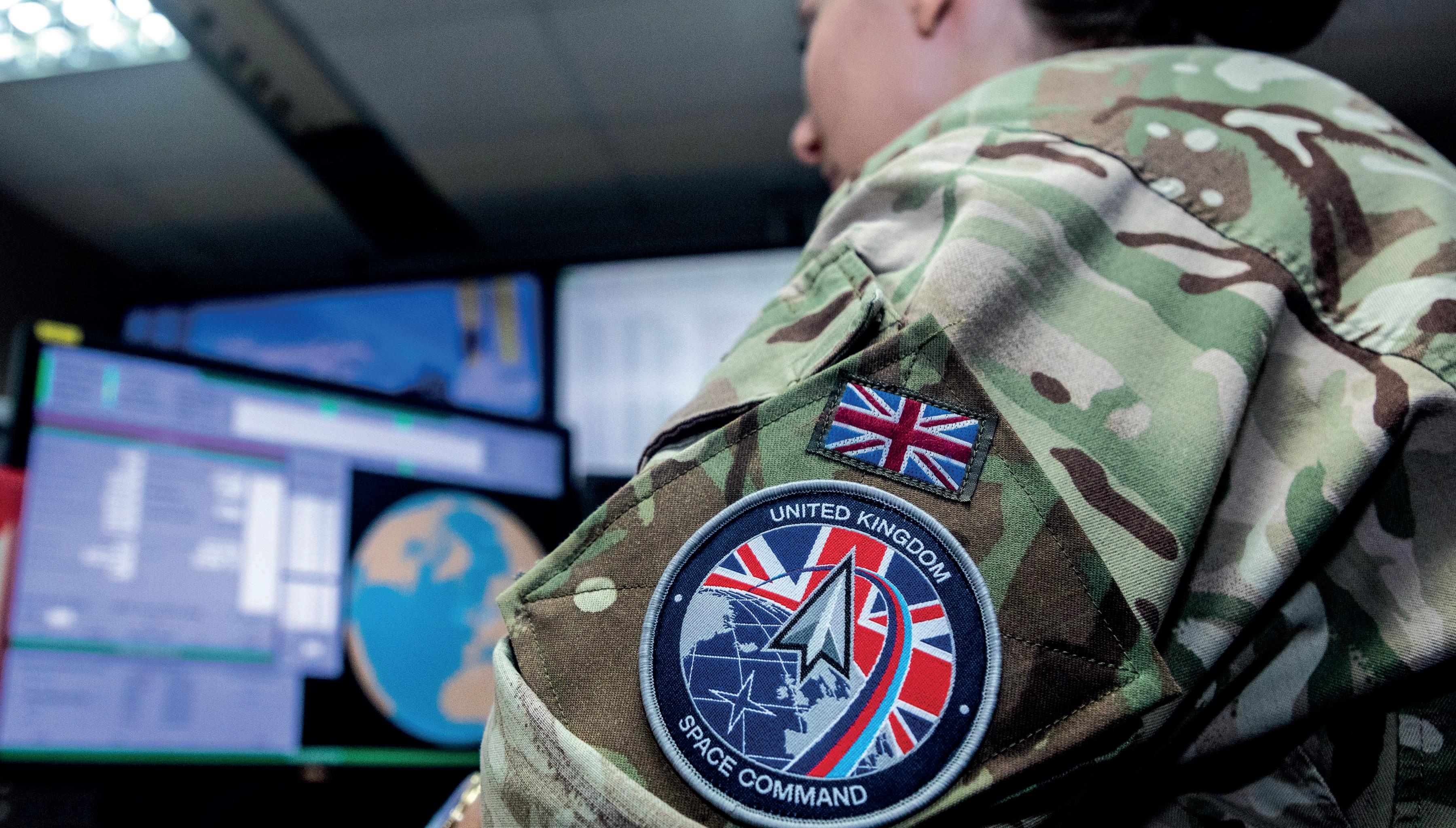
Nation-state reliance on the networked systems and capabilities that occupy space underpin a formidable global information-sharing medium and enable a functioning 21st-century society. From assured communication to critical intelligence, surveillance and reconnaissance (ISR) data, space enables precision military e ect in what is an increasingly congested and contested environment. Only through meaningful capability integration can we be sure to adequately protect and defend UK interests in space and exploit the growing potential to deliver multi-domain operational advantage.
Like us, our allies and partners are required to delicately balance their respective ambitions
for space sovereignty with the requirement of collaboration and integration with global neighbours. Greater integration with many existing and aspiring spacefaring nations has helped situate and secure the UK’s place in space as it reframes many of its previous astropolitical assumptions and invests in its international defence and security allegiances across Europe, the US, and the Indo-Paci c. Indeed, there are many mechanisms helping us better integrate with the global space enterprise for the bene t of the UK. Firstly, the Space Integrated Approach (SIA) is the UK’s primary mechanism for driving coherence across the UK/US space enterprise. The SIA focuses collaborative e orts across Command and Control, Operational Planning, Cooperative Capability
In a congested environment, space-based capabilities enhance military precision (PHOTO: MOD/CROWN COPYRIGHT)
While accelerating bilateral cooperation, the SIA is also working hard to explore options for greater integration with Australia and Canada. Bene ting from this close relationship has been the Five Eyes + France/Germany Combined Space Operations (CSpO) Initiative, where we have established agreements with seven CSpO nations, in addition to Japan and the Republic of Korea, with the expressed aim being greater interoperability and integration with our international partners.
With NATO’s recognition that attacks to, from or within space represent a clear challenge to the security of the Alliance, we continue to support the NATO space enterprise by providing operational products from the UK Space Operations Centre (UKSpOC), and space subject-matter experts to support NATO exercises. Signi cant opportunity also exists within the Joint Expeditionary Force (JEF) and Combined JEF (CJEF), both in terms of operational interoperability and training, and also in coherent and aligned capability and force development.
Both UK and French Space Commands are maturing at pace – alongside SPO Space Policy, UK Space Command jointly chaired the inaugural JEF Space Working Group in March 2023. Under the banner of CJEF, the connection is well established and optimised to enable mutual support. A bilateral Space Roadmap has been established to guide e orts
towards achievable goals and to better identify speci c areas of fruitful cooperation. The NATO Space Centre of Excellence, in which France and the UK are engaged, promises exciting possibilities for developing the space relationship within the NATO framework.
The UK SpOC is Defence’s Operational Level Command and Control Unit and is directed to support three missions at the operational level, from which several tasks are generated to provide services across Defence, HM Government and the commercial sector. These missions also provide the Ministry of Defence with the understanding of the space domain required to identify opportunities and threats to operations.

Space Command has developed an innovative approach to providing agile and iterative development of operational capability demonstrators as part of its embryonic Space Control research programme. This work has been based on the Defence Science and Technology Laboratory (Dstl)’s broader Space Programme and in close collaboration with key space industries following the strategic guidance set out in the Defence Space Strategy to establish capabilities to Protect and Defend our existing capabilities and our freedom of manoeuvre in the space domain.
Space e ects within the Joint Force Space Command HQ, and those of the component commanders, are planned, generated and coordinated by a network of Space Liaison O cers (SpLOs) spread across each ghting domain. These o cers are
specialist operations o cers who assist in increasing the e ectiveness and e ciency of forces regarding ISR, missile warning, space and terrestrial weather impacts, communications, positioning, navigation & timing (PNT) and maximising the utility of spaceenabled technologies. Plans are being worked with UK Space Command to enable a UK Space Academy to grow space expertise and nurture a trained workforce capable of delivering the space component of multi-domain operations into 2040 and beyond.
national security and the needs of Defence: satellite communications, space domain awareness, ISR, command and control, space control, PNT and launch. By 2035, we will have transitioned to the next generation of Skynet, enabling provision of secure satellite communications. We will have robust spacedomain awareness through a system of systems, with a diverse mix of assured data sources. Our Low Earth Orbit multi-spectral ISTARI constellation will be a fully functional operational capability providing assured ISR
Space services will continue to proliferate worldwide as technological and cost barriers fall and international partnerships for space support grow. State, non-state and commercial actors will increasingly gain access to data and services emanating from space. The number of space launch companies and satellite service providers will expand at least through 2025. And with more groups – commercial, academic and even private –now able to reach orbit, the growth of satellites and debris in space is expected to increase. Therefore, e ective integration, and decon iction, is vital. Seven critical capabilities spanning the space domain have been identi ed to support UK
and a digital backbone – this will be critical to enabling the Integrated Force in the digital and data age. To fully enable the Integrated Force, UK Space Command will also develop Defence’s understanding of operating in a contested and degraded operating environment and strengthen defence and national PNT resilience through the development of alternative solutions.
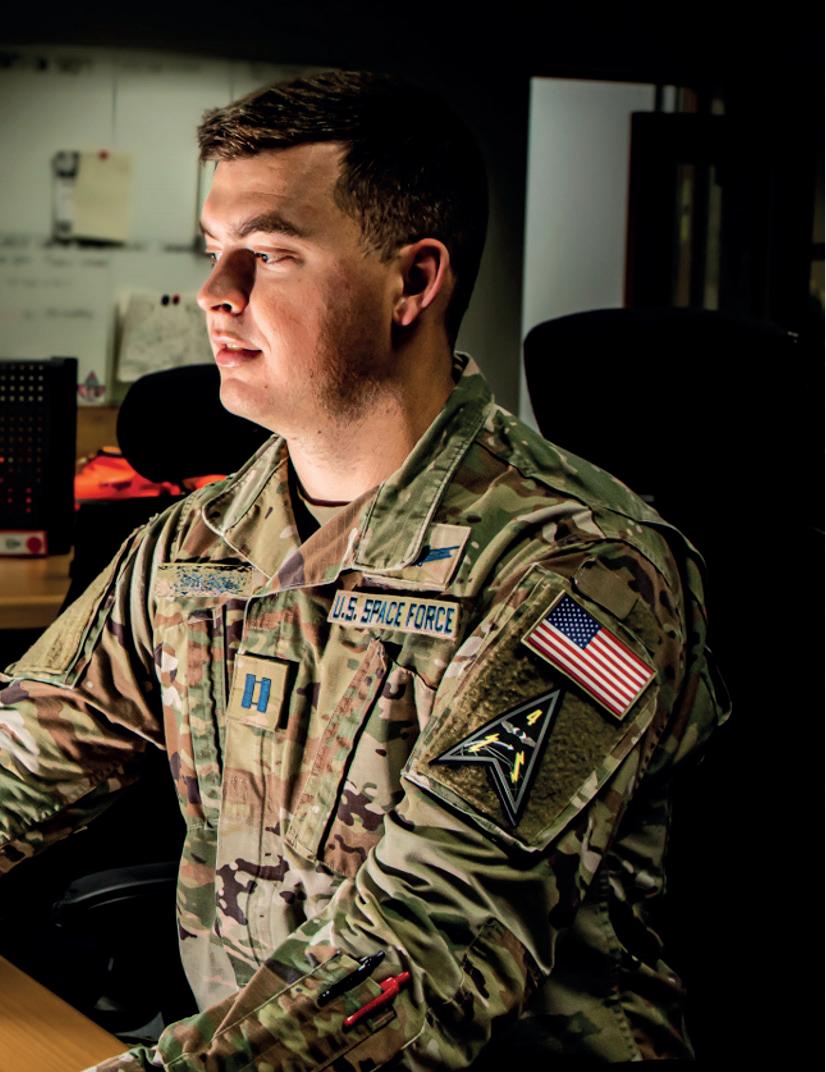

UK Space Command will seek to enable the value and impact of Defence space capabilities to be greater than the sum of their parts. This will be achieved through ve themes in the management of our capabilities: exploiting capability synergies;
Integrating UK space capabilities with those of partners and allies will serve to deliver greater space awareness and enhanced security to all (PHOTO: MOD/ CROWN COPYRIGHT)
“Space services will continue to proliferate... as technological and cost barriers fall and international partnerships for space support grow”
Plans are in progress to for a UK Space Academy to develop space expertise and nurture a trained workforce
(PHOTO: MOD/CROWN COPYRIGHT)
exploiting integration and connectivity bene ts between space capabilities; capitalising on dual-use opportunities across Defence and Civil space domains; ensuring value-for-money decisions across the enterprise when securing capabilities; coordinating collaboration with industry, academia, allies and other key partners; and cohering learning, development and knowledge spillovers across the enterprise.
The Commercial Integration Cell (CIC) was established to create a network for cooperation and collaboration between the Ministry of Defence, UK Space Agency and the commercial space sector. At present, seven commercial companies are members of the CIC, with three more in the process of joining. Future growth of the CIC will be key to delivering space domain awareness (SDA) as the domain becomes more complex and increasingly contested. Commercial members share information about their satellite operations and are briefed on pertinent threats to UK interests. Information can include electromagnetic interference detections, unattributed system anomalies, ephemeris (position and velocity) data and manoeuvre noti cations.
A Joint Task Force-Space Defence Commercial Operations (JCO) OCD is under way within UK Space Command, with IOC declared in April 2023. The US SPACECOM JCO initiative integrates commercial capability into military operations by contributing to SDA at the unclassi ed level to an unprecedented degree. Utilising commercial data from around the globe to provide indicators
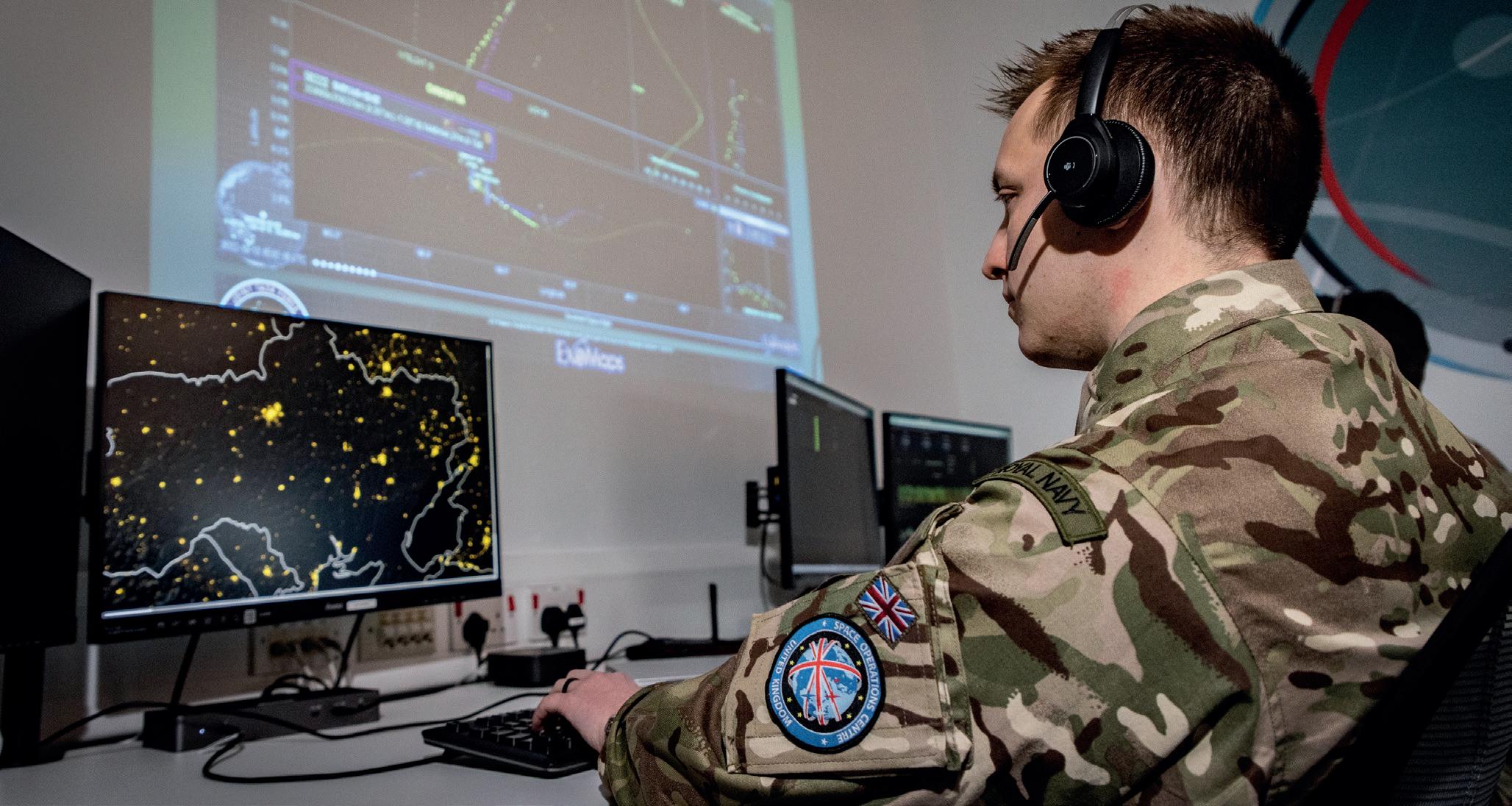
and warnings of launch and nefarious on-orbit activity, it overcomes many of the limitations associated with threat information sharing in the highly classi ed Space domain.
Through greater integration and investment in initiatives, we aim to Protect and Defend UK space interests by:
– e ectively detecting space threats, accurately attributing malicious activity in space and communicating threats in space across Defence and to our allies and partners;
– maturing programmes spanning SDA, space-based ISR, command and control, and Space Control;
– establishing agreements with Combined Space Operations (CSpO) nations (and beyond) to improve interoperability with international partners;
– developing strategic space relationships – including with NATO – and focusing on integration across UK Government, industry and academia;
– nurturing a trained workforce capable of delivering the space component of multi-domain operations enabled by the delivery of a Defence Space Academy.
All of these will help us to meet UK Space Command’s enduring and exciting vision, to integrate seamlessly as one of the ve operational domains and ensure space is safe, secure and sustainable for all generations.
Kevin Craven, Chief Executive O cer, ADS Group, looks forward to UK defence companies continuing to support the RAF and strengthening ties with international partners
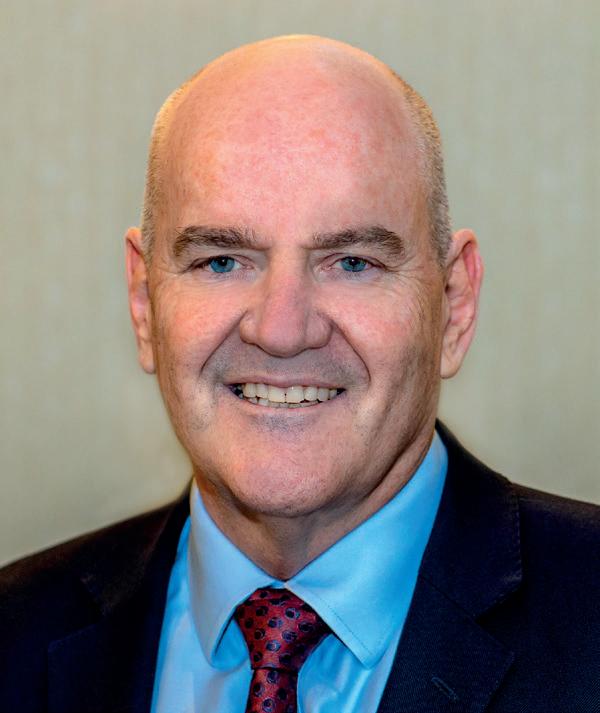
Government around closer partnership to help address the Armed Forces requirements for the future.
At the start of the year, I and many others were a little dismayed by the failed UK Space launch and the further news around the suspension of Virgin Orbit operations. However, our strong and agile UK space sector has so much to be proud of. We remain committed to increasing UK power in Space and becoming the leading provider of commercial small satellite launch in Europe by 2030. Our sector, collaborating with others, will continue to innovate, learn and deliver, and I look ahead with anticipation to the vertical launches planned from Scotland later this year.
February 2023 marked one year since the outbreak of war in Ukraine. I continue to be saddened at the sight of destroyed homes and hospitals. Since the outbreak of war, the UK has stood out for its staunch commitment in supporting Ukraine with advanced equipment and capabilities, and work continues through the International Fund for Ukraine. I have also noticed a marked culture change in defence, both in public opinion, but also in
The Integrated Review Refresh (IRR), published in March 2023, is a recognition of the importance of a strong domestic defence and security industrial base. In the years ahead, industry stands ready to accelerate its partnership with the Armed Forces and security services, providing advanced modern capabilities and strengthening relationships with international partners, including programmes like AUKUS and the Global Combat Air Programme (GCAP) with our strategic partners, Italy and Japan.
Undoubtedly, UK defence companies have the wherewithal to support the RAF in maintaining its leading edge, and continued partnership and investment will help our industries strengthen and grow. Including the uplift announced as part of the IRR, and the Chancellor’s Spring Statement, we will see a signi cant increase in defence spending over the next ve years. Furthermore, a Government aspiration over the longer term is to raise defence spending to 2.5% of GDP, when scal and economic services allow. This is welcome, and I await further details, including importantly a proposed timetable that will be essential in supporting industry to develop and deliver advanced next-generation capabilities.
For the UK’s Space power to continue to develop, it is essential for regional prosperity to be encouraged,
particularly where there are clusters of outstanding space organisations. ADS is exceptionally proud to be overseeing a pilot Space Technology Exploitation Programme (STEP), which, supported by the UK Space Agency, will enable SMEs in Northern Ireland to engage with large companies, and to use innovative, new solutions to overcome technology challenges – unlocking potential markets and building UK space capabilities.
To project the UK’s Air and Space power on a global stage, international ties must be strengthened at every opportunity. GCAP builds upon the substantial progress already made by the Team Tempest partners and presents a fantastic opportunity for the UK to drive innovation and technological development.
GCAP is expected to provide tens of thousands of skilled jobs in the UK, which are vital to high-value exports, and, as the project moves forward, ADS will work to ensure that our members, large and small, have access to the fullest range of opportunities for involvement.
Finally, throughout 2023 and beyond, I would like to see continued collaboration between industry, Government, the Armed Forces and security services, enabling the UK to project its advanced power. In September, I will be attending DSEI and look forward to welcoming international delegations to our United Kingdom Pavilion to show the very best of UK capability, able and ready to respond to an array of future threats.
Former naval ghter pilot Paul Tremelling, Business Development Director at Northrop Grumman UK, outlines how global multi-domain operations can be achieved and how they will transform the speed with which decision-quality information can be relayed to the e ector of choice for optimum e ect
As the con ict in Ukraine rages on, residents of the capital, Kyiv, have become grimly accustomed to air-raid sirens sounding across the city. The sirens sound as the Ukrainians search the skies and electromagnetic spectrum for indicators and warnings of impending attack, possibly in the form of sophisticated weapons such as the hypersonic Kinzhal missile.
While debate continues about how e ective speci c missile systems have been, their use, and that of many new or adapted approaches to warfare, allow an early look at the next generation of military capabilities. Aspects of Russia’s invasion have given military planners a glimpse of the future battlespace.
Many observations are being drawn from the Ukrainian con ict. Among them is the absolute necessity to understand and operate across the electromagnetic spectrum, in concert with physical and kinetic operations. This is, of course, neither surprising nor new – software has been famously ‘eating the world’ for decades already. But it does reinforce the importance of activities and operations that NATO and western alliances will have to master now and in the future if we are to survive to ght.
When the next ght comes, it will almost certainly involve multiple allied nations. The ability to instantly collaborate, share data and execute strategies among globally dispersed, multinational forces is

fast becoming an essential capability. The UK’s multi domain integration (MDI) initiative recognises this, calling for UK Defence to work seamlessly with its allies, and the US recently re-added a ‘C’ to its JADC2 (Joint All Domain Command and Control) moniker, standing for ‘combined’ and highlighting the need for interoperability with its international partners. Thankfully, the digital age is bringing notable advantages to interoperability and integration, across domains, but also allies. Whereas physical interoperability is only guaranteed by total commonality, in a more commoditised digital world small di erences can be surmounted by, for example, the use of gateways and translators. On top of this, technology has become cheaper and, therefore, more replaceable. The likelihood of taking the battle eld on consecutive days with a di erent 155mm cannon is zero. But using a di erent drone/tablet combination is now de rigueur
Digital compatibility also speeds up integrated capability. If air system mission software is ‘Pyramid compliant’ it is far easier to upgrade, as the reference architecture is established and available. Immediate integration with existing C2 tools becomes achievable, as is the employment of a common user interface. If our aim is to produce and upgrade readily certi able software applications, then the use of software factory methodologies is key. The actual applications and their use cases will not necessarily become apparent until a realtime demand signal is made – but the ability to pre-emptively certify the factory, as opposed to individual products, will massively speed up
elding, so long as assurers and accreditors are bought in from the earliest possible point.
The ‘so what’ to all of this is the prize of true, digitally enabled Agile Combat Employment, but this will only deliver the true bene ts it seeks if it is digitally enabled from the o . Dispersed and relocating forces must be able to access critical information at all stages of the ght, be that during tasking, programming, planning or when ghting. Multiple assured pathways will be required, including terrestrial and satellite communications and resilient data links. The providers of these services need to be as agile and survivable as the war ghters at the edge.
When we have achieved digital enablers that are as seamlessly integrated as a WhatsApp for mission planning, an Amazon for logistics and an Uber for friendly force disposition, we will be capable of dispersed operations that can strain and break the enemy kill chain across every domain, while at the same time reinforcing our own ‘survive chain’ and resilience. During peacetime, the prize is the ability to avoid vendor lock-in that has often plagued procurement e orts. This will hopefully allow nations to procure more con dently and consistently, in turn strengthening allied industrial bases for when they are really needed.
We all know that ‘don’t be there’ is a key tenant of survival and is being practiced every day in Ukraine. Achieving it at a global scale requires us to ensure that operations can occur from wherever assets are based, exing and adapting in real time as required. We now have the digital tools to enable this. We should put them to use.
MDI requires digital enablers that are seamlessy integrated across the entire force (PHOTO: MOD/ CROWN COPYRIGHT)

The Agile Combat Employment (ACE) concept aims to enable the RAF to operate from a greater number of locations, providing increased agility, exibility and resilience. Group Captain Jason Payne, No 11 Group’s Deputy Assistant Chief of Sta , tells Jim Winchester how the RAF is developing ACE and how it intends to deliver it for operations
Typhoons deployed from RAF Akrotiri in Cyprus to an undisclosed base in the Middle East to test the ACE concept as part of Exercise Blue Dragon (PHOTO: MOD/ CROWN COPYRIGHT)

In the last two years, the RAF’s Agile Pirate and Blue Dragon exercises have seen Typhoon fast jets deploying away from their main operating bases to Stornaway in the Hebrides and to a forward location in the Middle East. Group Captain (Gp Capt) Jason Payne explains: “It has basically been a crawl, walk, run approach to ACE, where we piggyback o existing exercises or deployments in order to be able to experiment with how we want to take ACE forward.” He continues, “We are
starting to build on Agile Pirate to be able to exploit innovations and di erent methods of employment across multiple areas, including people, crossskilling, basing, infrastructure and command and control. Ultimately, ACE is about agility, survivability and resilience. We often use the mantra of ‘ ght tonight’, yet, actually we’ve got to make sure that we survive to ght tomorrow as well.”
Many more such experiments are planned. The UK is providing support to NATO during
Operation Azotize in the Baltic States later in 2023, which will be an opportunity for the RAF to develop its concept of operations while deployed within the region. “So, again the focus is on that building block approach. First ghting from the UK and then projecting elsewhere, yet there will be opportunities within our normal operating programme that we should be able to utilise and innovate in order to expedite the ACE concept of operations,” Payne points out.
It’s not just about combat aircraft like Typhoon and Lightning. ACE impacts on a range of other assets, reveals Payne: “Take the Voyager tanker aircraft as an example. It is, e ectively, a civilian aircraft. On that basis it should be able to deploy and operate from civilian air elds even from a combat air perspective.” However, there are peacetime regulations that can prevent an armed aircraft landing at a civilian airport. These are the sorts of things that the RAF is trying to tease out, and is therefore working with the Civil Aviation Authority (CAA) and Department for Transport (DfT). “That’s probably step four of
the work we do. In the meantime, there are plenty of air elds within the UK that we should be able to deploy to in order to increase our survivability, because what we’re trying to do is give multiple dilemmas to any adversary,” says Payne.
The reasons for this dispersion are numerous, but include the types of hypersonic missiles that have played a signi cant role in Russia’s illegal invasion of Ukraine. Their immense speed reduces a target’s reaction time, making aircraft increasingly vulnerable on the ground. That said, they are expensive and limited in number. So, creating targeting dilemmas through agility and resilience increases survivability. “Moreover, you may even deter a strike in the rst place if the dilemmas you present create a situation where targeting is futile,” Payne adds.
The challenge is that the RAF now has fewer air bases than it used to have. Payne remembers the multiple Harrier and Jaguar squadrons of the 1980s and 1990s that the younger generation of aviators does not. They have been brought up with a reduced number and type of operating locations and are more used to the kinds of ‘super’
Typhoons from RAF Lossiemouth practised refuelling and re-arming during Exercise Agile Pirate in Stornoway, the Hebrides (PHOTO: MOD/CROWN COPYRIGHT)
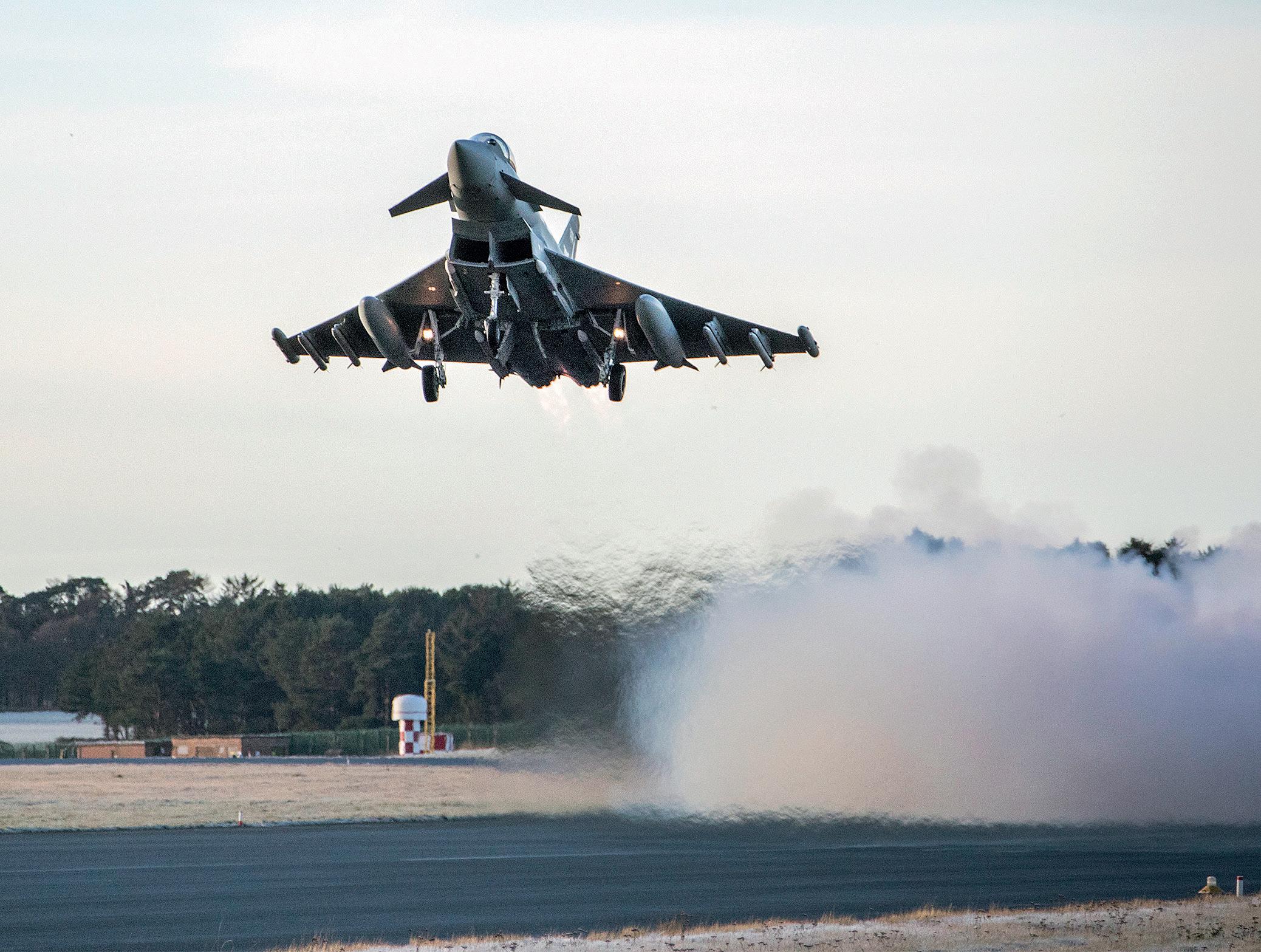
(PHOTO: MOD/ CROWN COPYRIGHT)
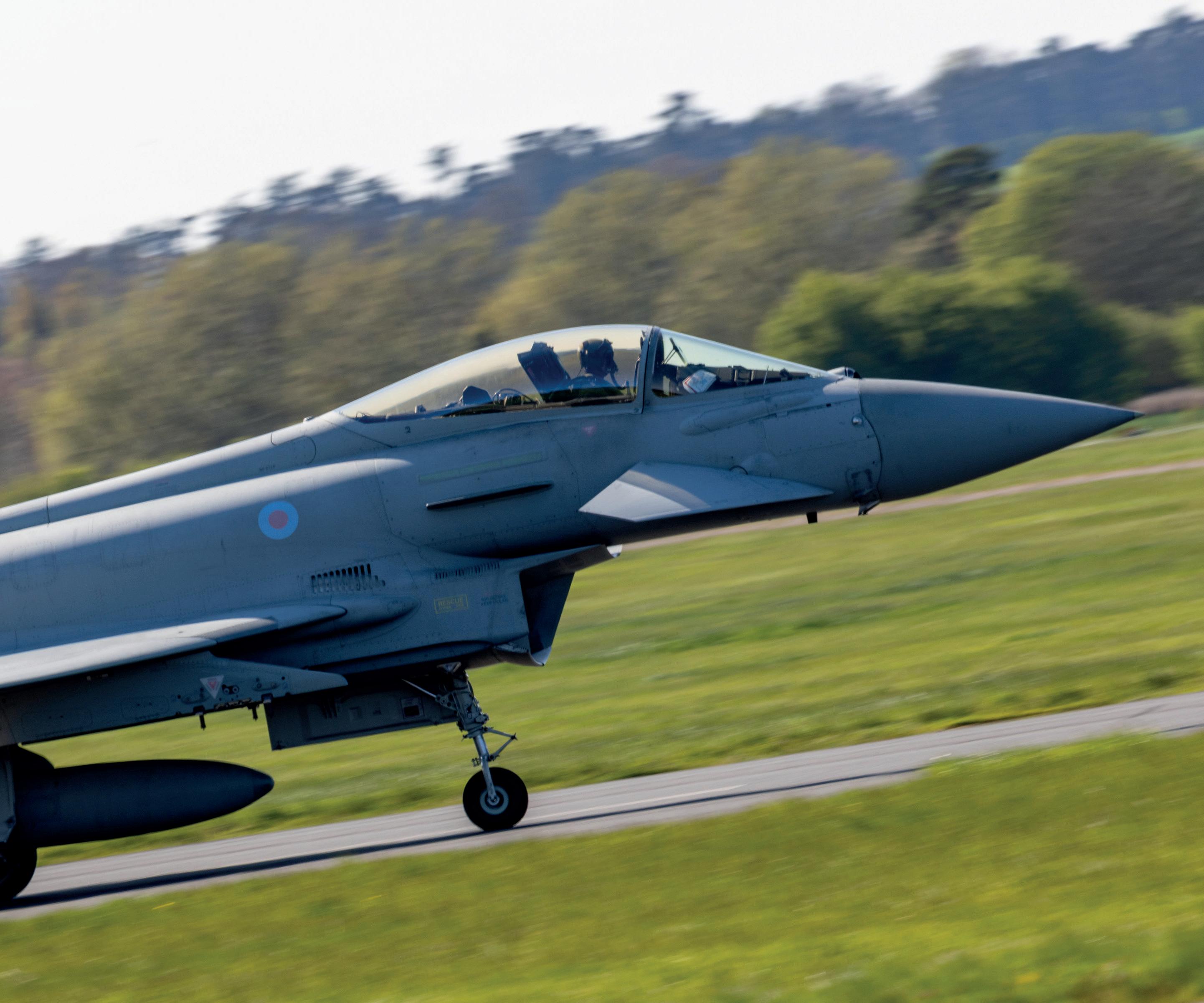
main operating bases that have replaced them. What the RAF is now trying to do, through ACE, is to introduce more exibility and agility. According to Payne, “A lot of this is culturally based, and part of that culture is mindset, and
“It’s not as simple as the Harrier, Jaguar and Tornado days. They were relatively basic aircraft. We now have highly complex aircraft with sensitivities around security. Yet these are things that will not be unsolvable, especially when needs must.”
a part of that mindset is appetite for risk. For example, some of the things you’d need for a wartime or serious ACE deployment would be mobile communications and the ability to re-arm and cross-service on another country’s bases, which we used to do quite a lot in the nineties. It’s something that we’re trying to re-introduce, yet obviously there are complexities with technology.
Looking towards events in the east, Payne says: “For a country the size of Ukraine and its capabilities, they’ve managed to survive using a lot of innovation, a lot of hard work and a lot of great practices. Whether that is their interpretation of ACE or not we will see, yet there are de nitely some lessons I am sure that both ourselves in the West, as well as Russia and its allies, are learning on a daily basis from that con ict.”
“It’s not as simple as the Harrier, Jaguar and Tornado days. They were relatively basic aircraft. We now have highly complex aircraft”
like-for-like replacement on an input basis. Short-notice dispersal and frequent location changes need to be orchestrated through well-exercised C2 across service support and, critically, enabled by access to accurate data to access and optimise resources. That requires appropriate employment and contracting models, as well as having an appropriately quali ed team.
managing complex data in secure environments and we are now orchestrating data in even more sophisticated ways to greater e ect. Our partnership with advanced arti cial intelligence (AI) providers is enabling us to change the way we support our customers across a range of environments, bringing with it insight and advantage.
 Tom Newman CEO Land and UK Aviation, Babcock International
Tom Newman CEO Land and UK Aviation, Babcock International
To maintain its competitive edge, UK air power must be ready for high-end operations and have agility, resilience and exibility. Air bases themselves will be a war ghting capability able to exercise, test and enhance their resilience. Force elements will need the ability to redeploy rapidly and frequently, including to di erent and potentially unfounded locations. Support services must ensure the generation of air power at home, away and dispersed, all at short notice.
A support model based on a doctrine of disrupting pattern-setting presents a challenge in itself. It requires an emphasis on enabling a range of outcomes, not
Industry possesses immense potential and is capable of enhancing capability and e ectiveness. However, there are signi cant challenges that must be addressed. There are three fundamental questions that must be considered: how to translate policy into action, how to view industry as a capability that is fully embedded within the military, and whether a competitive tendering process or a collaborative approach among complementary industries will yield better and faster results. E ectively tackling these challenges is critical if the defence sector is to unlock the full potential of industry as a force multiplier.
What technologies will alter the way air power support is enabled?
Situational awareness of the physical and human resources throughout the support chain is critical to sustaining support. Building and maintaining information advantage for commanders and support services shall come through the ability to share and access data. We have decades of experience
Another area where we see an ability to increase readiness is additive manufacturing, supported by digital models that provide the dispersed ability to generate spares. While we don’t believe that this will be used for aircraft parts, at this stage, we are already using this in our support to the Army on a range of vehicles and equipment and, therefore, can see this as an option for ground vehicles and equipment in the air environment.
There is also the potential to provide an indigenous ability to generate synthetic fuels for Defence, which we are actively exploring to mitigate risks to supply chains and infrastructure.
What does this mean to Babcock’s teams on air bases?
As a business, we recognise the privilege we hold in being integral to the support to all the UK’s armed forces. We uphold our purpose of creating a safe and secure world, and we are committed to delivering outcomes in all their areas of our work. We recognise the everchanging demands of the security of the nation and continue to show our adaptability to meet these challenges.
The Air O cer Commanding No 11 Group, Air Vice-Marshal Phil Robinson, reveals how the UK’s support to Ukraine will inform the development of future RAF capabilities and doctrine
The illegal invasion of Ukraine by Russia has highlighted how devastating the absence of control of the air can be
 (PHOTO: ANMBPH/ SHUTTERSTOCK)
(PHOTO: ANMBPH/ SHUTTERSTOCK)
Russia’s invasion of Ukraine has been the catalyst for debate on how nation states prepare, equip, train and conduct operations for the most important and demanding role that their armed forces undertake – defence of the homeland from armed attack. The events that have unfolded in Ukraine have demonstrated that widely held assumptions on the nature of security threats moving into the middle decades of the 21st century have been proved wrong. While the need to guard against international terrorism will always endure, the prospect of
a state-on-state con ict has once again been realised. For air power, there have been many lessons, both in its pivotal role in supporting an ally, yet more importantly the devastating consequences of the absence of control of the air.
It is often said that wars start and end on the feet, and there remains an enduring truth to that. The cost in lives, sovereign territory and resource in such ghting can be in uenced arguably in no greater way than through investment in the intelligent
application of air power. In Ukraine, we have witnessed a return to trench warfare and casualties in the numbers that remind us of a century ago. The fact is, there is no control of the air and, without it, the application of rapid, precise and overwhelming force at a place and time of choosing has proven impossible.
to detect and defeat all of them, simultaneously. To do this, there is a need to understand our airspace at a delity not seen before; if we cannot see our enemy, we cannot defeat them. We will need to be agile and unpredictable in how and where we base, how we manoeuvre and sustain ourselves, and how we launch our counter-attacks.
The war in Ukraine has shown that threats from the air are now more numerous and varied (PHOTO: DROP OF LIGHT/ SHUTTERSTOCK)

As air forces, what we have witnessed in Ukraine is a salutary lesson for our collective futures. The need to secure our own skies has never been greater and more complex. Threats now range from precision long-range hypersonic and ballistic missiles, massed stealthy cruise missiles, ‘traditional’ combat aircraft, loitering munitions to weaponised hobby drones. We must be prepared
Once we launch aircraft, they must be e ective, dependable and lethal. To ensure success, it is not just about buying the right hardware, it is about training the Whole Force around our platforms and airbases, robust logistics chains and sustainability, particularly around our weapons stockpiles.
Even more so in the 21st century, it is how we manage the data that is generated by air
“Air power delivers a unique capability across the domains to provide a tangible and decisive global presence to allies, at pace”
Threats from the air include ship-launched cruise missiles, air-launched hypersonic missiles, kamikaze unmanned aerial vehicles and even weaponised hobby drones (PHOTO: GIOVANNI CANCEMI/ SHUTTERSTOCK)
power. Increasingly, we will need to invest in and understand how to optimise our data management, and invest in our digital backbone to ensure that we maintain information superiority.
Through the course of all of this, there is not just the requirement to defend our own skies. The nature of modern alliances and partnerships is that they are not con ned to our land or maritime borders; they are global. Air power delivers a unique capability across the domains to provide a tangible and decisive global presence to allies, at pace.
The ability to rapidly project air power provides political choice and decisive capability. Every continent faces their own unique security challenges, competition for territory, resources or rogue actors. What is constant is the applicability of air power in meeting, deterring and defeating the threat in partnership with the other domains.
In the RAF, we have been both heavily involved in supporting the e orts of Ukraine to restore its borders, yet also in identifying how we can learn and adapt to meet the evolving nature of con ict. We are now a single Global Air Component, able to operate with agility irrespective of boundaries. We are also concurrently enhancing and increasing our high-end war- ghting for fourth- and fth-generation combat aircraft, integrating ISTAR platforms and the other domains to defend our airspace.
Central to our e orts is delivering greater agility through Agile Combat Employment and modernising how we will command and control our forces across the world from our home base. How we embrace arti cial intelligence, machine learning and, of course, an increasingly talented workforce are key. In the coming years we look forward to continuing the strong relationships we have built with our many allies and partners to ensure that both our own security and that of our allies is maintained.
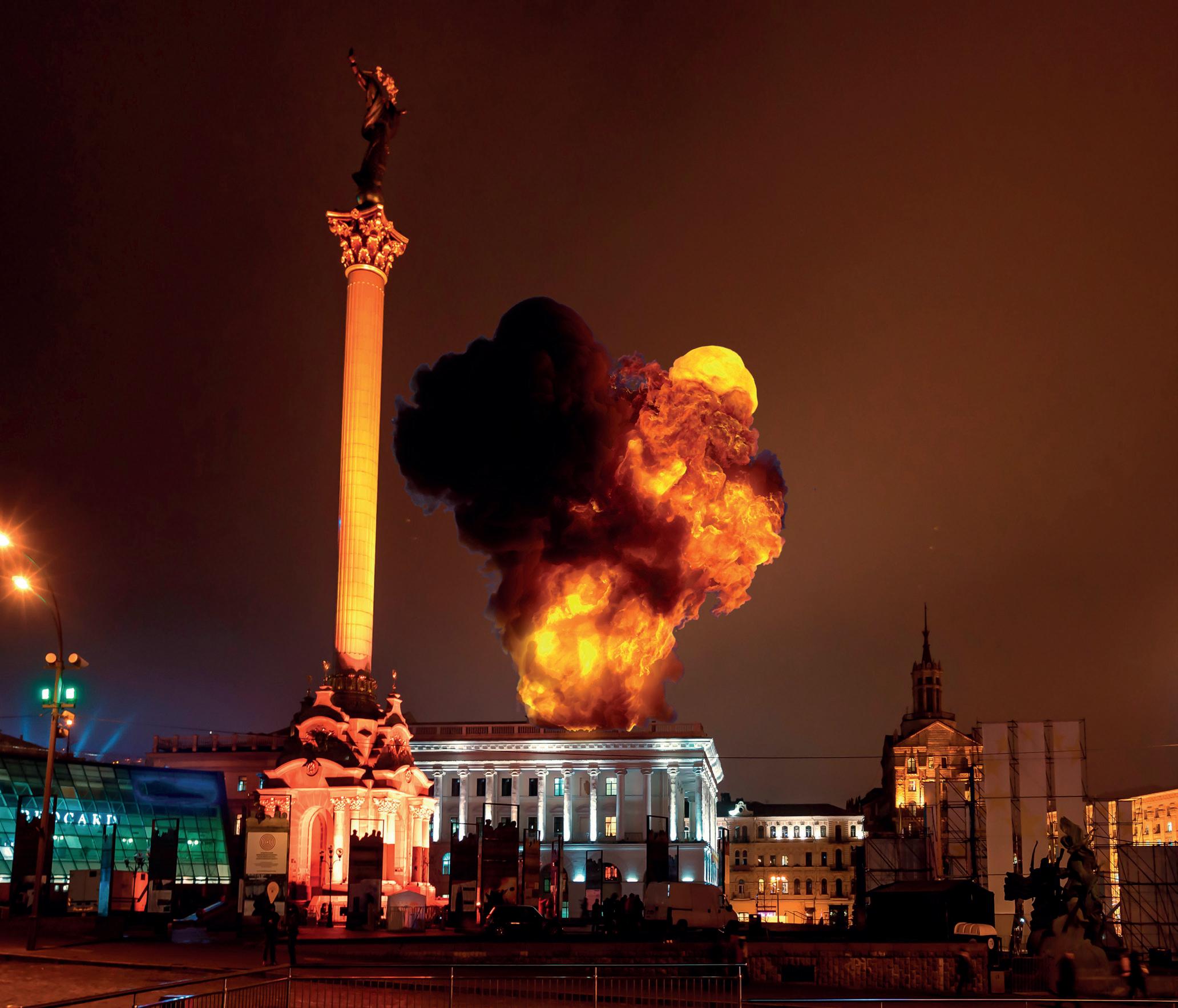
On 22 November 2022, the RAF Force Protection Force and Support Forces evolved into the Global Enablement Organisation, as part of Number 2 Group. Air O cer Global Enablement, Air Commodore Jamie Thompson, explains how this transformation will deliver enhanced security and capability to the UK, especially to forces deployed internationally
The RAF has maintained Force Protection capabilities since its inception. While often con ated with the formation of the RAF Regiment in 1942 to protect RAF bases, after the fall of Crete, the reality is that the RAF Armoured Car Companies, engineers, logisticians and RAF Police were delivering some components of Force Protection from the inception of the RAF in 1918. As the strategic context has shifted and the operational demand changed, these elements have evolved over the past 80 years to become the modern RAF Force Protection Force.
The strategic context shifted dramatically again in February 2022 when the Russian invasion of
Ukraine changed the political and military landscape in Europe. Against a backdrop of an era of constant competition, in which our existing assumptions are increasingly challenged, it was recognised that the RAF needed to adapt its ability to deliver and sustain Air and Space Power operations across the globe. The analysis to support this assumption, while varied, is convincing and summed up neatly by the recent RUSI analysis, Preliminary Lessons in Conventional War ghting from Russia’s Invasion of Ukraine. This report highlighted that “there is no sanctuary in modern warfare” owing to technological advances that mean an adversary can now strike at range; this means that survivability depends on dispersal and deception.
The RAF’s Tactical Medical Wing rehearse their life-saving role on a Chinook. Battle eld medical evacuations are a key part of the RAF’s Global Enablement capabilities
(PHOTO: MOD/ CROWN COPYRIGHT)
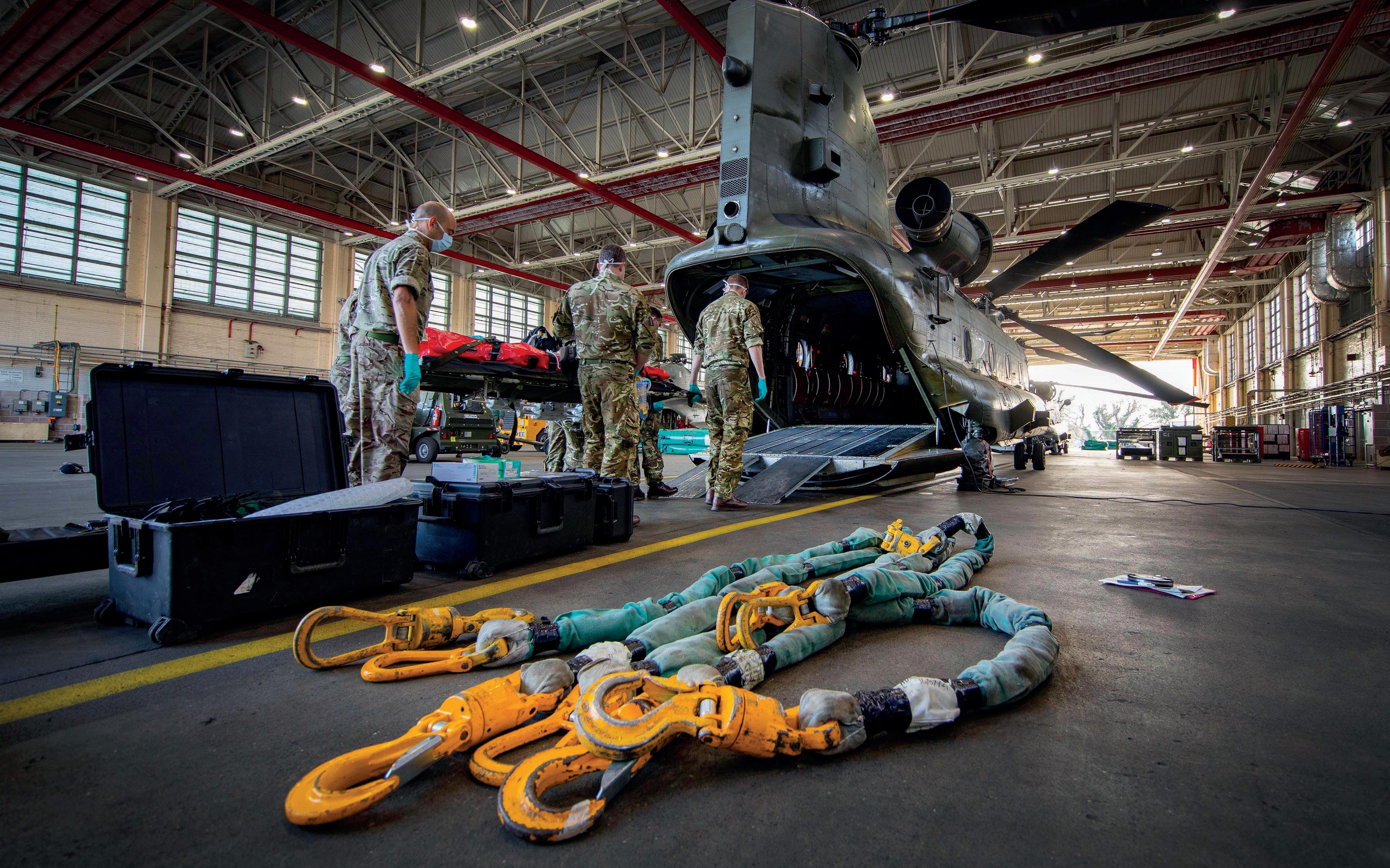
A review of command and control in the RAF and analysis of our Combat Support and Combat Service Support units identi ed that a single formation of ground combat and support forces would quickly leverage opportunities and allow the RAF to better orientate its capabilities to support Agile Combat Employment. Amalgamating the 1* FP Force, 1* Support Force and 1* Battlespace Management Force under a single 1* Command allowed us to promote unity of command, improved collective training and more focused multi-domain integration. This new organisation has clearer command and control, is aligned to the Global Air Component Commander and is more readily able to manage risk, capability and output.
As of March 2023, the Global Enablement organisation includes some 7,500 Whole Force personnel, with 600 Service personnel routinely deployed every day across 25 global locations. It is constantly engaged in sub-threshold


operations and provides the dedicated cadre of ghting aviators that will enable ACE and expeditionary operations. It comprises:
– Air Security Force Securing the RAF through policing and security across the TESSOC (terrorism, espionage, subversion, sabotage and organised crime) spectrum;
– Combat and Readiness Force Defending the RAF through ground combat, MultiDomain Integration, Counter-Uncrewed Air Systems and preparing the RAF for operations;
– Support Force Enabling, sustaining and recovering global operations through specialist logistical and engineering capabilities, and providing the RAF Music Services and RAF Mountain Rescue Service;
– Medical Force Providing specialist aviation medical advice and tactical medical operations; and


– 90 Signals Unit Enabling Air and Space power by generating freedom of action and mission assurance in cyberspace.


Formed under the Air C2 Review to provide unity of command, e ective collective training and force generation to operate and enable Agile Combat Employment
Combat & Readiness Force Ground Combat, Air Land Integration, CsUAS and FP Command & Control
Air Security Force Police, Security, Counterintelligence, Counterterrorism & Base Defence


90 Signals Unit Operational C4I and Defensive Cyber Operations
Support Force Specialist Engineering, Logistics, Mountain Rescue Service and Music Services
Medical Operations Tactical Medical & Aeromedical Operations
BM Operations Air Command & Control and Surveillance Operations

Key facts
• We are an expeditionary operations focused Whole Force Team
• We are present on every RAF base and in 25 global locations





• On any given day we have over 600 Service personnel deployed


• We are held at Very High Readiness to support Defence
• We have integrated Royal Navy and British Army elements
• We are a Multi-Domain Force engaged in sub-threshold activity
GE Focus Areas Quarter One of 2023
• Development of deployable and resilient Air Command & Control
• ACE and expeditionary warfare development
• Post-Attack Recovery capability development
• Technology Integration – Uni ed Experimentation Group
Defence Engagement (GE Exchange O cers)
• US – HAF, USAF, SF and the O ce of Special Investigation
• France – Airmee de l’Air: CPA
• Germany –Luftwa e: Oberschutzregiment
• Norway – RNAF Base Defence Group
• NATO – Deputy Director CBRN
• CJEF – Liaison O cer
• JEF – Liaison O cer
The Trilateral Security Pact announced in September 2021 between Australia, the United Kingdom and the United States is more than just a nuclear-powered submarine delivery and support package. It also incorporates an intention to collaborate across a range of capability areas, including arti cial intelligence, autonomy, cyber, hypersonics and space. Air Vice-Marshal Simon Edwards, Assistant Chief of the Air Sta (Strategy) explains its signi cant bene ts to the UK
AUKUS is founded on a Trilateral Security Pact between Australia, the United Kingdom and the United States. Signed on 15 September 2021, it matters on many levels. It brings three Five Eyes nations together, meaning it is already based on the highest levels of trust and shared interest. It sends an overt signal that we will work together in the Indo-Paci c, supporting each other in ways – and at a pace – that we cannot achieve alone. And it
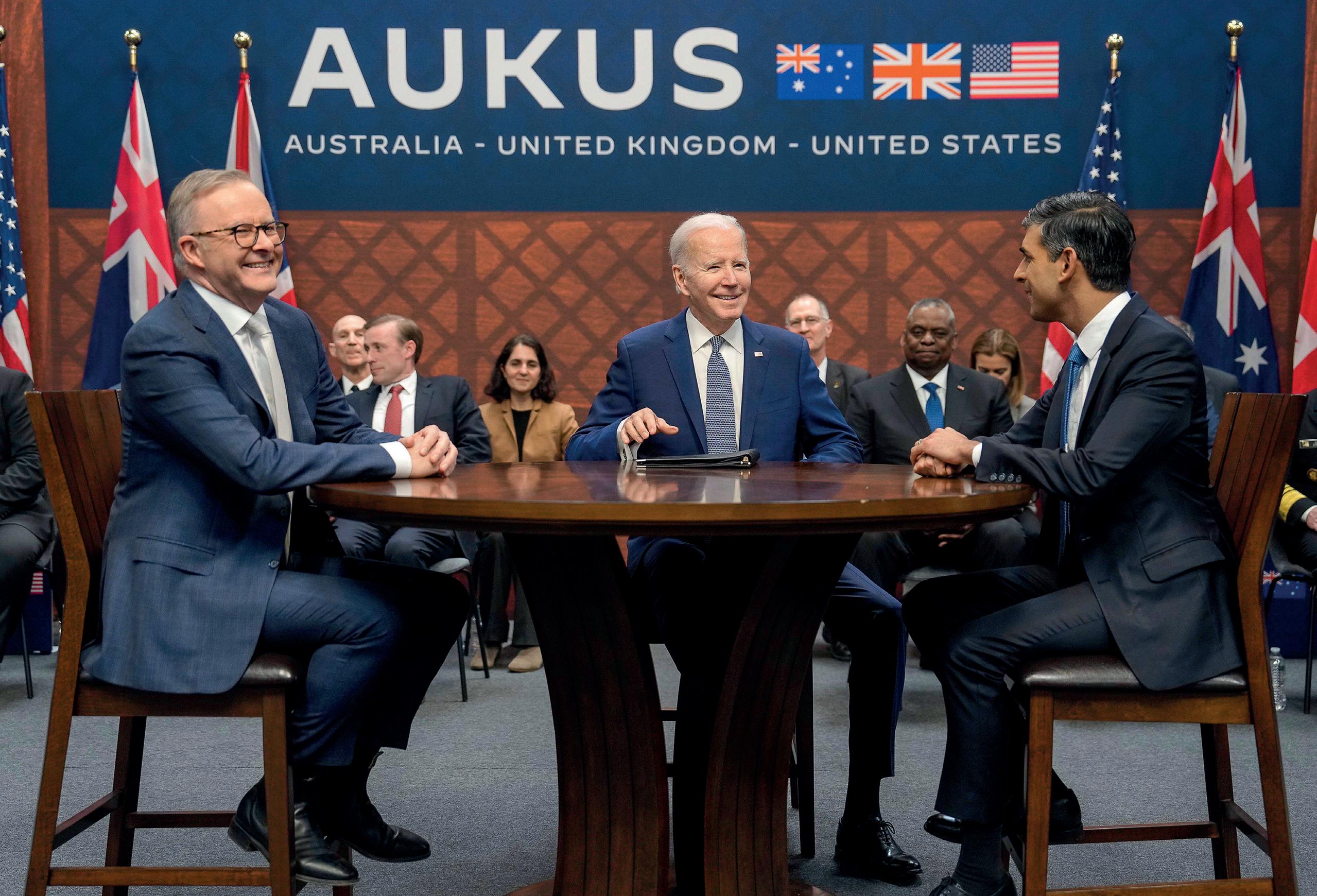
provides the ecosystem into which new capabilities can be born; the headline may be maritime, yet the story already runs more deeply than submarines.
AUKUS Pillar 1
Pillar 1 can perhaps be described as AUKUS’s compelling call to arms. It will see the development of nuclear-powered submarines for Australia – a strategically rare capability, which must ensure it remains strategically relevant. The rst generation of
The leaders of Australia, the US and the UK met in San Diego on 13 March 2023 to discuss the AUKUS Trilateral Security Pact (PHOTO: ALAMY)
Australian Prime Minister Anthony Albanese, US President Joe Biden and UK Prime Minister Rishi Sunak deliver their remarks during their meeting at Point Loma Naval Base in San Diego in March 2023 (PHOTO: ALAMY)
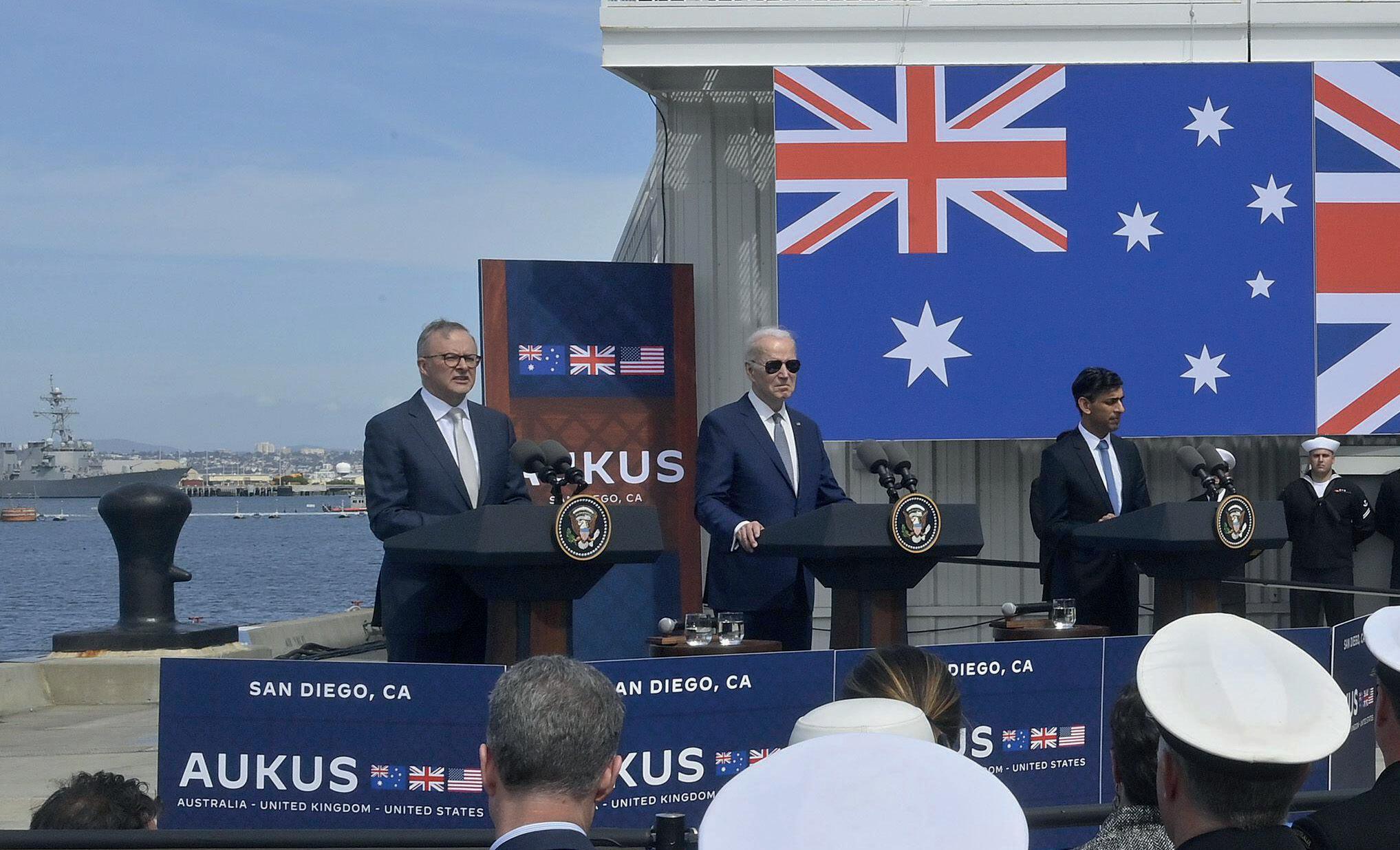
these submarines will be constructed in the UK and Australia, combining the expertise of three navies –all of which are conventional, two of which are nuclear. This is a powerful mix, made all the more so by the capability outcome it seeks: for those next-generation submarines to have the extended range, greater speed, substantial capacity and the submerged endurance needed in the Indo-Paci c if we are to face the challenges inherent in operating across a region that covers more than a third of the planet.
AUKUS Pillar 2
Pillar 2 may not have been the headline, yet it completes the story (or rather, the story so far), impacting our Air and Space Power capabilities. It reveals a spectrum of ambition; foreseeing developments in areas including cyber capabilities, arti cial intelligence, quantum technologies, autonomy, hypersonic and counter-hypersonics, electronic warfare, information sharing and innovation. Innovation needs the right culture, the right challenge and the right perspectives – exactly what we can get from a partnership as powerful as AUKUS.
The AUKUS relationship highlights our shared strategic ambition to protect our freedoms and the security and stability of the international system. And to achieve this e ectively, we must both maintain and
continue to evolve credible military capabilities that will be able to address any foreseeable threats to this.
It makes sense – indeed it is imperative – that we work ever closer together, and to make the most of our shared Air and Space Power capabilities, including the F-35 and E-7, tied together by shared data and understanding. This will ensure that our collective capability equals more than the sum of its parts.
We already know and can see the bene ts of working so closely together – from joint training and exercising, and from developing collective approaches to common problems. Our Air Forces exercise together regularly, through Red Flag in the US and Pitch Black in northern Australia. These exercises provide invaluable opportunities for us not only to train and operate as we will ght, but to make it clear that we are agile and ready to come together, and to integrate military e ects across all domains. We must – and so we will – introduce and integrate nextgeneration capabilities as they evolve from concept to combat-ready, including through initiatives such as the US NGAD (Next Generation Air Dominance) and UK-led GCAP (Global Combat Air Programme).
Of vital importance is the person-to-person interoperability that such experiences create. We need to deliver people-focused outcomes and build actual human relationships and trust in each
other and each other’s organisations. We know this can make a decisive di erence – trust and understanding enables the agility and pace that we will need to face the strategic challenges of our future, and to outthink and out ght the opposition.
This strategic partnership relationship will also encourage our Air and Space Forces to develop the battle-winning concepts we need to attack the tyranny of distance so apparent in the Indo-Paci c.
focusing upon what other international actors are learning from Russia’s illegal invasion. This includes how their future actions and ambitions might change as a result of the strategic situation they are witnessing in Eastern Europe.
The closeness of our working relationships and the breadth and depth of our collaboration also allow us to share best practice in innovation, as we evolve our capabilities incrementally, utilising technological
And they will also allow us to identify key lessons to address the tyranny of proximity that is being faced by our NATO Air Force allies across Europe. No one theatre stands truly alone; both are critical to our collective security.

Working together, we are identifying the critical air, space and cyber power lessons from the current con ict in Ukraine and, in parallel, we are
opportunities as they mature and become operationalised. We know this from the RAF Astra and RAAF Jericho, and so many other collaborations, comparators and collaborations – AFWERX, Morpheus and Rapid Capabilities o ces being cases in point.
For what it does, for what it will do, for what it means, for what it messages, for what it enables and reinforces – AUKUS matters.
“We already know and can see the bene ts of working so closely together – from joint training and exercising, and from developing collective approaches to common problems”
Air Vice-Marshal Mark Flewin explains how Number 1 Group is evolving to ensure that it can continue to deliver decisive air power across all its roles
The ISTAR Force, including the P-8A Poseidon maritime patrol aircraft (pictured), is part of No 1 Group’s command (PHOTO: MOD/ CROWN COPYRIGHT)

While Darwin’s and, subsequently, Megginson’s thinking was in a very di erent context, the principle is equally true today for military capability and e ect, where it is important to adapt to the changing environment around you –and in Number 1 Group (No 1 Gp) we are doing just that. This adaptation is not just in terms of new capability – such as the introduction of E-7 Wedgetail, Protector, an ambitious Typhoon upgrade programme and the growth of the P-8, F-35 and
the A400 forces – it is also the way in which we operate and deliver continuous operational e ect. Command and Control (C2) is fundamental to the e cient application of any form of military power, and I am fortunate to have the opportunity to reshape No 1 Gp with a rm focus on being ready to deliver decisive air power today, while being prepared to meet the security challenges of tomorrow. The Air C2 Review Programme across HQ Air Command is enabling such change, which will conclude this year. Within No 1 Gp this o ers a generational opportunity to recon gure – working seamlessly alongside both No 2 Gp as the ‘Global Enabler’ and No 11 Gp as the ‘Global Air Component’ – to ensure that we can more e ectively deliver air power with our people, assets and capabilities.
“It is not the strongest of the species that survives, nor the most intelligent, but the one most adaptable to change” – Charles Darwin
The fundamental change is to implement an Airbase and Air Wing Model. Each will be separately commanded, with the Airbases delivering the air eld and enabling functions across the stations under the command of No 2 Gp. In No 1 Gp, this will see the command of our operational squadrons, operational conversion units, and their immediate force elements residing within the Air Wings under Commander Air Wing, who will also have Duty Holding and safety responsibilities for the associated platforms. This transition is already under way, very much enabling No 1 Gp to focus on the intelligent use of collective resources to evolve and test all our force elements, so that we are ready to deliver decisive e ect today, while being prepared to meet the security challenges of tomorrow.
Following the successful transition of the Air Mobility Force late last year, No 1 Gp now has command of the Air Mobility Force, ISTAR Force, Combat Air Force and the Air and Space Warfare Centre (ASWC) – where there is no doubt that the three front-line forces, the ASWC and the entirety of the Group’s people will continue to be at the forefront of delivering our war ghting capability. The situation in Eastern Europe continues to demonstrate the need for agility from all of the RAF’s force elements, where cohering the front-line force elements under a single Group presents a tangible opportunity to optimise force generation, readiness and resilience –while adapting the way in which we collectively train with the ASWC – and seamlessly deliver e ect alongside No 2 and No 11 Gps.
These exciting changes began last year with the transfer of the Airbase elements of RAF Leeming, RAF Spadeadam and the support unit at MOD Boscombe Down to No 2 Gp – in conjunction with the transfer of the Air Mobility Force Air Wing to No 1 Gp. RAF Marham and RAF Waddington are also now recon gured to the new structure, with both stations expected to transfer to No 2 Gp by the summer of 2023, with RAF Lossiemouth and RAF Coningsby to follow thereafter.
To meet the challenges this year, against the broader operational context, it is imperative that we continue to optimise our structures, seizing what is a generational opportunity for No 1 Gp to evolve. The restructuring of the Group, alongside both No 2 Gp and No 11 Gp, will enable us to adapt the way in which we collectively train, to ultimately enhance our ability to ght.
No 1 Group has command of all the front-line force aircraft, including the F-35s and Typhoons (pictured) of the Combat Air Force (PHOTO: MOD/ CROWN COPYRIGHT)

Following its transition in 2022, No 1 Group now has command of the Air Mobility Force and their A400M Atlas aircraft (PHOTO: MOD/ CROWN COPYRIGHT)


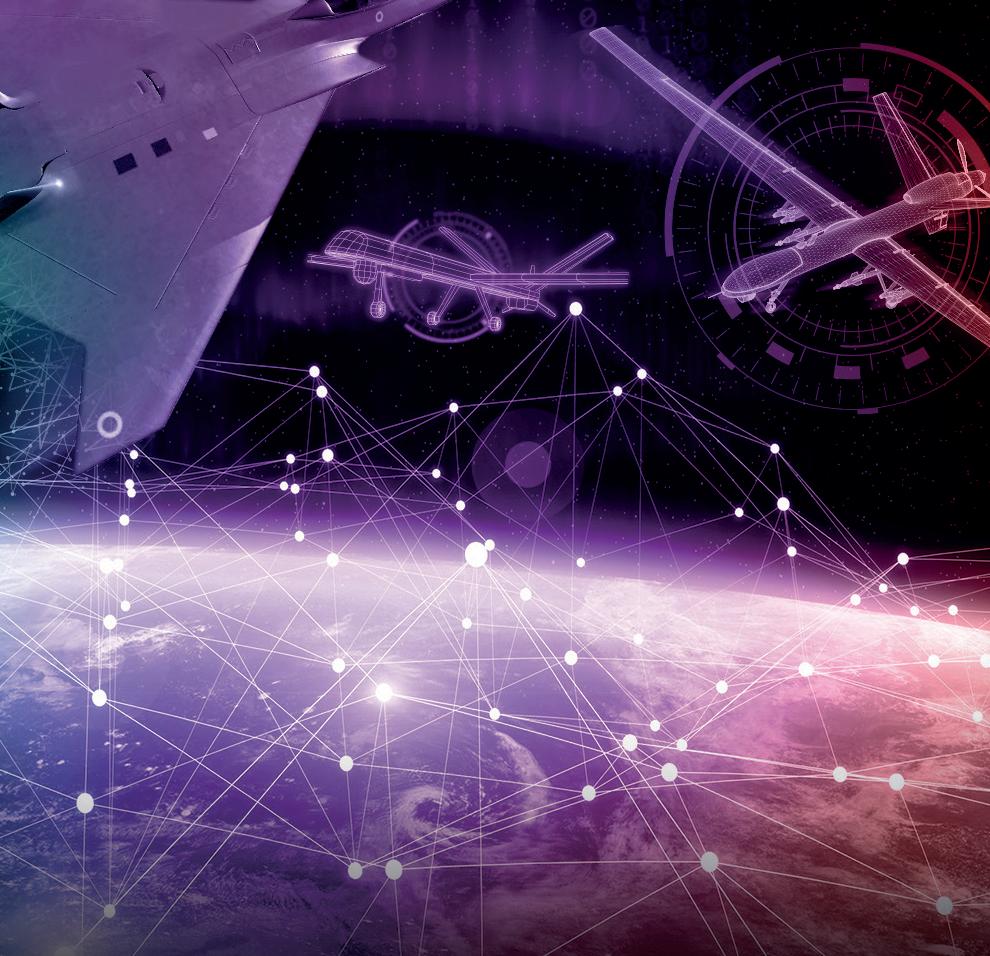



RAF Lossiemouth is preparing support facilities for the three E-7A Wedgetail airborne early warning and control aircraft that are due to join the front-line Typhoon QRA and Poseidon MPA squadrons based there from 2024. The RAF’s E-7A Programme Manager, Wing Commander Ben Fletcher, tells David Hayhurst how their introduction will enhance the air base’s already signi cant strategic importance to UK defence
Already one of the most strategically important air elds in Western Europe, RAF Lossiemouth will soon host what has been described as the most advanced, capable and reliable Airborne Early Warning and Control (AEW&C) aircraft ever developed: the E-7 Wedgetail AEW Mk1. With its 2024 in-service date fast approaching, the rst of the three currently scheduled Wedgetails will be housed in a new purpose-built facility at the Scottish base, located alongside the recently delivered Atlantic Building, from which RAF Lossiemouth’s eet of nine Poseidon P-MRA1s presently operate.
“The RAF is planning to operate and support Wedgetail alongside Poseidon at RAF
Lossiemouth to maximise the synergies associated with the common Boeing 737 airframe,” explains Wing Commander (Wg Cdr) Ben Fletcher, the RAF’s Wedgetail Programme Manager.
The aircraft will operate out of the same hangar space as Poseidon, be supported by a joint engineering unit and utilise capacity within the Atlantic Building as the new No 8 Squadron Headquarters,” he adds. “The technical infrastructure to house Wedgetail simulators and planning and operational support facilities are under construction. A high standard of living accommodation is also being provided to support the growth of the future force at RAF Lossiemouth.

The Wedgetail has been in service with the Royal Australian Air Force (RAAF) for over a decade,
To gain synergies with the P-8A Poseidon, which is also based on a Boeing 737 airframe, E-7A Wedgetails will be housed alongside the Atlantic Building at RAF Lossiemouth in Scotland
(PHOTO: MOD/ CROWN COPYRIGHT)
RAF seedcorn crews have been embedded with RAAF E-7 aircraft to speed up the entry into service of RAF Wedgetails (PHOTO: MOD/ CROWN COPYRIGHT)
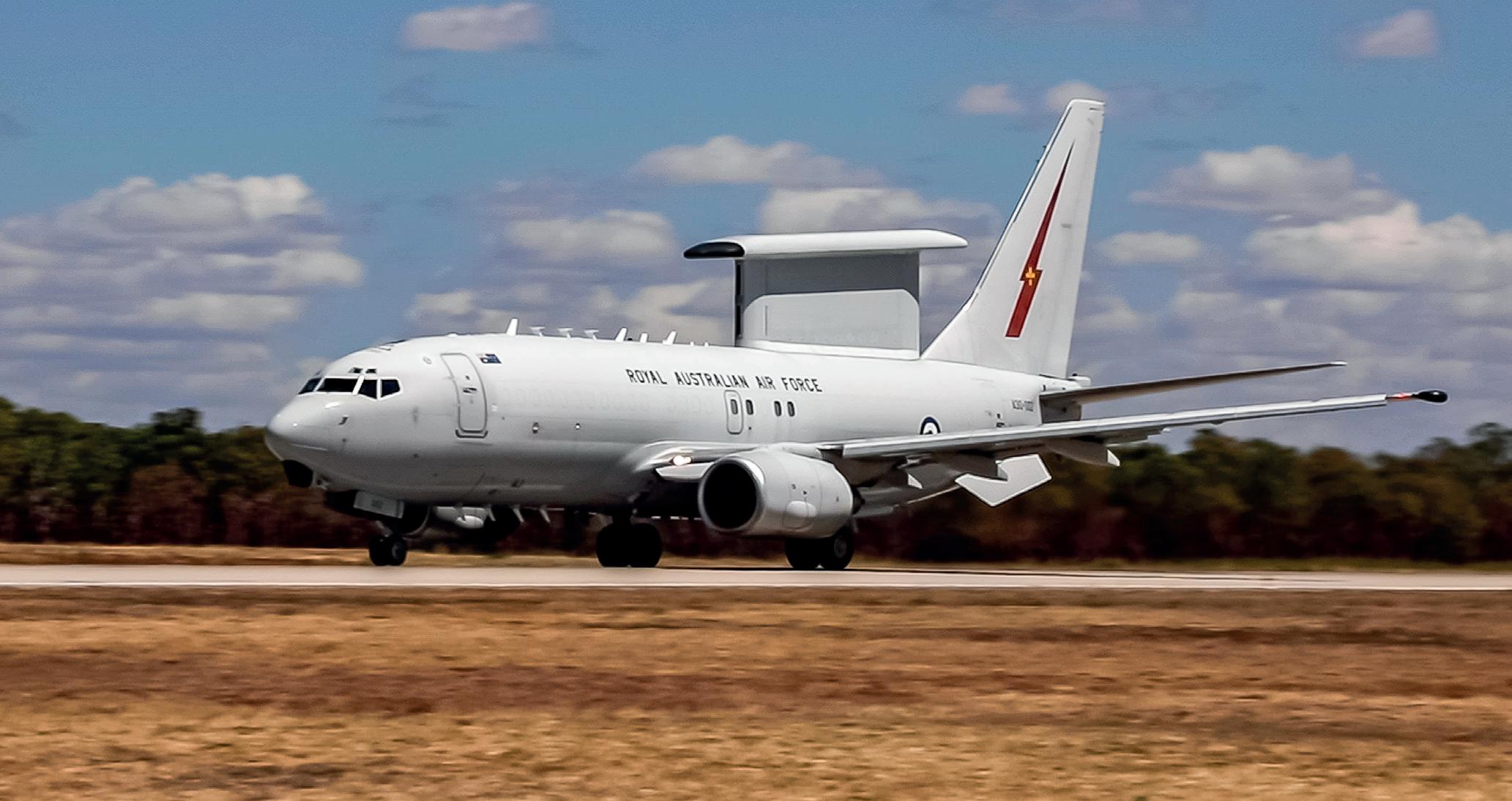
making invaluable contributions in both extremely long-range search and rescue operations – such as in the search for Malaysia Airlines Flight MH370 – and in sorties supporting coalition forces against Daesh in Iraq and Syria. The capability is crewed by two pilots and up to 10 mission crew who control the Wedgetail’s state-of-the-art onboard battle management technology, including the Multirole Electronically Scanned Array (MESA) radar system, that will provide the RAF with unmatchable fth-generation AEW&C capability.
The system enables the Wedgetail crew to track multiple airborne and maritime targets simultaneously, providing enhanced real-time situational awareness to UK and Allied forces’ ghter jets, warships and commanders on the ground. As Wg Cdr Fletcher explains, with a MESAbased system, “no longer is the capability reliant on a mechanically scanned system that requires a speci c time to rotate and revisit a target. The exibility provided by the mission system and MESA allows greater focus on the areas of battlespace that are of greatest importance, while providing 360-degree coverage, should it be required”.
“The range and exibility of the MESA system enables it to see far beyond the radars of ghter aircraft. The earlier detection of the enemy will result in an earlier engagement, increasing the lethality of our forces. The earlier detection also allows defensive action to be taken much sooner, increasing the survivability of Allied forces in the air, at sea or on land.”
In fact, the RAF has been at the centre of Wedgetail-related projects for several years, including through joint Anglo-Australian, anti-ISIL military operations in Iraq and Syria as part of Operation Shader. Likewise, recent so-called ‘seedcorn’ training projects, involving RAF crews being embedded with the RAAF Wedgetail eet, have provided vital experience, furthering appreciation of what Wedgetail will o er the RAF ahead of its imminent air eet integration.
So far, joint RAF-RAAF seedcorn training operations have involved RAF pilots, mission crews, engineers and mission support sta who “will become the foundation of No 8 Squadron at RAF Lossiemouth,” explains Fletcher. “The Air Capability Programme team, Defence Equipment and Support and the ISTAR Force Headquarters have been continually engaged with this team to build learning into the culture of the programme. Overall, the RAAF experience with Wedgetail is very positive and has resulted in highly reliable, world-leading operational output at home and deployed overseas.”
Moreover, the US Air Force’s declaration in 2022 that the E-7 Wedgetail will be a major part of its e orts to gradually replace its AWACS eet may prove to have a profound e ect on the future of joint Australian/ UK/US capabilities, especially across the Indo-Paci c region. The three countries are engaged in regular capability-focused trilateral working groups, with the combined aim of enhancing the operation and sustainment of the individual eets. “Understanding the future threat, wherever that may present itself, is critical in providing focus to combined future operational objectives,” concludes Wg Cdr Fletcher.
Peter Round, President of the Royal Aeronautical Society, explains why the RAF must be a leader in Tempest, as well as a driver of a UK national space e ort, in order to project air and space power

Over the past 12 months, one of the most important goals of the Royal Aeronautical Society (RAeS) has been ‘looking after young prospects to bring them into our sector and sustain them thereafter’. This is key to projecting air and space power in the 21st century. If the RAF has global ambitions, and I believe it does, then it needs that key component – the right people.
With Air Cadets (supported by the RAeS of course), the RAF is well placed to grow its human component from a very early age. However, it needs people from all ages and backgrounds, and often the very best make the decision to join much later in life. Once the key human component is secured, then we can turn to the other aspects of capability.
Air power is a never-ending race. If the aim is to only guard your backyard, then an examination of the risks and threats in the region quickly de nes the required capability. However, if you want to range over the whole planet, it’s a lot more complicated and a lot more expensive.
Assuming we have a need, we can a ord it, and the politicians have decided that we should be in the ‘race’, then we need a horse to ride. That horse, right now, is the Global Combat Air Programme’s (GCAP’s) Tempest. After all, worldwide ambitions require worldwide partners. Going it alone is too expensive and too narrow. Yet there must be ambition for more partners beyond Italy and Japan. Could we avoid the outcome of the 1980s’ Future European Fighter Aircraft (FEFA), which led to two aircraft – Rafale and Typhoon – by merging Tempest and the European Future Combat Air System (FCAS)? Either way, if the RAF is to project air power worldwide, it must be a leader in a major combat air system programme.
cognisant that almost any adversary will have access to at least some space data. But, to really be in space, you must be able to get there. Launch is, therefore, a key enabler, and if the UK is to have a credible and reliable space capability, it must be able to access space without the help of a third party.
We should not forget that, even though space is inherently global and brings great credibility to a nation, it is an enabler not a deterrent as it is largely invisible, except to a few specialists. Moreover, the task that any space craft carries out is not obvious to Earth-bound observers and, like it or not, space is dual use.
We must not forget that Tempest is a system, not an aeroplane, and it is vital to the UK defence industrial base.
Space is becoming more accessible and a ordable, despite still being technically di cult. This means that, today, the exclusive club of the ‘space capable’ is getting bigger and now includes actors who are not even nation states. A global power must have a space capability and must be
The RAF is, quite rightly, part of the UK space e ort, yet it is not the sole actor. In space, the RAF can only be part of a national e ort that includes all three services and the UK Space Agency, as well as commercial actors. The RAF is a key player in UK Space Command, and the UK is one of the few space nations projecting space power around the globe. This is a position the nation must strive to maintain, along with its leadership in combat air.
“Even though space is inherently global and brings great credibility to a nation, it is an enabler not a deterrent”
Due to enter service in 2024, the MQ-9B Protector RG Mk 1 will o er a step change in capability from the MQ-9A Reaper it replaces. Group Captain Rob Barrett, the ISTAR Force Headquarters Deputy Head of Capability, reveals how the aircraft will complement the extraordinary capabilities of the ISTAR Force Protector’s onboard systems will enable it to y out to where it is needed, rather than being transported as freight, thus speeding up its operational use
(PHOTO: MOD/ CROWN COPYRIGHT)
The RAF is procuring the MQ-9B Protector to replace the Reaper remotely piloted air system (RPAS) that has operated with such great success throughout the past 16 years. The RAF will be the rst user of Protector, which is manufactured by General Atomics Aeronautical Systems Inc. (GA-ASI) in California, when it enters service in 2024 at RAF Waddington. The delivery programme is now well advanced. The rst two of the RAF’s eventual eet of 16 aircraft have been delivered and are undergoing acceptance and testing by the manufacturer in the US. The rst certi able ground control stations (CGCSs) have

been built and the rst STS (synthetic training system) simulator is already in use at GA-ASI’s training facility at Grand Forks in North Dakota.
Training the people who will operate the new aircraft has also started. The rst 20 engineers who will maintain the aircraft completed their training in February 2023, and the rst squadron of aircrew started their conversion course on 1 May 2023. While the skills needed by Protector’s three-person crews are similar to those needed to y Reaper, the approach to maintenance is very di erent. Unlike the older aircraft, Protector will be maintained by uniformed engineers. Also, in a
departure for the RAF, Protector technicians will all combine the traditional roles of weapons, avionics and mechanical technicians, signi cantly increasing the capacity and exibility of the engineering workforce.
Like Reaper, Protector is a exible platform. Its primary sensor is an MTS-D electro-optical and infra-red camera turret, providing high-de nition video that is monitored in real time by the crew and disseminated for exploitation by imagery analysts. The system also provides designation for laser-guided weapons. Protector will have a ground moving target indicator (GMTI) and synthetic aperture radar (SAR) for wide-area ground
surveillance, combined with a maritime wide-area scan (MWAS) mode for a speci c maritime capability.
Unlike Reaper, Protector will be armed with UK-made weapons – MBDA’s Brimstone 3 missiles and Raytheon UK’s Paveway IV bombs provide complementary capabilities against ground targets. Both weapons have laser guidance (Paveway IV can also be GPS-guided), giving Protector a proven precise, low-collateral strike capability from a common weapons stockpile that can be shared with Typhoon and Lightning.
Whilst Protector’s sensor and weapons t is similar to that of its predecessor, it is the wider aspects of the programme that provide the real step-change
Protector’s missions will be controlled from the certi able ground control stations (CGCS) housed at RAF Waddington (PHOTO: MOD/ CROWN COPYRIGHT)

Protector has an automatic takeo and landing system, removing the need for a dedicated launchand-recovery element at the operating location
(PHOTO: MOD/ CROWN COPYRIGHT)
in capability. Sensors will be networked in a way that allows analysts to process, exploit and disseminate intelligence much more e ectively than with Reaper, while the new platform’s very long endurance – up to 40 hours – will give the RAF a capability to maintain round-the-clock surveillance of a point or area.
Protector squadrons will also be larger, a ording aircrew the time to make use of the STS, including its linkages into the Gladiator Collective Training environment, to train and rehearse in a much wider range of missions in a global, rather than regional, theatre. These enhancements will allow the RAF to grow the skills to conduct search and rescue, close air support and strike missions, as well as the core intelligence, surveillance and reconnaissance (ISR) tasks in support of UK and partner Services and civil authorities.
However, perhaps Protector’s most important attribute is that it is a ‘certi able’ aircraft. The higher level of assurance of the safety of the entire system –aircraft, satellite link and control stations – will free Protector from the most limiting constraints of its predecessor. On delivery, the aircraft will have a tra c collision avoidance system (TCAS) and Automatic Dependent Surveillance-Broadcast (ADS-B), allowing operation in Class A and C civil airspace, as well as in segregated areas. In due course, the eet will be tted
with due regard radar (DRR), unlocking the ability to operate in all classes of airspace, including Class G.
Protector also has an automatic take-o and landing system. This does away with the need for a dedicated launch-and-recovery element at the operating location; instead, the entire mission will be controlled from the CGCS at RAF Waddington. This greatly increases Protector’s exibility, enabling it to self-ferry to any operating location at very short notice, ready to deliver e ect wherever it is needed.
More widely, the UK has also developed the MQ-9B International Cooperative Programme (MICP), a community of nations procuring or interested in procuring MQ-9B. Currently at eight nations, the MICP seeks to share costs across the community of MQ-9B users and develop capabilities together to mutually enhance each nation’s platforms and support NATO, European and global alliances.
These combined capabilities and characteristics explain how Protector amounts to much more than a like-for-like replacement for Reaper. Improvements across all the Defence Lines of Development add up to a signi cant increase in the RAF’s mediumaltitude, long-endurance (MALE) RPAS capability that will play a vital part in the ISTAR Force’s ability to provide commanders with time-sensitive multidomain intelligence, surveillance and reconnaissance and precision attack capabilities from the air in the coming decades.

 UK Director of Operations (Protector), General Atomics
UK Director of Operations (Protector), General Atomics
When and where did the RAF accept its rst RG1 (MQ-9B) Protector remotely piloted air system (RPAS)?
The rst Protector aircraft, which has the military tail number PR005, was formally accepted by Air Vice-Marshal Simon Ellard at General Atomics’ Desert Horizon ight operations facility last September. The rst two Certi able Ground Control Stations and a Synthetic Training System were also installed in our Flight Test and Training Centre at Grand Forks, North Dakota, in advance of the rst RAF Operational Conversion Course commencing in May this year.
What preparations are being made at RAF Waddington ahead of the rst UK delivery in 2023?
Unsurprisingly, preparations continue apace. The rst 20 Protector technicians
from 31 Squadron have completed their training in Desert Horizon and are now chomping at the bit to get their hands on their own aircraft. They should take full control of their aircraft hangar in October, and I fully expect to see a huge Goldstar emblazoned on this facility before the dark nights of winter close in, o cially con rming its readiness for Protector’s introduction to UK service! RAF Waddington’s communications network is being upgraded to ensure robust and resilient data links can support safe ying operations while other facilities are being prepared to house the Ground Control Stations, simulators and spare equipment. Plans for the construction of additional single living accommodation are rming up, and RAF personnel have worked with the Civil Aviation Authority and other airspace users to plan changes to the local airspace structure that will facilitate Protector departures and recoveries from this historic base.
How will the International Training Centre bene t UK and partner air forces, and when will it be operational?
In joint and coalition warfare, interoperability is key, and we hope that a UK International Training Centre will be an essential element of GA’s strategic partnership with the RAF and other nations. While we will still o er MQ-9B customers the option to train their personnel in our US facilities, RAF Waddington’s location in the heart of the Euro-Atlantic region, proximity to excellent training areas, and the RAF’s proven expertise in delivering RPAS
operations makes it an attractive option, especially for NATO partners who want to develop their tactics, techniques and procedures alongside the RAF. Subject to ongoing commercial discussions, we would hope to see military and civilian instructors training UK and international personnel alongside each other in 2025.
Why will the introduction of the Protector in 2024 represent a game-changing moment in UK Defence capabilities?
Protector’s introduction to service will herald the rst of many milestones in aviation history. It will be the rst certi ed RPAS own by any military force in the world, the rst RPAS equipped with an automatic take-o and landing capability to be operated from UK soil and, once the initial weapons trials have been completed, the rst RPAS cleared to carry and release UK-manufactured weapons.
It will be able to y for much longer than Reaper – a warhorse that has already given the RAF almost 16 years of imperious service – and, downstream, once the full Detect and Avoid capability has been integrated, it should operate seamlessly in all classes of airspace. Then, rather than boxing the air vehicle for transit as we do with Reaper today, Protector should be able to y directly to an overseas air eld if the operational situation necessitates, delivering responsiveness in hours instead of days. All of that, never mind future upgrades that we are discussing with the UK and other potential customers, is both game-changing and hugely exciting.
This year, the Italian Air Force celebrates its rst centenary and, among other events, last May it organised the international AeroSpace Power Conference in Rome. This symposium sought to deepen our understanding of the third dimension as the quintessential operational environment for air forces worldwide. Thanks to technological progress, today that environment extends from the earth’s surface to outer space. Indeed, over the past decades, technological innovation has been incredibly transformative in two complementary ways.
Firstly, it has dramatically increased the altitude of the vertical dimension – hugely expanding the volume of airspace and outer space that advanced air and space forces have to secure and protect. Hence the need to ‘reshape space’.
Secondly, new weapon systems have been developed, which Western air forces have to address in order to defend their citizens and territories. This is particularly true of hypersonic missiles and glide vehicles, which require a much faster reaction time than current missile systems. Hence, the second need to ‘reshape time’.
Metaphorically and physically, space and time combine into speed, which demands responsiveness. Time is key for air and space forces, distinguishing them from other military instruments of power.
Some 100 years after the creation of the Italian Air Force, air and space

power is more relevant and disruptive than ever. In fact, it seems to know no boundaries as it continuously expands. For Italy, one of the most viable solutions to this expansion is the Global Combat Air Programme (GCAP). Just as the F-35 enabled our air force to be the rst in Europe to start developing new ways of interpreting the battlespace, the GCAP will allow the Italian aerospace and defence industry to reinterpret the way we design aircraft or, more pertinently, systems of systems.
This is the rst and most important bene t of the programme, especially in view of future European joint procurement.
The second is, just as the F-35 strengthened our transoceanic bond and highlighted our pivotal role in Europe – as witnessed by the Cameribased Trivalent Regional Hub, which builds F-35s at no extra cost to European customers – GCAP will build on our international geopolitical standing to reinforce our Indo-Paci c link. In other words, we are going global.
And thirdly, GCAP will diversify our ghter portfolio, giving our aerospace industry the chance to compete in global markets and capitalise on the nancial and human resources we have been investing in over the past few years. Moreover, we are keen for a seamless integration – in terms of interoperability – with other future weapon systems like NGAD and SCAF: having multiple types of aircraft should not be seen as a lack of (industrial) cooperation, but
rather an improved level of resilience and an increased complexity for our opponents to manage.
Finally, GCAP will help us transition into actual e ects integration on the battle eld, a step forward from domain integration – the so-called Joint All-Domain Operations.
Diversi cation of the combat air portfolio and e ects integration lead to another centrepiece of air and space power: interoperability. In a future complex scenario, the latter is unachievable if the former is not built on strong interoperability at the design level. For example, when we rst acquired the F-35, all e orts went into exploiting fthgeneration niche capabilities to boost the fourth-generation e ects made available by the Typhoon.
Initially, Typhoon was not interoperable in contested or denied scenarios, and a considerable amount of software engineering was necessary to enable fourth-generation ghters – and other combat support assets within the Italian Air Force – to seamlessly integrate with the F-35 in complex missions. This must be avoided for sixth-generation systems: interoperability, like cyber resilience, must be considered at the early stages of the design process. GCAP fully takes this into account. Together with the UK and Japan, sharing the same core values, the same expertise, the same training and weapon systems, we represent a tremendous integrated force for decades – perhaps even another century – to come.
Air Commodore Ian ‘Cab’ Townsend, Assistant Chief of the Air Sta Capability Delivery
Combat Air, outlines the outstanding bene ts of the Typhoon’s next radar system –ECRS2 – and reveals how and when it will start making a di erence to UK war ghters
Recent operations in Ukraine have highlighted that control of the air remains a vital enabling function for any military operation. Ukraine has also shown how control of the air, as the most vital ‘Air Power’ role, is being challenged by evolving threats where use of the electromagnetic spectrum is becoming increasingly complex and the proliferation of ‘Di cult Air Targets’ demands an ability to target all sizes of adversary air platforms. Across the globe, the sensing, targeting and weapons capabilities of our potential adversaries are developing and proliferating rapidly. Therefore, it remains vital that the RAF’s Typhoons – the backbone of the UK’s Combat Air force – continue to evolve.
The European Common Radar System Mk 2 (ECRS2) is a new, advanced Active Electronically Scanned Array (AESA) radar that is critical to assuring Typhoon’s operational capability against
an increasingly challenging threat. Operational from 2030, ECRS2 will o er greatly enhanced air-to-air and air-to-surface performance on 40 Tranche 3 Typhoon aircraft. It will be capable of Electronic Warfare (EW) and Electronic Attack (EA), providing an e ective means of suppressing enemy air defences, and greatly increasing Typhoon’s operational potency. ECRS2 will enhance Typhoon’s ability to operate through and within contested environments, and will also underpin its utility within the UK’s future force mix. ECRS2 will preserve interoperability with F-35B Lightning, E-7 Wedgetail and other Allied platforms by enabling it to operate alongside them, providing collective defence, sharing real-time data and increasing both complexity and mass to defeat our adversaries.
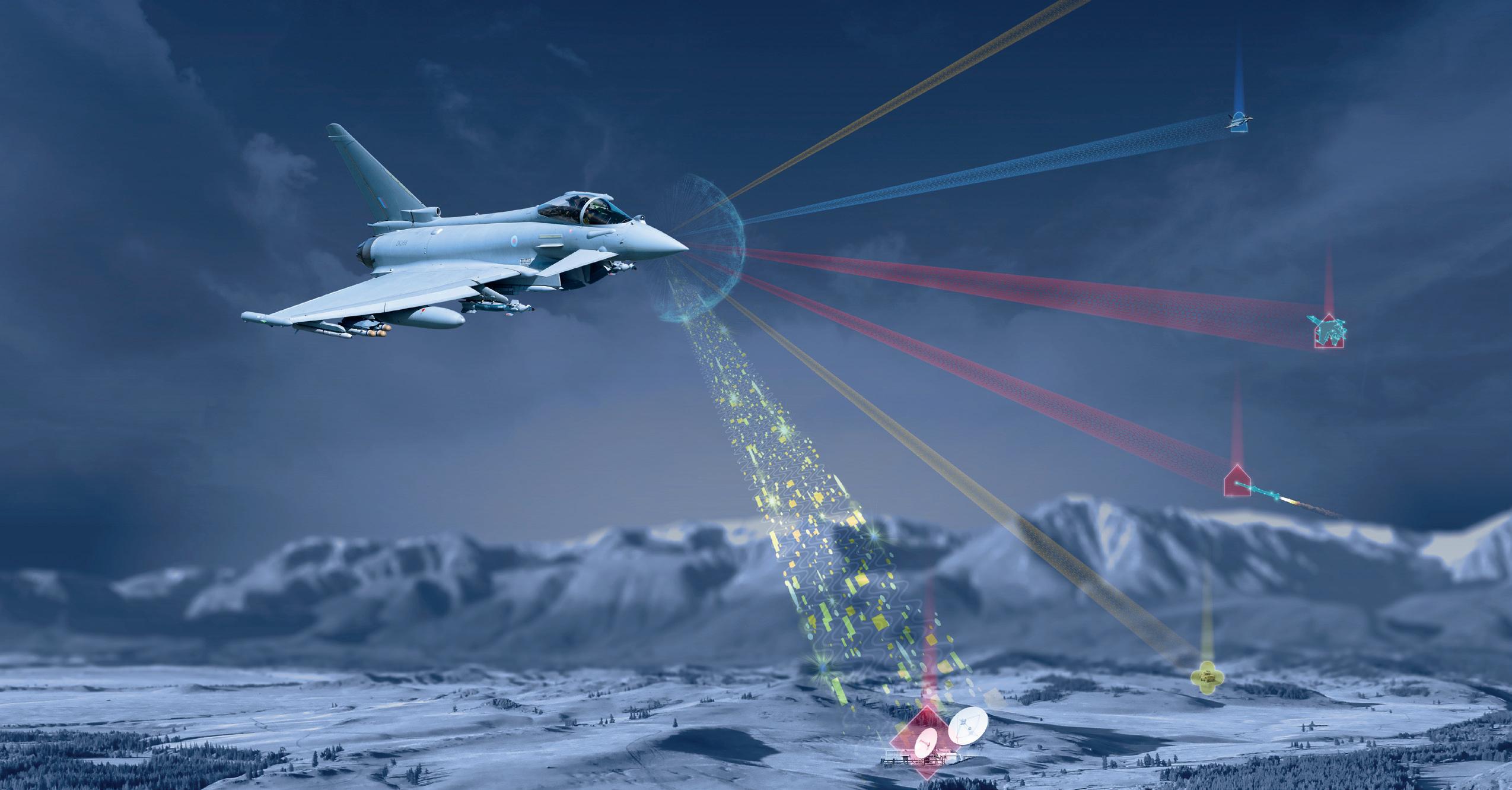
With open architecture at the heart of its design, spiral upgrades to software and rmware will enable ECRS2 to sustain its operational advantage.
The ECRS2 AESA radar will be installed on 40 Tranche 3 Typhoon fast jets delivering enhanced air-to-air and air-to-surface combat capability (PHOTO: MOD/ CROWN COPYRIGHT)
Leonardo UK is developing the ECRS2 AESA radar, which will be integrated into the Typhoon aircraft by BAE Systems

(PHOTO: MOD/CROWN COPYRIGHT)
Within the Typhoon Mission Support Centre, the UK has already developed a world-class approach to the design and optimisation of mission data delivered with speed and responsiveness. This will become ever more important as the agile generation of mission data, potentially on a sortie-by-sortie basis, is how ECRS2 will outpace our adversaries.
ECRS2 is also part of the critical path to the Future Combat Air System (FCAS). The algorithmic technologies developed and proven through ECRS2 will contribute signi cantly to technology exploited within the FCAS programme. Moreover, ECRS2 development will assure access to the highly skilled workforce, both military and industrial, required to support such high-end technological development, with these personnel transitioning to FCAS in the future.
ECRS2 will also help to modernise the supply chain, supporting FCAS technologies and guaranteeing that vital components and materials are available for future capability development. In addition, the next-generation digital engineering, manufacturing and test and evaluation techniques from ECRS2 will pull through into FCAS and be a key part of the Global Combat Air Programme (GCAP) – a strategic partnership with Italy and Japan on FCAS – that was announced by the Prime Minister in December 2022.
Although ECRS2 is a UK-led endeavour, its functionality will be integrated into Typhoon via a Euro ghter core upgrade programme known as Phase 4 Enhancements (P4E). P4E not only
enables ECRS2, but also includes an innovative, intelligent operating philosophy known as Task Based Management (TBM). TBM fuses the mass of information being generated by ECRS2 more e ectively, aiding pilot situational awareness and enabling faster, more accurate decisionmaking. Beyond the core programme, ECRS2 and P4E will make Typhoon a more marketable and competitive platform in the export market, not only for the UK’s established Typhoon partners of Saudi Arabia and Qatar, but other potential nations looking to update their older combat air eets.
Progress is rapid. P4E and ECRS2 secured nancial approval for £2.3bn in April 2022 and are now established as part of the Government Major Project Portfolio (GMPP). A prototype radar has been delivered to start early integration into the aircraft, and a contract has been agreed with industry partners BAE Systems and Leonardo UK to complete development of the production standard ECRS2 over the next ve years.
The forthcoming year also represents a key period for P4E as it enters the Systems De nition phase. This will select and re ne the precise capabilities across the four-nation partners that will be taken forward into the upgrade, alongside ECRS2 embodiment.
It is an exciting moment for an endeavour that sits at the cutting edge of technology, vital to UK Combat Air and our defence industry, enabling us to secure our skies, and those of our strategic allies, throughout the forthcoming decades.
How do these characteristics improve the Typhoon’s availability and performance capabilities?
Gerhard Bähr Chief Executive O cer, EUROJET Turbo GmbH
What makes EUROJET’s EJ200 a cost-e ective and easy-to-maintain engine?
The EJ200 design and architecture is very di erent to its competitors in that it comprises 15 separate fully interchangeable modules. Consequently, repair and maintenance work can be focused on only those modules that require inspection and possible work, without having to disassemble all modules. This is a tremendous advantage, as it reduces the e ort required and leads to quick turnaround times, plus not every module requires the engine to go back to the test bed after repair.
Another huge factor is that the EJ200 is operated on an ‘on-condition’ basis for maintenance and repair, instead of xed-term scheduling. A healthmonitoring system tells the operator when the engine requires work, avoiding any wasted time, e ort and resource, and maximising availability.
Our customers’ own eet statistics do the talking for us and show that they are delighted with the EJ200. For example, having delivered over 1,400 engines, which is very impressive for a European military programme, those engines have accumulated in excess of 1.5 million engine ying hours. Perhaps the key metric is that the mean time between removal (MTBR) for the engine is approximately 1,200 engine ying hours. This is impressive and many times better than other engines in the same class, especially those of a previous generation, such as the RB199 that powers the Tornado.
As part of the NETMA structure that oversees the Typhoon programme, EUROJET coordinates the EJ Partner Companies (Rolls-Royce in the UK, MTU Aero Engines of Germany, Spain’s ITP Aero and Avio Aero of Italy) in the alignment of common service goals and delivery plans. This means that individual operators such as the RAF bene t not only from their own operational experience, but also from those of the other partner nations. Add the export customers to this and the RAF gains additional insights into how the engine performs when operating in considerably di erent and, sometimes, harsher environments than those found in the UK. In short, EUROJET plays an
integrating role between industry and NETMA, the national operators and the national ministries of defence in the sharing of ideas and experiences. Without doubt, this will continue to be of immense value to the RAF as it addresses the challenges of the future.
In addition, the EJ200 is also a technology provider and probable demonstrator for future-generation ghter aircraft, such as the Franco/German FCAS and multi-national GCAP. This technology progression delivers perfect synergy with the ongoing further enhancement of the EJ200, enabling those future programmes to reap the bene ts of the lessons we are learning today.
Enhancements resulting from Euro ghter’s long-term evolution (LTE) plan will most likely lead to new or modi ed mission pro les that will probably increase the weight of the aircraft. The aircraft will require more thrust, so EUROJET is part of that LTE vision. Accordingly, we have provided NETMA with a set of evolution proposals related to the engine control system and the engine’s hardware, which are currently under review.
Most prominently, we have developed designs for a two-parametric nozzle that will bring bene ts in thrust and fuel consumption. This is still in the pre-development phase and has to be agreed by NETMA and the Nations, but, once launched, I expect embodiment in the second half of the decade.
largely driven by the fact that we’re not starting from scratch. The F135 is a proven engine with more than 600,000 safe ight hours. We’re going to leverage the current programme’s existing production capacity, and that means nearly 70% of our parts will remain the same.
need to counter advanced threats, and that’s squadrons of Block 4-enabled jets across the globe by the end of the decade. Upgrading the engine makes that possible.
Jen Latka Vice President, F135 Programme, Pratt & Whitney
What makes the F135 Engine Core Upgrade the better, more cost-e ective approach to modernisation when compared with putting a brand-new adaptive engine on the jet?
To answer that question, you must rst re ect on the last decade of the F-35 programme. The airframe and its payloads have had three major upgrades (Blocks 1-3), but the engine is still in its original con guration. That’s particularly interesting because the engine has been pushed to operate well beyond its original speci cations from the beginning.
It’s common to upgrade an engine to pace modernisation e orts happening elsewhere on the jet. With the next round of upgrades on the horizon (Block 4), an engine upgrade is a logical next step in the programme’s maturation. Upgrading is the far superior option from both a cost and timeline perspective, and that’s
It’s di cult, if not impossible, to justify the time and expense it would take to re-engine the F-35. That is ultimately why the US Department of Defense chose to upgrade. When national security needs are on the line, you can’t introduce signi cant amounts of risk to a programme that’s essential for the collective success of the US and key allies around the world.
It takes far less time and money to integrate the Engine Core Upgrade into the existing F-35 eets because it’s a “drop-in” solution that doesn’t require major modi cations to the airframe. We can upgrade the engines quickly at any one of the F135’s existing maintenance, repair,
The Engine Core Upgrade will improve power and thermal management capacity and enable the full suite of Block 4 capabilities for all variants of the F-35. That means all F-35 international partners will eld the same engine.
If time and cost were no object, we could take decades and spend billions to establish a new global sustainment network to support a new second engine, but that’s just not reality. Our customers are clear about what they
overhaul and upgrade depots worldwide. Pratt & Whitney engineers are containing the upgrade to only the power module, which is the engine’s core. The less we change, the less risk we introduce into the jet. By focusing on the engine’s core, which operates at a high temperature, we’re able to help the jet meet its power and cooling needs in a targeted, more a ordable way.
All told, the Engine Core Upgrade will save F-35 operators $40 billion over the life of the programme, while delivering the critical capabilities that operators will need in the coming decades.
“Upgrading is the far superior option from both a cost and timeline perspective”
Air Commdore Howard Edwards, the newly appointed Combat Air Force Commander, tells Mark Daly how the RAF is enhancing the combat capability of the F-35B Lightning with a focus on HMS Queen Elizabeth’s visit to Norway as part of Operation Achillean in 2022, and a forward look to future carrier strike deployments
The short take o and vertical landing characteristics of the Lockheed Martin F-35B multi-role ghters are closely integrated with the Royal Navy (RN)’s Queen Elizabethclass aircraft carriers, which launch these aircraft over the bow ski-jump and recover them by vertical landings to the deck. Since the rst test landing of an F-35B on HMS Queen Elizabeth in September 2018, hundreds of landings and take-o s have been completed. and the roles and capabilities of the ghters deployed on carriers have steadily developed.

Pilots of the F-35B Force come from both the RAF and the RN, about 58% RAF and 42% RN. Both 617 and 207 Squadrons have now been led in turn
by an RN o cer in the rank of Commander and an RAF Wing Commander. This inherent jointness goes to the highest level of the Combat Air Force, which is headed by an RAF Air Commodore with a Royal Navy Captain as deputy.
F-35B weapons are the AIM-132 ASRAAM short-range and AIM-120 AMRAAM medium-range air-to-air missiles. For surface targets, the Paveway IV programmable precision weapon is carried. Launches of live Paveway IV weapons from 617 Squadron F-35Bs were made in 2021, when both strike warfare and air defence capabilities were tested.
The F-35B has successfully completed hundreds of landings onto the Queen Elizabethclass carriers (PHOTO: MOD/ CROWN COPYRIGHT)
The Lightning Force, which includes 207 OCU Squadron, is based at RAF Marham in Norfolk (PHOTO: MOD/ CROWN COPYRIGHT)
Much of the capability growth for the F-35B is planned through new generations of weapons. On current plans, the rst will be the ASRAAM Block 6 standard, due in 2024. Beyond this lies Spear 3 (Select Precision E ects at Range), a development of the Brimstone air-to-surface missile powered by a jet engine launched at ranges approaching 150km. Meteor is a beyond-visualrange air-to-air missile made by MBDA, expected on the F-35B later in the decade. Most of these weapons are carried within an internal weapons bay, as the F-35B has stealthy, or low-observable, characteristics in terms of its own radar signature. Other elements of its capability are quite invisible. The F-35B’s powerful AN/APG-81 radar is the primary sensor, a multi-mode system capable of seeing, listening and jamming. This enables several capabilities including the multirole suppression of enemy air defences, an important role for this fth-generation fast jet.
In 2020, the RAF’s 617 Squadron embarked operational Lightnings on HMS Queen Elizabeth for the rst time, returning to the carrier later in the year to operate alongside visiting US Marine Corps F-35Bs. In January 2021, the Royal Navy formally declared initial operating capability (IOC) for the UK Carrier Strike Group, and HMS Queen Elizabeth and her xedwing air group deployed to the Indo-Paci c region from May to December 2021 on Operation Fortis.
In November 2022, F-35B Lightnings again deployed to HMS Queen Elizabeth for exercises over the North Sea, as part of Operation Achillean. Part of this was classed as Joint Expeditionary Force Air Operations activity when Norwegian F-35As carried out simulated air attacks against the Carrier Strike Group and the 617 Squadron jets defended.
Interoperability between the RAF, Royal Norwegian Air Force, Royal Netherlands Air
Force and United States Air Force (Europe) F-35s was also tested during Operation Achillean. More Paveway IV drops were carried out during a Trilateral Large Force Exercise in Norway, where the precision weapons were guided and controlled by Norwegian troops operating as forward air controllers.
Operation Firedrake, planned in 2023 in the North Atlantic, is scheduled to test F-35B multirole capabilities. Key components will once again be close integration with Northern European NATO allies, demonstrating fth-generation interoperability and continuing to build on the Carrier Strike Group Initial Operating Concept.
During 2023, the UK’s F-35B Force is being developed with the formation of 809 Naval Squadron, initially with eight aircraft, building to 12. These aircraft are based at RAF Marham in Norfolk alongside 617 Squadron. No 207 Squadron at Marham is established as the Operational Conversion Unit (OCU), fully equipped with 12 aircraft.

There are no two-seat trainer versions of the F-35. In future, the wing of aircraft will be shared across the operational land-based and carrierbased squadrons and the OCU. F-35B carrier training is completed in high- delity simulators at both RAF Marham and a facility located at BAE Systems, Warton. Once embarked, the Lightning Force has the capability to conduct synthetic mission rehearsal and currency training by using deployable mission rehearsal trainers that are embarked in the Queen Elizabeth-class carriers.
Forthcoming deployments of F-35Bs, possibly on HMS Prince of Wales in 2024-25, are expected to explore the usefulness of shipborne rolling vertical landings, which have the potential to enable carrier landing operations at higher aircraft weights. Another test will be operating ghters held poised at readiness to launch in a quick reaction alert, as an alternative to ying combat patrols.


The F135 Engine Core Upgrade—the faster, lowest-risk option with $40B in lifecycle cost savings. And it’s the only solution that leverages the deep expertise and broad capabilities of Raytheon Technologies. Pratt & Whitney is confident in its ability to engage in F135 Engine Core Upgrade related activities under existing framework for F135 export authorizations while maintaining its key international partnership and alliance approach. The F135 Engine Core Upgrade is the smart decision for the F-35. Learn more at prattwhitney.com/F135ECU

Russia’s aggression against Ukraine since February last year undermines the very foundations of the international order, not only in Europe, but also in Asia. Solidarity among countries that share fundamental values, such as Japan and the UK, has never been more essential under such circumstances. Facing the most severe and complex postwar security environment, Japan has recently formed several policy documents, including the National Security Strategy and the National Defense Strategy, that explicitly specify the importance of reinforcing cooperation with both our allies and as many like-minded nations as possible in order to ensure Japan’s security.
Looking back, although the Imperial Japanese Army Air Service’s aircraft were rst introduced from France, the foundation of the Imperial Japanese Navy Air Service was built by the UK Sempill Mission, which the Imperial Japanese Navy invited in 1921, and the expertise they brought extensively in uenced Japanese aviation technology thereafter. The Anglo-Japanese Alliance was dissolved two years later, but today, 100 years later, Japan and the UK are jointly developing a ghter aircraft. It is my great pleasure to witness Japan-UK relations become ever closer and stronger.
The joint development of the next-generation ghter aircraft by Japan, the UK and Italy allows the three countries to bring together their technological advantages, share the development costs and risks, and develop a sophisticated ghter aircraft
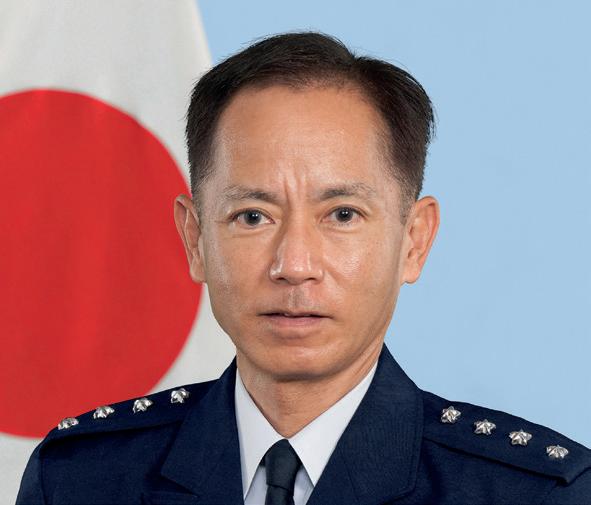
that ensures future air superiority. This initiative also encourages cooperation among industries of the three countries and will strengthen Japan’s defence production and technological bases through scale and the merits of increased aircraft production, and raising our next generation of internationally active engineers. I am expecting this trilateral cooperation between Japan, the UK and Italy, which share fundamental values and are allies of the US, to lay a foundation for a wider collaboration among the countries over many generations and greatly contribute to the peace and the stability of the Indo-Paci c region and Europe.
From the Japan Air Self-Defense Force’s (Koku-Jieitai’s) perspective, there are bene ts regarding interoperability I am expecting to see. One example is achieving earlier operational capability by sharing knowledge and know-how among the countries at the outset of its introduction and entry-intoservice stage. Moreover, by utilising the same equipment, interoperability in the operational phase should be enhanced to an unprecedented level. Speci cally, operational standardisation on areas such as combat techniques, tactics, procedures and training, and logistic cooperation on crossservicing and sharing of fuel and other consumables should enable enhanced interoperability.
Another bene t is enhanced people-to-people interoperability. It is obvious that, when people share fundamental values and the same equipment underpinned by the same mindset, they are likely to be
more con dent to cooperate with each other. I believe GCAP will bring about great bene ts at every level for fostering positive partnership.
The last bene t I would like to mention is the expansion of our potential global cooperation. The advanced capability of the future ghter should, of course, be appealing to our allies and like-minded partners around the world, but they should also nd the rm GCAP partnership we have among the participating nations very attractive. I believe that progress in GCAP will contribute to the enhancement of defence cooperation and exchanges among our global partners, as well as the expansion of the GCAP cooperative partnership itself. The strong collective commitment of Japan, the UK and Italy are the key in this sense too.
At a time when the principles of a free and open international order based on the rule of law are being threatened, and threats and acts of aggression are increasing, we need a strong security and defence partnership that is backed and strengthened by credible deterrence.
Japan, the UK and Italy are countries with world-leading aviation manufacturers, and these countries all embrace sophisticated industrial capacity and expert craftsmanship. I am convinced that collaboration among these countries with such strong a nity would lead GCAP to success. The KokuJieitai will remain determined to both support GCAP and advance air-to-air defence cooperation and exchanges with the UK and Italy in various elds.
The potential to harness the power of synthetic technologies has been at the heart of military ambition for decades. Lucy Walton, Head of Training for BAE Systems’ Air sector, explains how the company is leading the development of technologies that will train the military forces of tomorrow
The battlespace that military forces contest today is constantly increasing in complexity and competitiveness, driving a need to develop new capabilities and, also, new ways to train to gain a military advantage.
The need to harness technologies that can connect air, land, sea, space and cyber has never been greater and, with the emergence of new capabilities through programmes such as the Future Combat Air System (FCAS), there is a demand for expertise to integrate these into a next-generation training system.
“The virtual environment is playing an increasingly important role in everything from mission planning to mission rehearsal, from concept
development to decision making,” explains Lucy Walton. “While it has been known for decades that synthetic technologies hold huge potential for the training and preparation of future forces, advances driven by areas such as computer gaming and the medical industry mean the scope is now wider than ever before. When it comes to training pilots, there will always be a need for an irreducible level of live ying, but synthetics provide huge bene ts in areas including safety, a ordability and sustainability.
“When training pilots for life in a fast-jet cockpit, the airborne synthetics in an aircraft like Hawk allow us to simulate weapons rings, but, in training for operational readiness, modern
BAE Systems delivers training on platforms including Typhoon (pictured), F-35 and Hawk across the globe (PHOTO: MARK WRIGHT/ BAE SYSTEMS)

Project OdySSEy has created a military metaverse transforming the way military forces operate
(PHOTO: BAE SYSTEMS)
weapons require test ranges bigger than those currently available. Synthetics o er the ability to adapt to changing operating environments, such as increased weapons ranges.
“Harnessing this potential means aircraft can be performing their crucial role on the front line, and air forces are able to use synthetics to replicate the increasing complexity of the operating environment in the information era.”
Across the globe, BAE Systems holds a position at the heart of training pipelines for many of the world’s leading air forces, training over 450 aircrew and more than 6,000 aircraft technicians every year. On UK frontline programmes – including Typhoon, F-35 and Hawk – it delivers live and synthetic training today, and is working alongside international air forces to evolve requirements and provide the training and skills that are needed to maintain operational readiness.
In Qatar, it helps provide everything from English language training to skills required by the next generation of aircraft technicians, as well as delivering live and synthetic training to front-line pilots as part the joint Qatar-UK Hawk and Typhoon squadrons. In the Kingdom of Saudi Arabia the company also plays a unique role at the heart of the training pipeline – from identifying candidates through to front-line training. “This intimate relationship with our customers gives us close insight into their world, their challenges and how we need to anticipate changes coming down the line.” says Walton.
“In respect to FCAS, we’re involved at the centre of requirements for Tempest, which means we’re able
to think about the training requirements as we’re designing the aircraft and its systems – an important element to ensure Tempest is delivered by 2035.”
Over the past 12 months, BAE Systems has led a major research and development training initiative, Project OdySSEy, which has seen it develop a single synthetic environment that allows air, land, sea, space and cyber forces to plug in and train together, creating a ‘military metaverse’ unlocking a transformation in the way military forces operate.
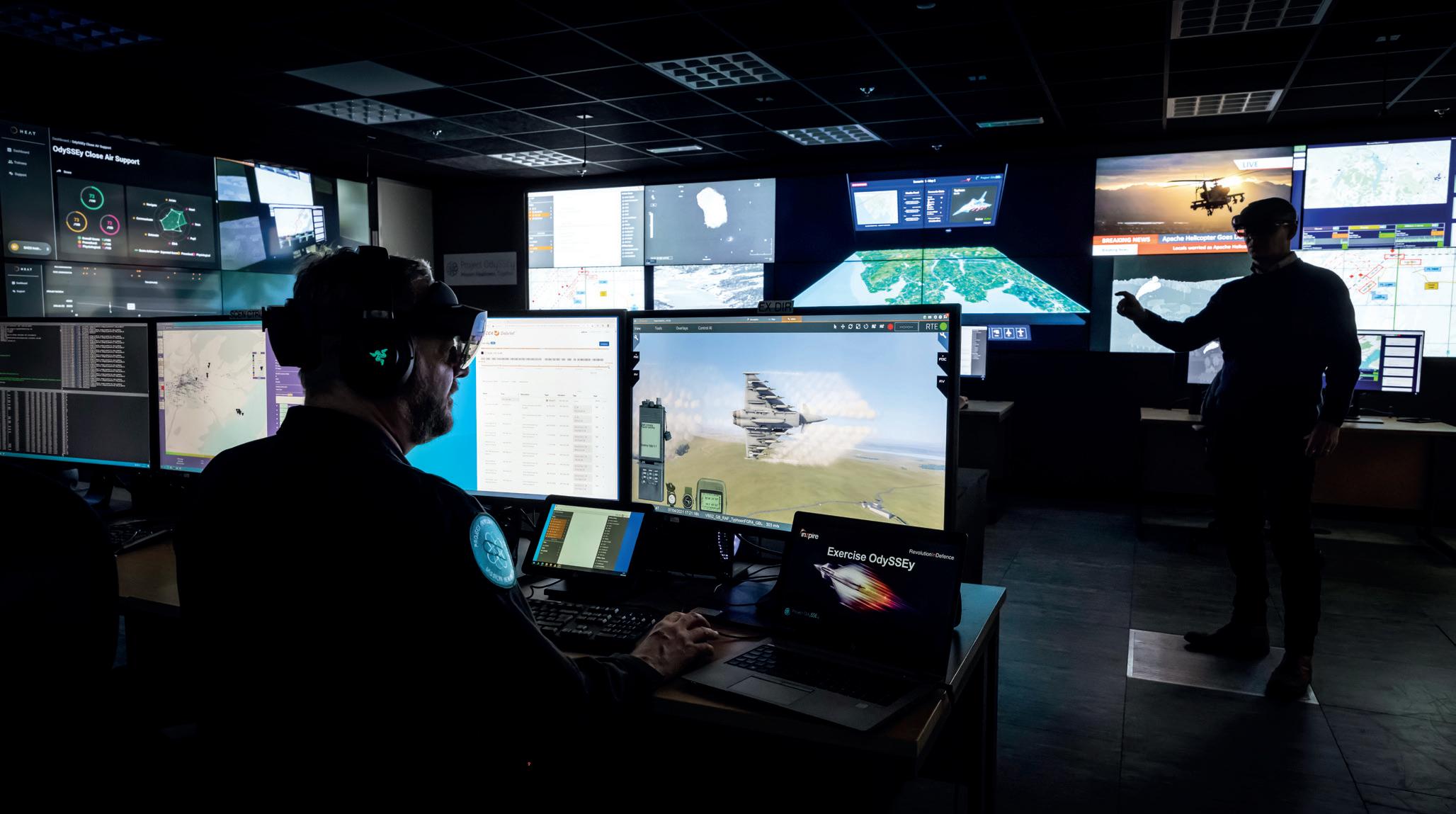
As a company with decades of military pedigree, BAE Systems is integrating technologies and expertise from a diverse range of companies – including military training specialists D3A Defence and Inzpire, simulation experts Bohemia Interactive Simulations and Pitch Technologies, and data science from VRAI and Hadean, the supercomputing rm that powers video game Minecraft™ – to harness technologies including data analytics and biometrics to augmented and virtual reality and machine learning.
“This has been a hugely successful project that has seen us deliver novel capability in less than a year, working with some really interesting and innovative companies,” explains Walton. “We are now working to develop it further with the battlespace of the 2030s and beyond in mind. If we enable our customers to conduct large-scale, complex training exercises synthetically – limited only by their imaginations – we can help them meet their a ordability, time and sustainability objectives.”
counter challenging new threats and rapidly manage a large amount of data. It will provide RAF aircrew with exceptional situational awareness, helping to establish the information superiority they will need to succeed in complex and contested battlespaces, as well as contributing valuable intelligence to other operators.
Clive Higgins Chair and CEO, Leonardo UK
As Defence moves from the industrial into the information age, a generational leap forward in technology that senses, engages and protects will be necessary for UK Forces to successfully compete against near-peer and peer threats.
This March, during the DSEI Japan exhibition in Tokyo, we were delighted to announce progress towards this goal. With our international colleagues, we unveiled the partnership to deliver the advanced electronics for the Global Combat Air Programme (GCAP). This will be known as the Integrated Sensing and Non-Kinetic E ects & Integrated Communications Systems (ISANKE & ICS) domain. The partnership has brought together the national industry champions from the UK, Italy and Japan to produce a deeply integrated sensing, fusion and self-protection capability for the sixth-generation GCAP core ghter.
ISANKE & ICS will allow the GCAP platform to see further, identify and
This will itself be a game-changing capability, but is also representative of Leonardo’s broader direction of travel. We are transitioning away from the traditional model of individual platformorientated sensors and e ectors, instead looking to provide deeply integrated systems of systems that can operate across a whole theatre of operations.
The bene ts of this research and development will not be limited to the future GCAP platform. Spiral development of GCAP capabilities back into Typhoon is an obvious next step, but Leonardo has also identi ed a number of areas in which we can exploit this research and development, and the technology building blocks we have created, in other applications and across domains.
For example, at our site in Yeovil, the home of British helicopters, we have the UK’s only onshore design capability for rotorcraft. This gives us the unique opportunity to exploit some of the deep integration work we are doing for ISANKE & ICS, as well as some of the underlying sensing and e ects technologies, baking them into future rotorcraft operational concepts.
All are underpinned by advances in core sensing and e ecting technologies that span the electromagnetic spectrum, from radio frequency (RF) to infrared (IR). As a founding member of Tempest, Leonardo UK is several years into this journey already; our position as our nation’s lead for ISANKE & ICS will allow us to bring these concepts and technologies to fruition at pace.
Meanwhile, in Basildon, Leonardo has been leading a cross-UK-industry team of experts to develop and trial a high-tech new protection system approach for army vehicles. With the same essential requirements as air platforms to sense, engage and protect, it is likely that a next-generation protection system for ground vehicles could incorporate some of the concepts and technologies currently earmarked for air combat. Furthermore, our systems-of-systems and distributed-sensing approach o ers very real opportunities in future land electronic warfare (EW) capabilities and maritime force protection.
We are deeply proud to be supporting the RAF in its future combat air journey. As we drive forward with GCAP, we expect to be able to reap the bene ts across Defence, contributing to information superiority across domains.
“We are deeply proud to be supporting the RAF in its future combat air journey”
Hisham Awad, the new Managing Director of Viasat UK, explains why an agile, adaptable development process is required when procuring satellite communication systems
Secure, reliable and ubiquitous connectivity is a vital component when executing military operations on today’s data-driven battle eld. Whether delivering critical intelligence to the front line, uploading sensor data for analysis or enabling the exchange of information between weapons platforms, communications technology can be the di erence between success and failure.
Satellite communications (SATCOM) are the backbone of this connectivity. However, to be e ective, SATCOM must be secure, resilient and adaptable enough to deliver the capabilities required for any given mission.
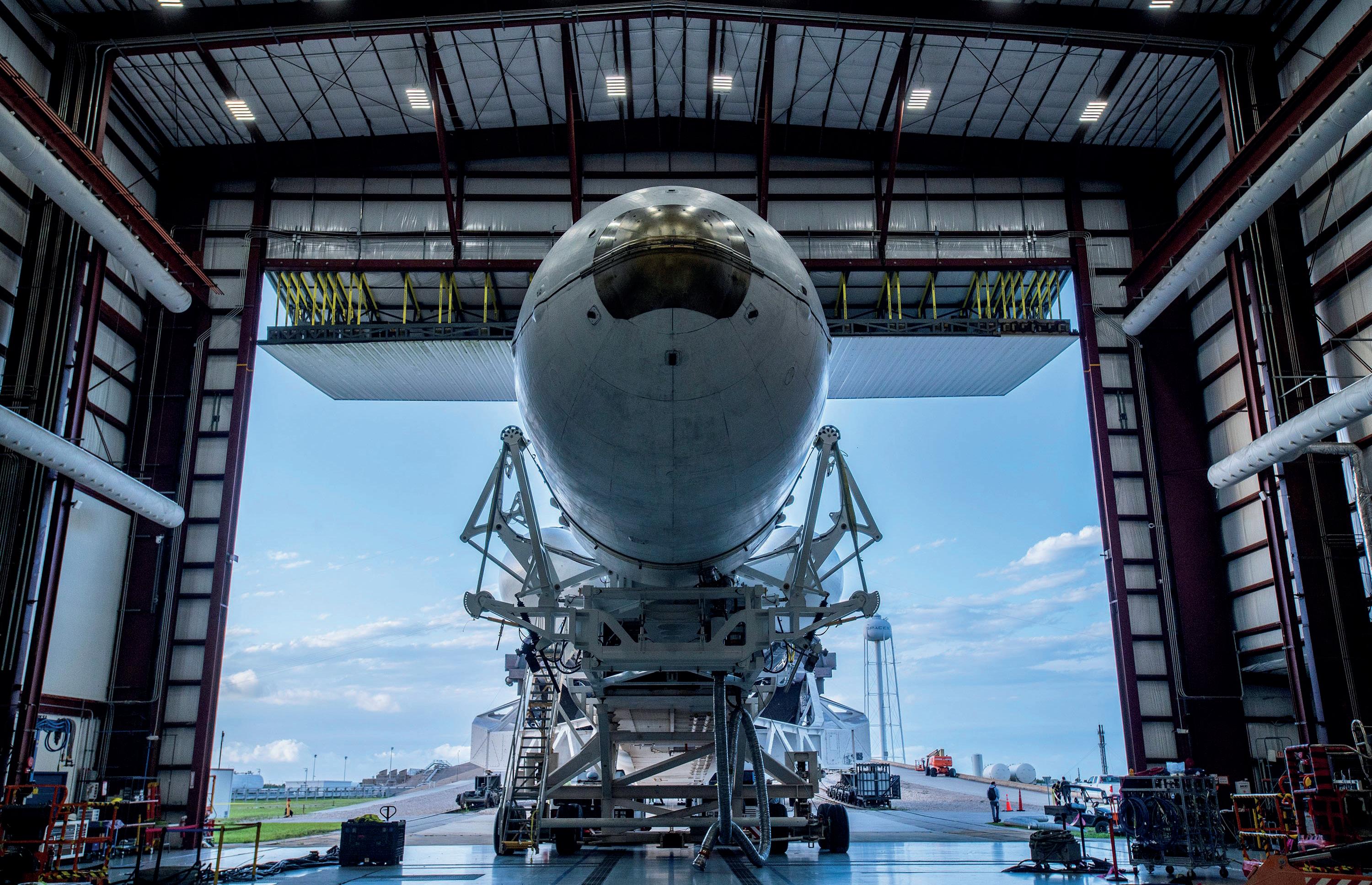
unpredictable
The global threat landscape is constantly evolving. It is di cult to predict the threats of tomorrow, let alone those of the next ve to 10 years, yet military SATCOM investments are still based on a snapshot of the known threat landscape at that time. Moreover, programmes can be in development for years.
The National Audit O ce’s Improving the performance of major equipment contracts report quotes a median running time for projects and programmes of 77 months. This results in projects that are well-intentioned, yet cannot deliver on
mission needs, increase costs and result in extended delivery times as teams react to new challenges.

The approach to delivering secure and resilient SATCOM needs to change to an agile, adaptable development process, prioritising exible capabilities that can be easily modi ed and scaled. Requirements for the mission are rapidly changing, so exibility needs to be built into how requirements are established and set.
As we look to the future, how can the Ministry of Defence (MOD) adapt to this dynamic environment and take the steps needed to enable resilient and secure SATCOM capabilities?
Embrace agile requirements In a traditional sense, going beyond initially stated requirements simply adds cost and delivery time to a project. Yet understanding the changing needs of modern missions, including an allowance for agile development from the outset, a ords the agility and exibility to adapt to dynamic mission capability requirements during development. The result will be a platform that is secure, resilient and meets the demands of its in-service date, rather than when it was commissioned.
This does not mean taking a blank-cheque approach, but instead modernising how we think about military procurement. Essentially, this is the same approach used in commercial agile software engineering – a more adaptable and resilient process creates a more adaptable and resilient nal product.
Traditionally, the military has preferred to use bespoke technologies developed by a sole supplier where there is an established relationship. However, this approach can see the UK cutting itself o from wider commercial technologies that either ful l speci c capabilities or provide fail-over alternatives to improve resilience and prevent a single point of failure in the system. Ignoring these alternatives is similar to trying to play an entire round of golf with a putter: possible, but with signi cantly limited options.
For example, the latest commercial SATCOM technology, such as the anticipated ViaSat-3 Constellation, could give governments and militaries innovative commercial capabilities for augmenting military SATCOM. ViaSat-3 is expected to deliver extremely high-capacity at 1 Tbps+ on each satellite and was designed with anti-jam/ anti-interference capability and military-grade security. The ViaSat-3 Constellation, which includes the recently launched ViaSat-3 Americas Satellite, is expected to leverage a ground network of proliferated gateways, increasing the resilience it can bring to governments as they seek to supplement bespoke capabilities and, ultimately, create a more resilient communications infrastructure.
Improve knowledge exchange and understanding with commercial Like any military operation, good procurement relies on communication, collaboration and processes. Better knowledge of commercial product roadmaps will help the MOD to identify opportunities to use technology in its projects, and an enhanced understanding of the MOD’s requirements will help commercial partners better align their technology development with capability needs.
Facilitating this exchange of knowledge, especially with new commercial partners, will not happen overnight. It will require a cultural shift within the MOD, and within commercial organisations. Yet it will help create a more resilient procurement network and, ultimately, faster development of the capabilities that the MOD truly needs.
Partnering for success Truly resilient and secure SATCOM capabilities are crucial to modern war ghting. Taking a more collaborative approach and harnessing commercial technologies will give the MOD an edge in developing these capabilities. Viasat’s SATCOM expertise can help the UK with its aims around its current concept of operations. By working closely to develop a joint roadmap that brings together the best of both worlds – military and commercial – the resilience and security of communications and procurement can be much improved.
Air Vice-Marshal Paul Godfrey has been Commander of UK Space Command since it was established in April 2021. In the brief period since then, he has overseen a signi cant expansion of the Command, as well as ensuring that it enjoys rm foundations as a vital part of the UK’s Space and, more broadly, Defence capability. Mike Bryant reports
“We have come so far since being established,” Air Vice-Marshal (AVM) Paul Godfrey a rms.
There is also a small training and research and testing unit housed at RAF Waddington.
The team at UK Space Command has made great strides in a short period due to its collaborative approach (PHOTO: MOD/CROWN COPYRIGHT)
Today, UK Space Command has a Whole Force complement of approximately 500, encompassing civilian sta and contractors, as well as defence personnel from all three armed services. That complement includes personnel based at RAF Fylingdales and the Command’s key monitoring and control facility at the Space Operations Centre (SpOC) at RAF High Wycombe.

The Command is now up to pretty much 100% of its planned military workforce, and perhaps 50% of its civilians, AVM Godfrey believes, adding that the expectation is to soon reach an enduring strength of approximately 550 military and civilian personnel.
Space is becoming ever more congested and contested, notes AVM Godfrey. It is a rapidly evolving domain, compounding the complexity of the role that the Command plays. Yet this only adds to the
fascination of its responsibilities and, perhaps as a result, “People de nitely want to come here,” AVM Godfrey says. These individuals are not only adding to the Command’s Whole Force strength, yet also replacing forces personnel now beginning to be rotated out of the Command to move on to pastures new within the Royal Navy, British Army and Royal Air Force.
All these personnel are helping to build on the rm footings that UK Space Command has already put down. It has been built up as a genuinely collaborative force: internally, between the UK’s three armed forces, as well as between military and civilian personnel; and externally, with other key players within the UK Space e ort, including, but certainly not limited to, the Space Policy Unit within the Ministry of Defence and the UK Space Agency, along with NATO nations and other allies.
With regard to allies, AVM Godfrey has had discussions with many, including Australia (which stood up a Defence Space Command at the end of March 2022 as part of a journey which he describes as having been “virtually identical to ours”); Canada (which stood up a Space Division last year within the Royal Canadian Air Force); France (which, in some respects, is ahead of the UK in this domain, and “from which much can be learnt”); Germany (which formed a Space Command in summer last year); Japan (which has emerging Space capabilities); and,
of course, the US – with particularly close working relationships having been formed with the US Space Force and its war ghting peer, US Space Command.
Meanwhile, UK Space Command continues to play an important role within multinational Spacebased alliances, such as Olympic Defender and the Combined Space Operations initiative (CSpO). As AVM Godfrey observes, “We are all neighbours in Space.”

Back in the UK, links with industry have been further strengthened, with AVM Godfrey talking with, for example, venture capitalists interested in Space, from where they envisage future technological leaps might spring.
Internally and externally, nationally and internationally, then, says AVM Godfrey, “We are really proud of the collaborative structure that we have put in place.” In this regard, as in so many others, “With such a good team now in place, it has allowed us to achieve so much in such a short amount of time.”
Since the Command was formed, publication of the UK National Space Strategy in September 2021 and the Defence Space Strategy in February last year has clari ed its role in the UK Space and wider Defence e ort. Another recent highlight has been
Responsibility for protecting and defending the Skynet SATCOM Constellation has been transferred to UK Space Command
(IMAGE: MOD/ CROWN COPYRIGHT)
UK Space Command personnel are spread across a number of RAF establishments, including RAF Fylingdales
(PHOTO: MOD/ CROWN COPYRIGHT)
the transfer of the protect and defend responsibility for the Skynet Constellation of satellites to UK Space Command – although Airbus continues to hands-on ‘ y’ them, while Strategic Command has retained responsibility for satellite communications (SATCOM) users and the future-looking Skynet Enduring Capability (SKEC) programme.
This has added to the Command’s Space Domain Awareness (SDA), a key aspect of its mission and capability. AVM Godfrey and his team have also been part of the e ort to look into developing ‘reactive’ capability – the ability to launch satellites at short notice as a geopolitical situation might require – while also rming up lines of communication, such that the dual-use value of any launched satellites will be optimised across Defence and Civil Space applications. For example, a satellite that o ers Space domain awareness for UK Defence might also serve other functions relating to meteorology or climate monitoring.
The SpOC at RAF High Wycombe is currently being rebuilt and reworked, while preparation is now well under way for the establishment of a Space Academy. The search for a home has started with the possibility that it could be
based at the Defence Academy at Shrivenham or another suitable educational establishment.
The commercial process will soon begin for acquiring an academic partner. The academy will be open to both military and civilian personnel; foundation courses are likely to be unclassi ed, while more advanced courses will have security classi cations.
AVM Godfrey is hopeful that the rst course of the new Academy will be delivered to students from across the UK Space enterprise before the end of 2023.
Among all of this progress, all the supporting functions of management, risk management, human resources and so on, that are key to a successful operational Command, have been put in place and are continuing to be re ned. It has been a very busy couple of years, and the pace at UK Space Command is by no means slackening.

“We are really proud of the collaborative structure that we have put in place”
Air Vice-Marshal Tim Neal-Hopes, Director of Cyber Intelligence and Information Integration (DCI3), highlights how Russia’s cyber onslaught on Ukraine and its allies prior to and during the current con ict emphasises the need for a partnership and Whole Force approach to cyber operations
The US National Cybersecurity Strategy notes that the most capable and best-positioned actors in cyberspace need to accept responsibility for stewardship of the digital ecosystem. The same must be true in the UK and for Defence. As a case in point, Ukraine’s cyber resilience has been built upon this philosophy of partnership and the Whole Force. A plethora of capable and well-placed cyber stewards stepped up to assist Ukraine from across the globe as it was bombarded by Russian cyber attacks.
Partnerships with NATO and EU allies, and the forward-leaning support of private companies such as Amazon, Microsoft and SpaceX, have been at the core of Ukraine’s successful defence and resilience. For example, in the days and weeks immediately
prior to Russia’s invasion, cyber experts from US Cyber Command could be found operating side-by-side with their Ukrainian Cyber Command colleagues, proactively hunting cyberspace for adversary activity, as well as mitigating vulnerabilities to increase cyber resilience across their critical networks.
A further example of the importance of successful partnering was industry’s support to maintain Ukrainian operations. When attacks against space systems denuded military satellite communications capabilities upon which Ukraine was dependent, the situation was rapidly remedied by SpaceX and its o ering of free access to Starlink satellite internet services.
Specialist-to-specialist engagement, including the widespread sharing of open-source threat and vulnerability intelligence and bespoke support
Russia’s cyber attack on Ukraine with the NotPetya wiperware caused massive operational and economic disruption in Ukraine and other countries (PHOTO: SHUTTERSTOCK)

packages, has been witnessed across every Ukrainian sector: nance, energy, telecoms, business et al. This collective international e ort is mirrored at a national level by institutions such as Ukraine’s Computer Emergency Response Team (CERT-UA), which continues to advise and work with an array of Ukrainian and international organisations to minimise the e ects of Russia’s cyber o ensive, blocking literally thousands of attacks on a daily basis to keep critical systems up and running with minimal interruption.
At the outset of combat operations by Russia, when Ukraine was hit by massive simultaneous distributed denial-of-service (DDoS) attacks on 23 February 2022, it was because of partnerships like this that Ukrainian government web services were recovered within just 40 minutes. Today, between ve and 40 similarly powerful DDoS attacks are being repelled by CERT-UA, with Ukraine feeling little or no interruption. This is partnered resilience in action, powering arguably the most e ective collective cyber defence in history. There is a lesson for us all in this approach.
However, it is not only about the proactive building of partnerships. Ukraine should be held up as an example that it is learning from lessons of the past that is important, not just identifying lessons and leaving them to digitally stagnate in a spreadsheet. Ukraine’s cyber community, armed with hard-earned experience dating back to 2014, widely employed its lessons to build resilience as the Russian threat grew. This ability to learn and adapt has been at the heart of Ukraine successfully muzzling Russia’s cyber bite. For example, in 2014, 2015 and 2017, the cyber assaults that Russia unleashed upon Ukraine bit and bit hard. Power grids were taken o -line and the NotPetya wiperware ‘bricked’ countless systems with signi cant operational and nancial rami cations. In 2022, a di erent cyber story unfolded.
Over the preceding years, Ukraine, aided by its partners, had initiated widespread and rapid change and innovation across all facets of its
cyber capabilities. This spanned: reviewing and mitigating its cyber vulnerabilities; putting in place monitoring across its key cyber terrain; training and investment in a new generation of cyber practitioners; reforming its laws and regulations; building innovative partnerships; and enabling access to commercial, as well as government, services.
Ukrainian leaders also continued to learn and adapt right up to the nal moments before and during the con ict. No better example is Ukraine’s decision to o shore its data. If one were to go back to just two weeks prior to Russia’s invasion, Ukrainian law demanded government and private data to be physically stored on potentially vulnerable ‘on-prem’ servers in country. A week before the invasion, Ukraine’s parliament passed legislation allowing this data to be moved to the cloud.
On the day of the invasion itself, Amazon’s technical architects were working with Kyiv to provide ruggedised hardware to help secure, store and transfer data to the cloud. Less than three days later, a digital ‘NEO’ (non-combatant evacuation operation) had begun. To give an idea of the scale of this exodus and the agility demonstrated, in excess of 10 million gigabytes of essential data, from 61 government organisations, 18 universities and dozens of privatesector companies, was safely o shored to the cloud, all in less than four months. Most importantly, this agility and adaptability ensured that the operations that this data served to support were protected.
This all demonstrates that emerging cyber strategy, if coupled with operational learning drawn from the growing compendium of practical cyber power experience (now including many pertinent lessons from Ukraine) can identify e ective ways for adversaries’ intended cyber e ects to be muzzled. While cyber strategy can help show the path, it is also important to reiterate that cybersecurity and resilience is for everyone, not just our cyberspace and digital experts. It is every platform and capability’s responsibility to ensure that cyber resilience is invested in from the outset and maintained in a through-life capability development manner. It is also our collective responsibility to remind others that the threats faced are both real and growing.
While we all have a collective role to play in securing our cyber anks, the e ective delivery of air and space power will continue to be dependent upon innovative and agile cyber professionals, drawn from across the Whole Force, who need to serve both as trusted advisors to military commanders and as the specialist force elements that we require to secure and protect our freedom of manoeuvre in and through cyberspace.
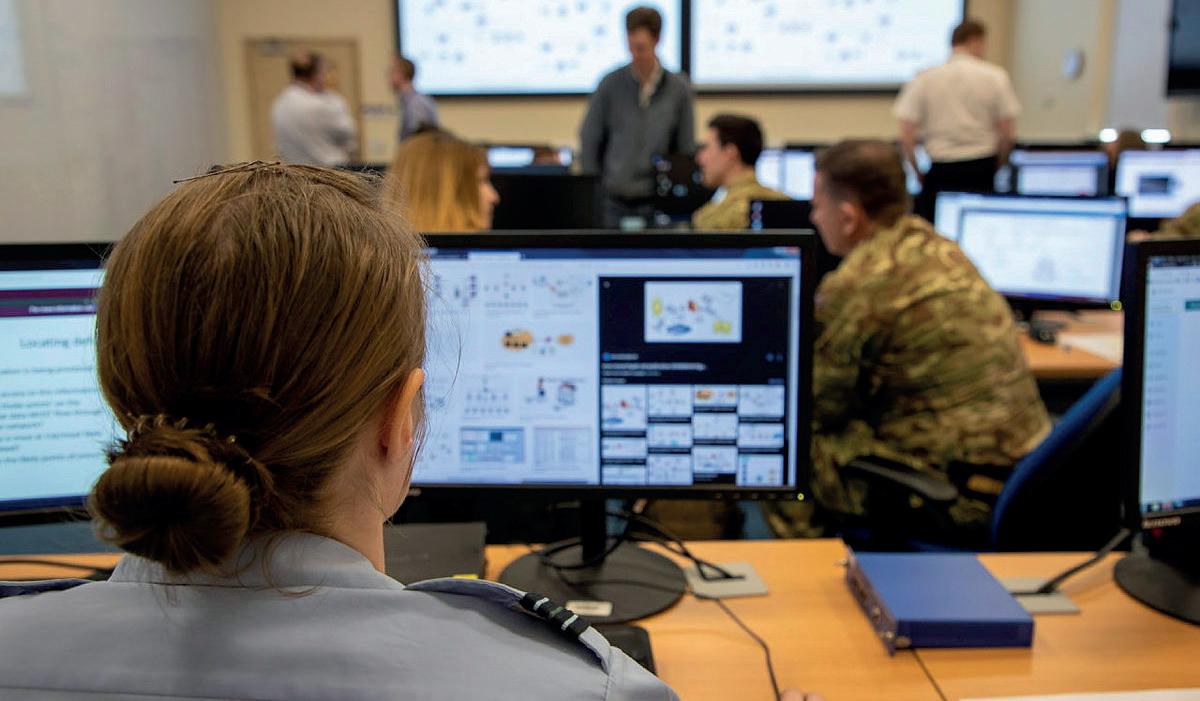
Delivery of air and space power is dependent on agile cyber professionals, drawn from across the Whole Force (PHOTO: MOD/ CROWN COPYRIGHT)
Cecil Buchanan, the RAF’s Chief Technology O cer and Head of Science at the Rapid Capabilities O ce, explains his technological vision and highlights the di erence between technology and innovation
Technology and our innovative use of capabilities have been key to RAF successes throughout our rst century. As battlespace geometry, the environment and our adversaries change and the demands upon us grow, we must continue to harness technologies at pace, absorb them into our capabilities and exploit them to our advantage. Over the coming decade, many ubiquitous technologies are projected to improve 50 to 100 times, rendering today’s state-of-theart obsolete. Whatever is possible now represents 1%-2% of what might be possible in the next decade. Simply put, if we fail to innovate rapidly and exploit battle-winning technology we will lose.
“The scienti c knowledge and the physical manifestation of objects and associated processes embedded in systems deliberately created to help solve speci c problems” –Professor Olivier De Weck, MIT
Motivations for scienti c and technological endeavour vary. The RAF’s motivation for science and technological research stems from its immediate application to address RAF capability challenges. Within the Pasteur’s Quadrant model of scienti c motivation, popularised by Stokes (see graphic, next page) all of
The RAF’s RCO recently sponsored a trial ring of Thales LMM missiles from a Fly BVLOS Jackal drone (pictured). The successful trials were completed in six weeks, exemplifying the RAF’s spirit of innovation (PHOTO: THALES)
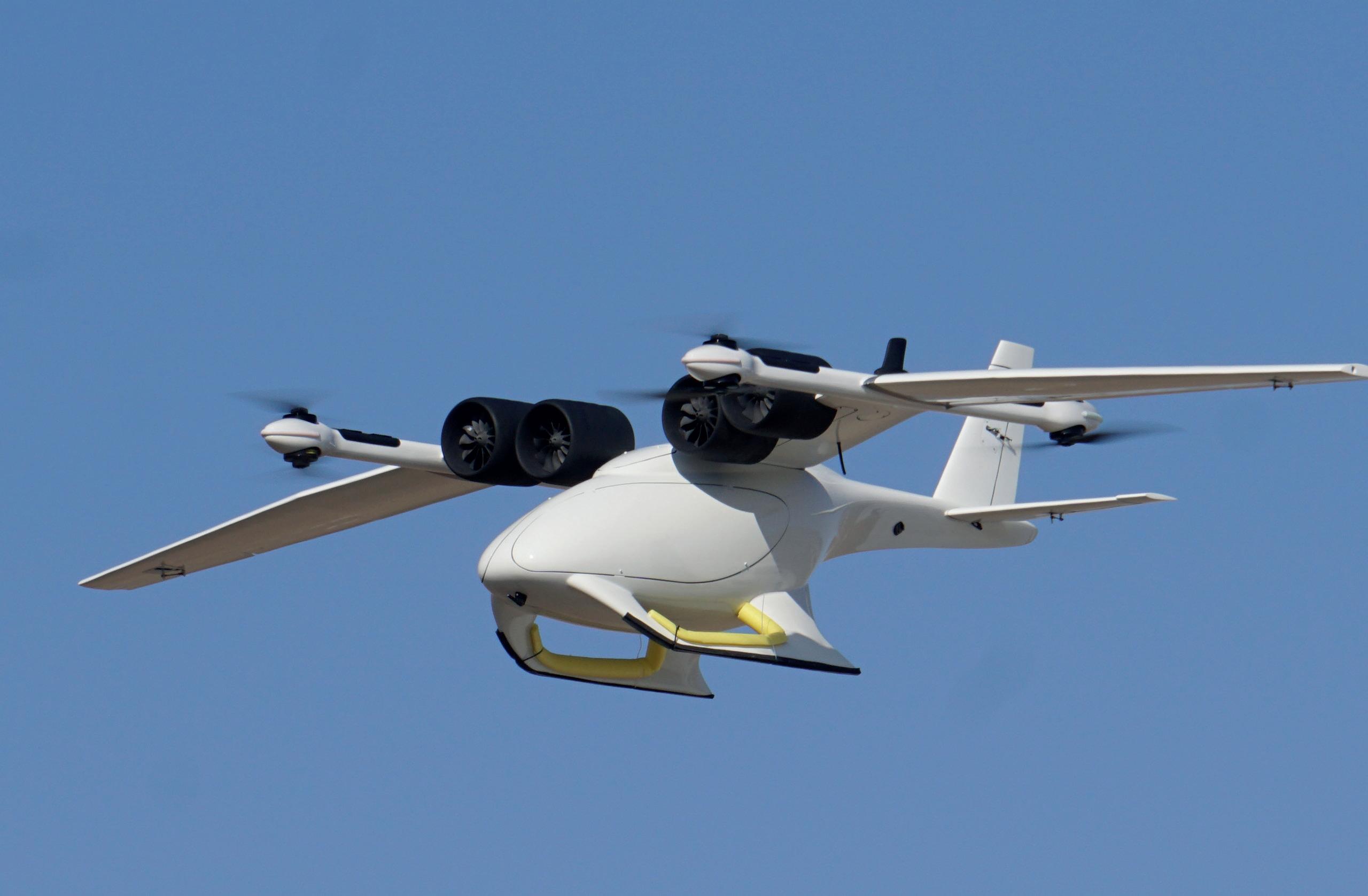
our work sits in either applied research (the bottom right quadrant – the majority), where we are exploiting scienti c knowledge, or use-inspired basic research (the top right quadrant), where we are creating fundamental scienti c knowledge to address speci c use-inspired challenges.
Where we enjoy instances of rapid technology exploitation, it is typically built on basic and applied research spanning many years. We recognise this dependence on longer-term investments in scienti c endeavour and have been working, as per the recent Ministry of Defence Science and Technology Collaboration and Engagement Strategy, with colleagues in Defence, across government, and with industrial partners and allies to ensure that we play our part in supporting the foundations for fundamental research, while accelerating development and adoption into service to maintain our war ghting edge.
Advanced technologies and their integration, once the preserve of national governments or large industrial entities, have been increasingly democratised and demonetised as a result of digitalisation and subsequent acceleration via Moore’s Law. Driven by commercial markets, the rate of technological change in many technologies is exponential. At this rate, with technologies doubling in capability (or halving in cost) every two years or fewer, within a decade we are likely to see
improvements in technology rapidly manifesting themselves 50 to 100 times faster than today.
While these technologies are accelerating, it is their convergence that creates disruptive e ect. It is worth reading The Future Is Faster Than You Think by Peter
Diamandisand Steven Kotler to get a better grasp on these technological convergence trends. The convergence of low-cost data collect (from a battlespace internet of things), high bandwidth connectivity, high-power compute, autonomous cyber-physical entities and arti cial intelligence (AI) creating hitherto unavailable situational understanding and decision advantage is one such area where we are active in applied research. For more on this see the article by Air Vice-Marshal Linc Taylor and Chris Platt, AI in Command and Control and Air Information Management in this publication.
While our work at the intersection of exponential technologies and their integration into capability will focus on RAF use-inspired challenges, we will work with colleagues within Defence and across government to provide stimulus into research that will pay dividends to our technology advantage and our national prosperity in the immediate and longer terms.
“Generating ideas and putting them into practice to give us an edge over our adversaries” – UK Defence Innovation Unit
Whereas science and technology e orts are typically associated with invention, innovation is about bringing those inventions to bear, addressing a speci c problem or harnessing a speci c opportunity. Innovation fundamentally e ects new/improved products, processes or organisational structure. But, make no mistake, innovation is di cult. Summing up analysis on innovation initiatives over several decades, Professor, Rosabeth Moss Kanter of Harvard Business School notes that: “innovation gets rediscovered as a growth enabler every half dozen years... however... grand declarations about innovation are followed by mediocre execution that produces anaemic results, and innovation groups are quietly disbanded in cost-cutting drives.”
Our experience is that it is often not technology or its maturity that is the Achilles heel to rapid absorption of technology into service. In reality, the obstacles are typically structural, associated with such things as procurement processes, regulation frameworks and risk aversion. Moreover, intermittent near-term funding without long-range demand signals can lead to a loss of con dence, skilled workforces and facilities. In addition, limited whole-of-system competitive enterprise understanding can prevent pullthrough due to, among other issues, intellectual property rights – a factor that has been noted by the Council for Science and Technology in their assessment of obstacles to innovation, Delivering national priorities through public procurement
Where e ort has been focused to understand and overcome these structural barriers, especially the Nexus data fabric and associated DevSecOps
architecture, which is already delivering information advantage for the RAF, we are nding signi cant breakthroughs to innovation delivery across diverse government and industry partner collaborations. This ‘thinking to the end’ is an essential component of our engagement across the technology and innovation landscape, from invention to in-service, and a key element of our revised technology management approach.
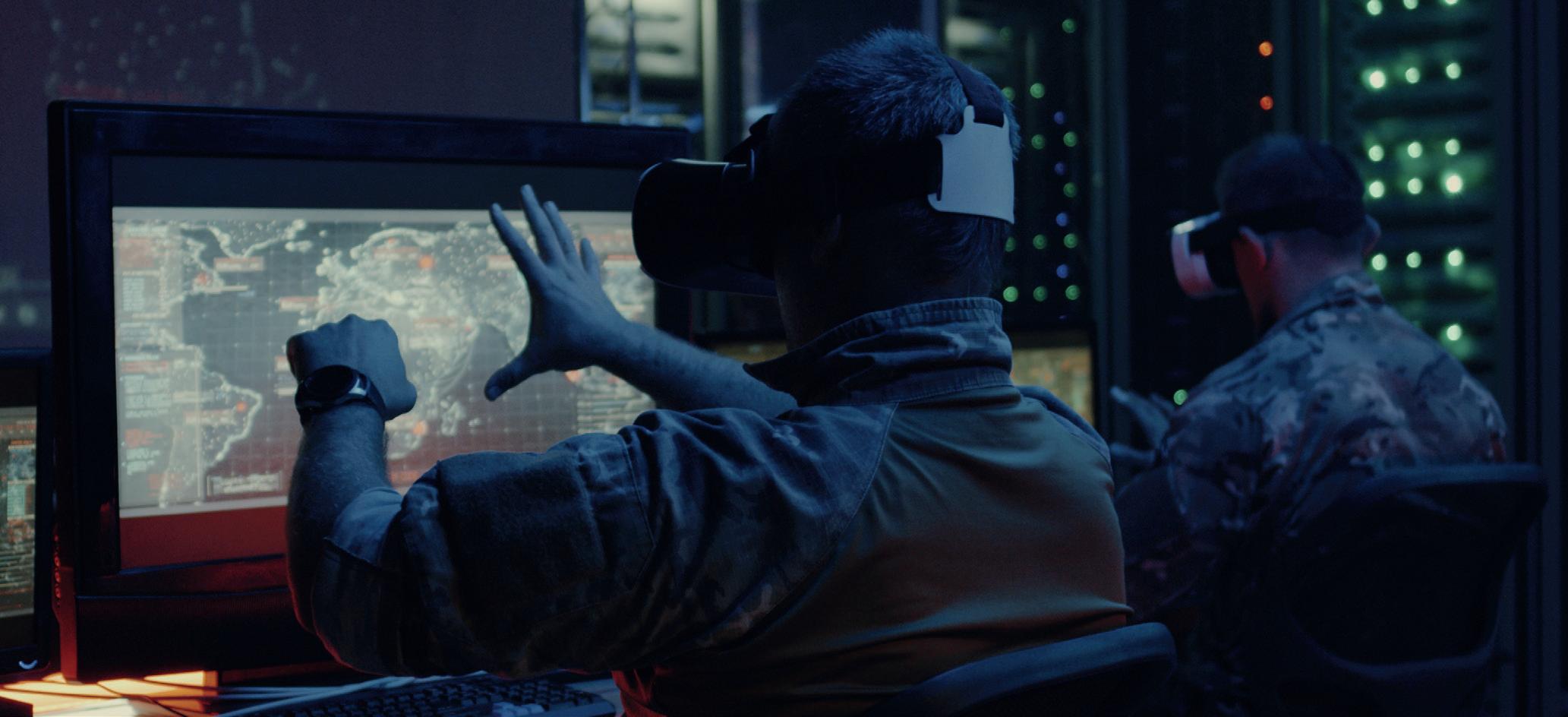
Given the rates of change across many enabling technologies, we must innovate these into our front-line capabilities or face becoming obsolete. We cannot a ord the time or money to duplicate technology development; rather, we must harness the best-of-breed technology from onshore or with allies from whatever industry/sector it was created, and fundamentally reshape how we share that know-what and know-how to co-create the capabilities we need at the point they are needed.
If we are to see the equivalent of 100 years of technology development within the next decade, what might the RAF of 2030 look like –no annual medicals (embedded biotech will see to that); no scheduled maintenance (ubiquitous sensing will see to that); experience and seniority rede ned (generative AI and augmented reality will see to that); robotic and autonomous systems everywhere to deliver the routine/repetitive?
To quote US business guru Peter Drucker from his Discipline of Innovation masterpiece, “In innovation there is talent, ingenuity and knowledge. But, when all is said and done, what innovation requires is hard, focused, purposeful work.” Let’s not be limited by lack of ambition and rise to the challenge collectively.
Fast-developing technologies must be added to frontline capabilities in order to avoid obsolescence
(PHOTO: SHUTTERSTOCK)Wing Commander Matt Morris reveals how the RAF is embedding its innovation mindset to maintain its operational edge
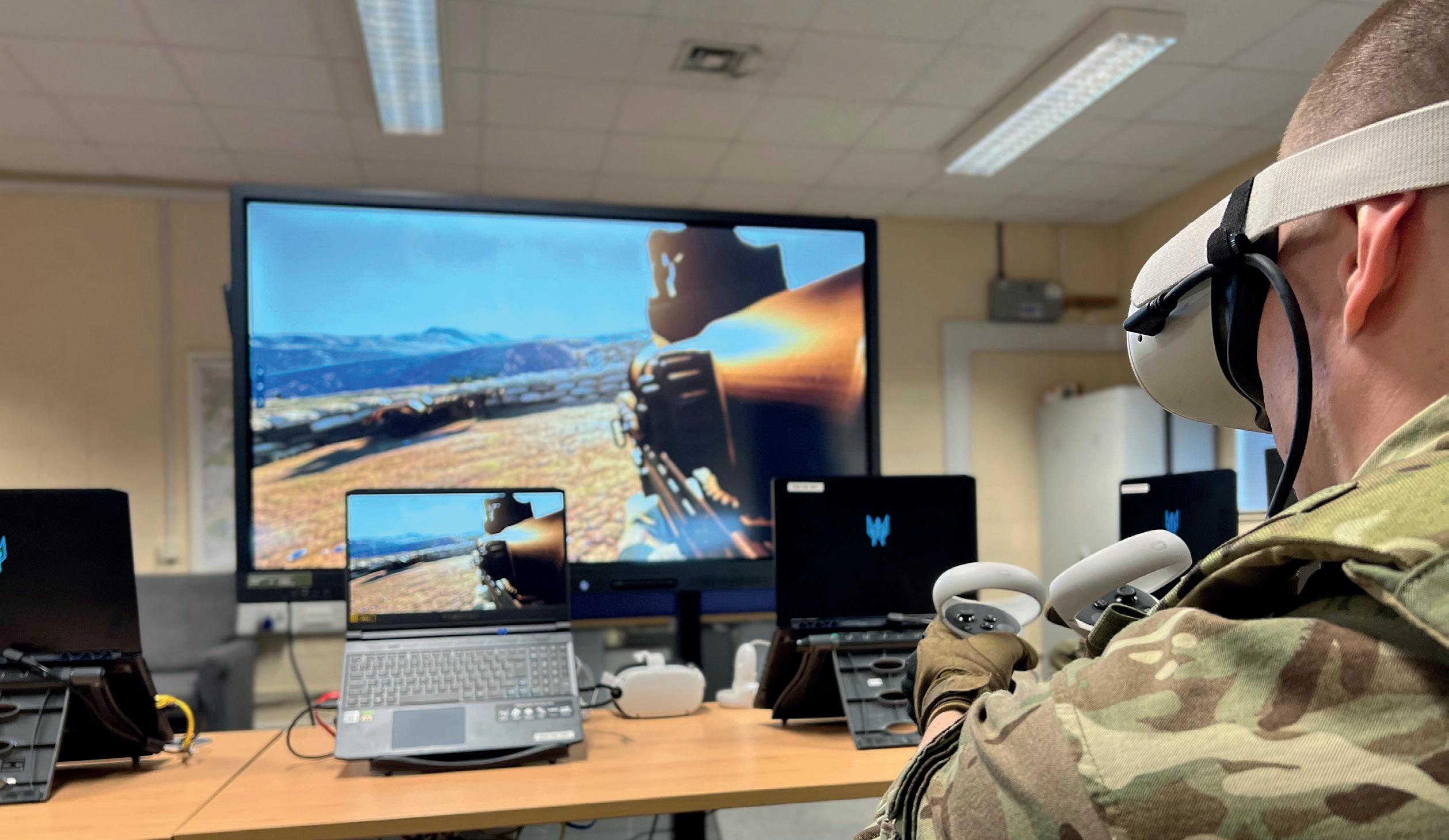
If Defence is to win in the 21st century, it must develop a broad and dynamic approach to innovation and culture that is ‘innovative by instinct’.
This has been a consistent message since the 2015 National Security Strategy highlighted innovation as the key to success in an increasingly complex world.
This ‘call to arms’ prompted an explosion of innovation activity and rhetoric. Today, innovation hubs are embedded across the organisational landscape, and approximately £100m is dedicated to the pursuit of new ideas every year. Yet despite this intense focus, it is di cult to claim that innovation is instinctive. So, what’s missing?
The task implies an ability to consistently implement the broad range of ideas required to guarantee competitive advantage. With this goal identi ed, a study of history is often used to point to sustained technological dominance, and to assert that, generally, ‘we’ve got this’. However,
this notion fails to recognise that innovation as an organisational endeavour is an intensely complex subject. While the imperative for innovation may be clear, the path to achieving it is not.
This problem is not limited to Defence. For example, a highly in uential study by McKinsey noted that, while companies founded in 1935 could expect to survive for 90 years, those founded in 2005 could only expect to survive for 15 years. The study concluded that even the most accomplished rms were incapable of the sustained innovation required to thrive in today’s complex environment.
Noting that innovation is vital to success, yet incredibly di cult to achieve, it makes sense that we give the subject serious thought and, thankfully, there is a wealth of research in the elds of ‘innovation, organisation and strategy’ to guide us. When studying this research, it becomes clear that organisations, especially mature
organisations like ours, are simply not designed for innovation – instead, they are optimised for the e cient pursuit of a core business model. No organisation starts out this way. In the beginning there is no ‘core business’, and so everything is innovation. Yet as soon as an innovation demonstrates success, a new challenge emerges – a relentless quest to repeat that success as e ciently as possible. This slowly, but surely, erodes the organisation’s founding innovative instincts. This is even true for organisations convinced that innovation is a part of their DNA. Take, for example, the telecommunications giant Nokia. Once lauded as masters of innovation, Nokia led the global mobile handset market for over a decade, yet completely failed to keep pace with the rise of the smartphone, despite being one of the rst companies to explore the concept.
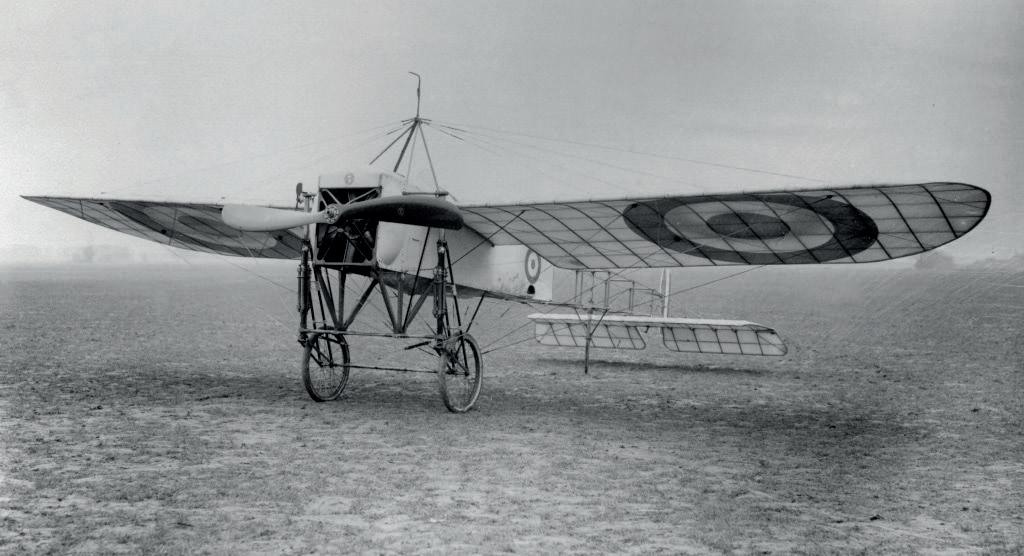
With this lesson ringing in their ears, Nokia, like many other organisations, are fully invested in reigniting their innovative spark. Here the problem seems simple: innovation is a process of generating ideas and implementing them. It follows that without ideas there can be no innovation. Any organisation wishing to be innovative merely needs to concentrate on generating ideas. Cue conversations about energising the workforce, ideation and creativity. But while such conversations are undoubtedly important, ideas are useless if they cannot be implemented. Indeed, it is widely acknowledged that most companies have plenty of creativity; what they lack is the ability to convert that creativity into impact.
This conundrum arises because, above all else, ideas cause friction. Ideas lead to change, and change causes friction. Ideas compete for resources, and competition leads to friction. Friction occurs between senior leaders, between organisational units and among the workforce. As a consequence, even the best ideas can fail to progress beyond proof of concept.
Success then, relies on removing friction. Unfortunately, there is no clear answer as to how this should be done. That said, one proposition consistent throughout the research is the importance of designing a bespoke organisational architecture (comprising processes, structures, and skills) to facilitate the simultaneous pursuit of ‘explore’ (required to ‘innovate for tomorrow’) and ‘exploit’ (required to ‘succeed today’) activity.
The aim is to build safe spaces for ideas to ourish, while establishing clear pathways for those ideas to be adopted. A successful design must consider the full spectrum of innovation –supercharging the incremental innovations associated with short-term success, and using the
experience associated with these incremental gains as a learning mechanism to promote adoption of the radical innovations required of long-term, exponential success. While the goal is clearly the reduction of friction, it can never be eradicated. Consequently, the design must build a workforce tolerant of any residual tensions, and senior leaders ready, willing and able to resolve these tensions when they arise.
Therefore, it appears that to become ‘innovative by instinct’ we must rst become ‘innovative by design’. The question is, ‘what design?’. There is no singular template. Every organisation is di erent, and it is up to each organisation to determine what design works best for them. This, in e ect, is the journey that the RAF has been on for the last four years.
In 2019, Astra set out to challenge the status quo, emphasising the need for wide-ranging change, and prompting a mass of innovation initiatives. Such an approach will have caused signi cant friction, yet, equally, it will have provided a valuable opportunity to nd, test and adjust the structures, processes and skills required of our unique innovation architecture. The challenge now is to ensure that we develop from the lessons we have learned.
Work is well under way. The Astra team are developing a bespoke innovation pathway to smooth the progress of grassroots innovation; the Rapid Capabilities O ce have become experts in integrating emerging technologies with our in-place systems; and we now have a clear strategy to track and invest in the most promising technological research.
Locking these elements, alongside lessons learned by the Air and Space Warfare Centre, RAF Digital and the Strategic Support Programme, among others, will provide the foundation of an organisation that is innovative by design. Normalising the processes that accompany this design will ensure our pathway to being a Service that is ‘innovative by instinct’.
How will Japan’s inclusion in GCAP impact on MBDA’s role in Team Tempest?
Chris Allam Managing Director, MBDA UK
What is MBDA’s role within Team Tempest (GCAP)?
MBDA’s role is the Weapons E ects Domain Lead Sub-System Integrator. Our mission is to transform the integration of weapons systems for a sixth-generation ghter jet, developing novel kinetic and non-kinetic weapons that deliver battle-winning e ects and operational advantage.
The transformational partnership launched by Team Tempest in 2018 means that, for the rst time in the development of a ghter jet, the skills and experience of a weapons systems integrator like MBDA UK have been involved from the outset. We are contributing to the core platform through the design of a weapons bay, and reducing cost, risk and time through digital integration, which will enable continuous performance optimisation and rapid and frequent upgrades.
MBDA was founded on the principle of nations working together. This leverages innovation and drives economic bene t. The trilateral agreement for the Global Combat Air Programme internationalises the development of a next-generation ghter aircraft for the UK, which was always the ambition. We are welcoming this opportunity and are strengthening our relationship with Japan, and we look forward to working with all the multinational industrial partners to ensure that this next-generation platform has the next-generation weapons that drive a step change in future capability.
Can you describe the scope and signi cance of MBDA’s digital vision and open architectures methodology for Team Tempest?
The scope of MBDA’s digital vision for Team Tempest, and beyond, is extensive and is being delivered in collaboration with our partners. We are maturing technology to increase the use of digital test and evaluation for weapons system integration. These digital/synthetic environments are critical to optimising our weapons concepts, and how they could be carried and launched from a platform not yet physically built.
We are also developing concepts for how arti cial intelligence (AI) and machine learning (ML) can manage the optimisation of weapons e ects, and how networked-enabled weapons can work together. In addition, the
importance of open architecture methodologies cannot be overestimated, as they underpin our drive to enable faster integration of weapons system and rapid and frequent upgrades. This will contribute signi cantly to our ultimate vision for integration – which is as close as possible to ‘plug-in and use’, similar to the personal device technologies we use every day.
How is MBDA evolving current technologies to support the RAF’s global operations?
First, we listen to our customers and end users to understand their needs. Next, we develop ‘threat-driven’ solutions. Identifying what an adversary is, or could be, capable of deploying and providing a counter that gives operational advantage. These two things are embedded in our future portfolio work with the UK Ministry of Defence. This includes the spiral upgrade to both hardware and, very importantly, software in existing capabilities, such as Storm Shadow, Brimstone, ASRAAM and Meteor. It is also the development of brandnew capabilities such as SPEAR3, while also demonstrating how an electronic warfare version (SPEAR-EW) will complement this capability.
Looking to the future, we are working closely with Dstl on the Co-operative Strike Weapons Technology Demonstrator – a project that is investigating how communication between missiles can enable the weapons systems to work together and improve the performance of current systems.
The project to develop the UK’s next-generation Tempest ghter aircraft, as part of the Future Combat Air System (FCAS), took a dramatic turn in December 2022. A new trilateral partnership was announced between the UK, Japan and Italy. Simon Michell asked the previous Deputy Commander Capability, Air Marshal Sir Richard Knighton, prior to his promotion to Chief of the Air Sta , what this means to the UK Defence community
The launch of the new Global Combat Air Programme (GCAP) between the UK, Japan and Italy is enormously signi cant. For the UK and Japan, it signals the start of a relationship in military and aerospace capability that could last a century, in addition to our relationship with Italy through NATO,” explains the then Air Marshal (AM) Sir Richard Knighton, previous RAF Deputy Commander Capability. All three countries reaching an agreement to develop a sixth-generation multi-role ghter aircraft is a spectacular achievement and rates as every bit as signi cant as the recent AUKUS agreement between Australia, the UK and
the US to design and manufacture nuclear-powered submarines together for Australia, as well as exploring together the future utility of emerging technologies.
By merging Japan’s F-X ghter development programme with the UK’s Future Combat Air System (FCAS) programme and launching a new shared endeavour, all three member nations – Italy, Japan and the UK – stand to gain substantial bene ts across the board: commercial, industrial, military and political.
Exactly how the three nations will be able to develop an equitable and fair workshare remains to be seen, yet the challenge is certainly not insurmountable. Italy and the UK have worked
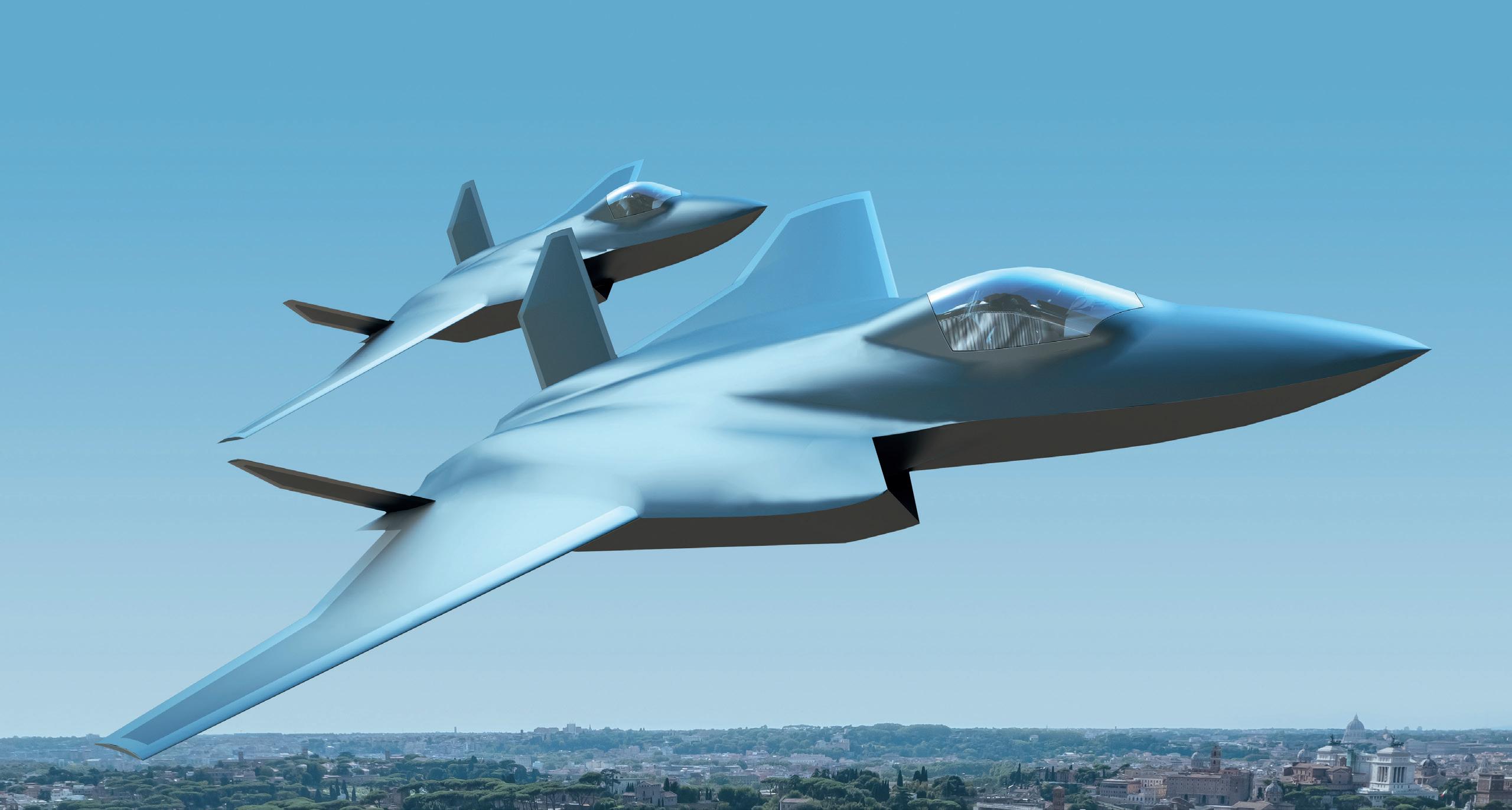
together on successful aircraft projects of this sort before. Both helped to frame the consortia that designed and built the Panavia Tornado and, in the case of Euro ghter, builds the Typhoon. Consequently, both nations have experience of, and understand, the mutually bene cial collaboration that is an inevitable part of the process. Furthermore, both have proven that they are able to reach practical and pragmatic compromises. However, although Japan partnered with the US to build its Mitsubishi F-2 ghter, it is relatively, if not totally, new to this type of broader multilateral defence partnership.
Although the announcement came as a surprise to many, including those close to the Defence community, the three nations are not approaching this from a standing start. Work has been ongoing behind the scenes to determine how to make any potential collaboration run smoothly, and the UK and Japan have already been undertaking bilateral collaborative defence projects for years.
Most prominent among these are bilateral studies into Japan’s Joint New Air-to-Air Missile (JNAAM) – which commenced in 2014, incorporating elements of MBDA’s Meteor technology – and the agreement, signed in December 2021, between Rolls-Royce and Japan’s IHI to co-develop a future ghter engine demonstrator. “What we know from
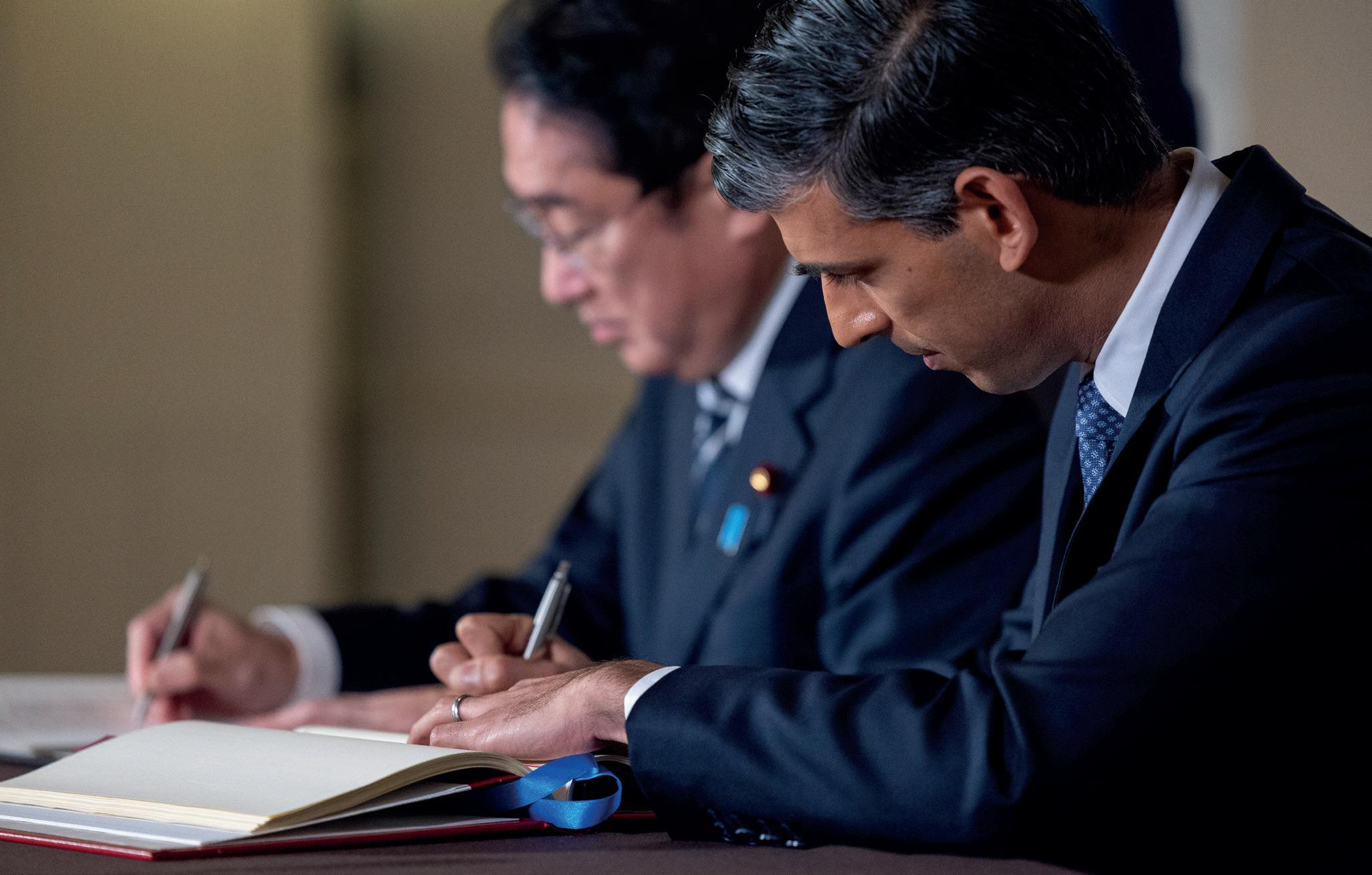
the work that we have done already with Japan –government to government, air force to air force and industry to industry – is that we can, in fact, work together. I can absolutely see a way through this that will result in a synergistic relationship between our industries,” insists AM Knighton.
Not only that, according to AM Knighton, this is, without doubt, an extremely mutually bene cial endeavour: “We will learn from each other. Ultimately, we will all be better together. We will become far more than just the sum of our respective parts.” That said, there is still a lot of negotiating left to do and there is a lot that is still unknown. “The precise details will depend on the development of the design and the demonstration of capacity and capability in each of the three nations,” he adds.
Moreover, time is of the essence. All three nations want to resolve the issues as fast as possible, as AM Knighton points out: “One of the really important points to remember with Tempest is the absolute imperative around time, and the need to move quickly. The protracted debates that we have had in the past about workshare and ‘just retour’ with Tornado and Typhoon de nitely slowed things down, so we have to adopt a di erent model with Tempest.”
What has to be considered in any negotiation is that, like Italy and the UK, Japan has a highly regarded and hugely capable aerospace industrial capability and domestic defence industrial footprint. In AM Knighton’s
words, “Japan has strong capabilities in aero engines, as well as mission and avionics systems. In fact, they have the full panoply of combat air capability.”
GCAP operates on an open-door basis in terms of additional partners. One of the original FCAS members, Sweden, has not joined GCAP, but discussions with the UK continue on future collaborative opportunities suited to their budgeting cycles and planning requirements. “We have been very clear that we want to continue working closely with Sweden. I can de nitely see the potential for them being involved in GCAP as we go forward,” says AM Knighton.
Another obvious candidate, however, is Saudi Arabia. The Royal Saudi Air Force operates both Tornado and Typhoon ghters and has an impending requirement for a replacement for the Tornado. “We have this very fruitful and long relationship with Saudi Arabia through Tornado and Typhoon. It would feel like a natural progression to extend that out to Tempest. Furthermore, we know that Saudi Arabia is thinking about its combat air eet and the changes it has to make as Tornado starts to go out of service,” Knighton points out. Saudi Arabia took a step closer on 1 March 2023, when it signed a statement of intent to work together with the UK on a joint vision for future air combat.
Essentially, Tempest will be an air-superiority ghter deployed to gain control of the air; in other words, an aircraft that can seek out adversary aircraft and shoot them down, so that forces on the ground can operate, free from airborne interference. As such, it will be equipped with state-of-the-art sensors – radars, electro-optic systems, electronic warfare suites and air-to-air missiles. However, as AM Knighton explains, “In order to gain control of the air, you also need to have an air-to-ground capability so that you can eliminate ground-based air defence systems.” Hence, the need for air-to-surface weapon systems and ground targeting sensors as well.
Despite the rapid progress being made on the levels of arti cial intelligence and autonomy that are making uncrewed air vehicles ever more sophisticated and capable, the current understanding is that the Tempest aircraft and its onboard systems will be operated by a pilot in the cockpit, not on the ground. “The planning assumption, for now, is that the core platform will have a person in it. That is because of the complexity of the air control task and the inability to assure ourselves of the required continuous connectivity with the platform,” AM Knighton explains.
As for its in-service life cycle, current expectations are that, once the Tempest enters service in the
mid-2030s, the aircraft, or its iterations, will still be in service at the end of the century and into the next. This is by no means fanciful. After all, the USAF’s venerable B-52 long-range bomber entered service in 1955 and there are still over 60 of them in active service now, albeit none of the originals.
This longevity is key to the design philosophy, as the aircraft will de nitely need to undergo extensive upgrading to keep it operationally relevant and airworthy. Some of this updating will naturally be to the airframe and engines. However, its longevity will also mean that it will, inevitably, require a new suite of both radar-guided and heat-seeking missile systems at some stage.
Therefore, the key to Tempest’s modernisation is in its mission and avionics systems, so that new systems can be installed on a plug-and-play basis. These will be designed with open architectures, so that it will be possible to update the software and install new systems on a frequent and regular basis. At some stages within its life cycle, the aircraft may undergo daily upgrades to its systems. Some of these updates may even be applied while it is airborne and involved in operations.
Having got o to such an impressive start, this momentum must be maintained. “We expect the next big investment decision to be made by the UK Government in 2024 and, by then, we will need to have formalised the relationship through a treaty. We will also need to have joint-venture agreements from an industrial perspective. So, there is a lot of work for the Tempest GCAP Team to do in all three nations over the next two years,” concludes AM Knighton.
The GCAP merges the existing programmes for Tempest (pictured) and Japan’s F-X to design and build a next-generation ghter aircraft (IMAGE: BAE SYSTEMS)

MBDA’s software-based Weapons E ects Management System will take the strain o Tempest pilots by recommending the best threat response e ect and the optimum moment of release.
Chris Allard, Senior Responsible Owner for FCAS at MBDA UK, reveals how arti cial intelligence and machine learning are being used to reduce the cognitive burden of future pilots
Pilots of sixth-generation ghter jets in the future battlespace are likely to be in a situation never before experienced in the history of air combat. Firstly, they are highly likely to be ying as part of a ‘system of systems’ – the Future Combat Air System (FCAS). This means they will be ying alongside interoperable fourth- and fth-generation ghter jets, uncrewed aerial combat vehicles and attritable adjuncts.
of weapons systems that meet the needs of armed forces in the air, as well as on land and at sea.
Future Tempest pilots will be ying in a networked system-of-systems
cooperative pack (IMAGE: MBDA)
Furthermore, a combat cloud is likely to connect them to intelligence, surveillance and reconnaissance (ISR) resources in the sky, as well as battle command systems on the ground and at sea. This Multi-Domain Integration will ensure that all are working seamlessly together, and this is something integral to MBDA as a designer and manufacturer

Thus, there is a congested battlespace even before the pilots face the contesting threats of hostile fourth-, fth- and maybe sixth-generation ghter jets, multi-layered ground-based air defence (GBAD) systems that are protected both physically and by other sophisticated anti-access/area denial (A2/AD) capabilities; there could also be longrange maritime-based air defences in play.
Thankfully, the sixth-generation ghter being produced for the UK by the Global Combat Air Programme (GCAP), will be an innovative combat aircraft with stealthy, supersonic capabilities and equipped with cutting-edge technologies, including state-of-the-art sensing systems that will
provide the pilot with an information advantage that collects a ‘city’s worth of data per second’.
The ghter’s future weapons to respond to these future threats will also be networked, able to cooperate in packs, or even swarms, altogether providing an operational advantage in that highly congested and contested future battlespace.
In summary, the pilot of the future will have more to deal with than they ever have, historically. That is why, as part of our activity at MBDA, we are working towards reducing the pilot’s cognitive burden and making the coordination of all available complex weapons in the battlespace as simple as possible.
At the Farnborough International Air Show in 2022, we began showcasing this concept, which we refer to as a Weapon E ects Management System. It uses arti cial intelligence and machine learning to exploit and take maximum advantage of the information that Tempest, at the heart of a future combat air system, will have, and then use that to maximise the e ect our integrated weapons can deliver.
Therefore, some of the technology we are assessing in our concept phase work includes better decision aids for pilots. These will help pilots balance managing the platform alongside selecting which weapons to use and when to use them. They will work across the system of systems and provide pilots with solutions at the optimum time and space, adapting to events in the battlespace as assets are used or as reinforcements arrive.
A simpli ed description of the vision we have used for weapon e ects management, for what an operator could experience from the system in
future, is akin to seeing computer-generated options overlaid on the tactical picture of the battlespace. The pilot then uses their training and experience to select the best one, with options recon guring as time passes and/ or there are changes by opposing forces.
It may also be that the best e ect does not come from the sixth-generation ghter jet at the heart of an FCAS, but from an uncrewed,
remotely piloted or autonomous collaborative platform. It might even come from elsewhere in the battlespace, such as adjacent ground or navalbased systems, or a combination of all four.
This is what MBDA’s weapon e ects management capability aims to bring about for operators, providing them with the optimal solution to choose from, maybe before they have even thought about it. It is algorithms working in harmony with the ghter jet’s mission systems and sensor suite, harnessing the information advantage and utilising learning from digital training exercises and prior to reallife engagements in theatre – all intended to maximise the overall mission e ectiveness.
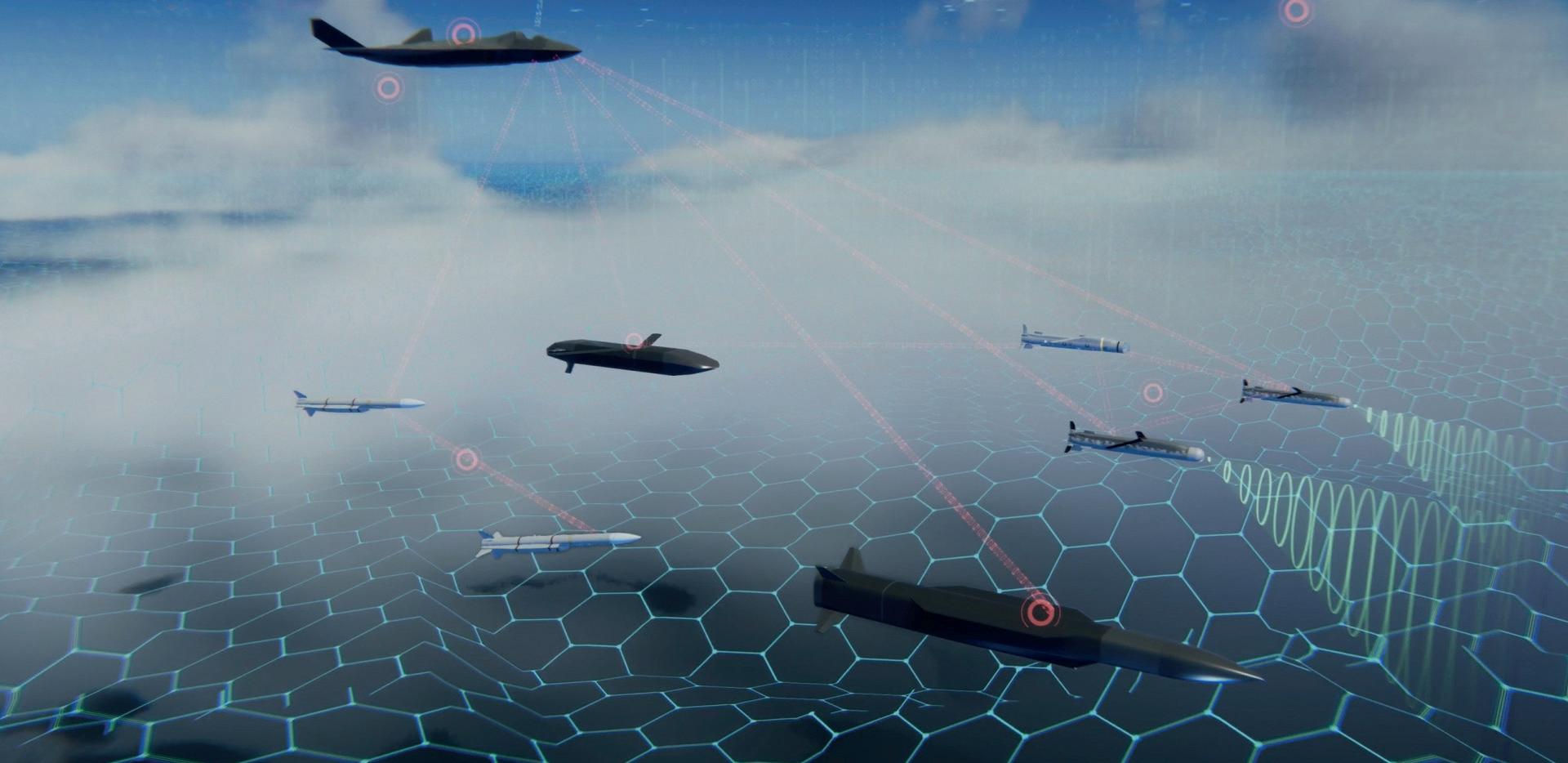
“We are working towards reducing the pilot’s cognitive burden and making the coordination of all available complex weapons in the battlespace as simple as possible”
Air Vice-Marshal Linc Taylor, Chief of Sta , Capability, and Chris Platt, Arti cial Intelligence (AI) Experimentation Programme Leader at the Rapid Capabilities O ce, reveal how close the RAF is to achieving an AI-enabled Command and Control capability
AI-augmented decision making in air command and control is only a couple of years away from being an operational reality (PHOTO: MOD/ CROWN COPYRIGHT)
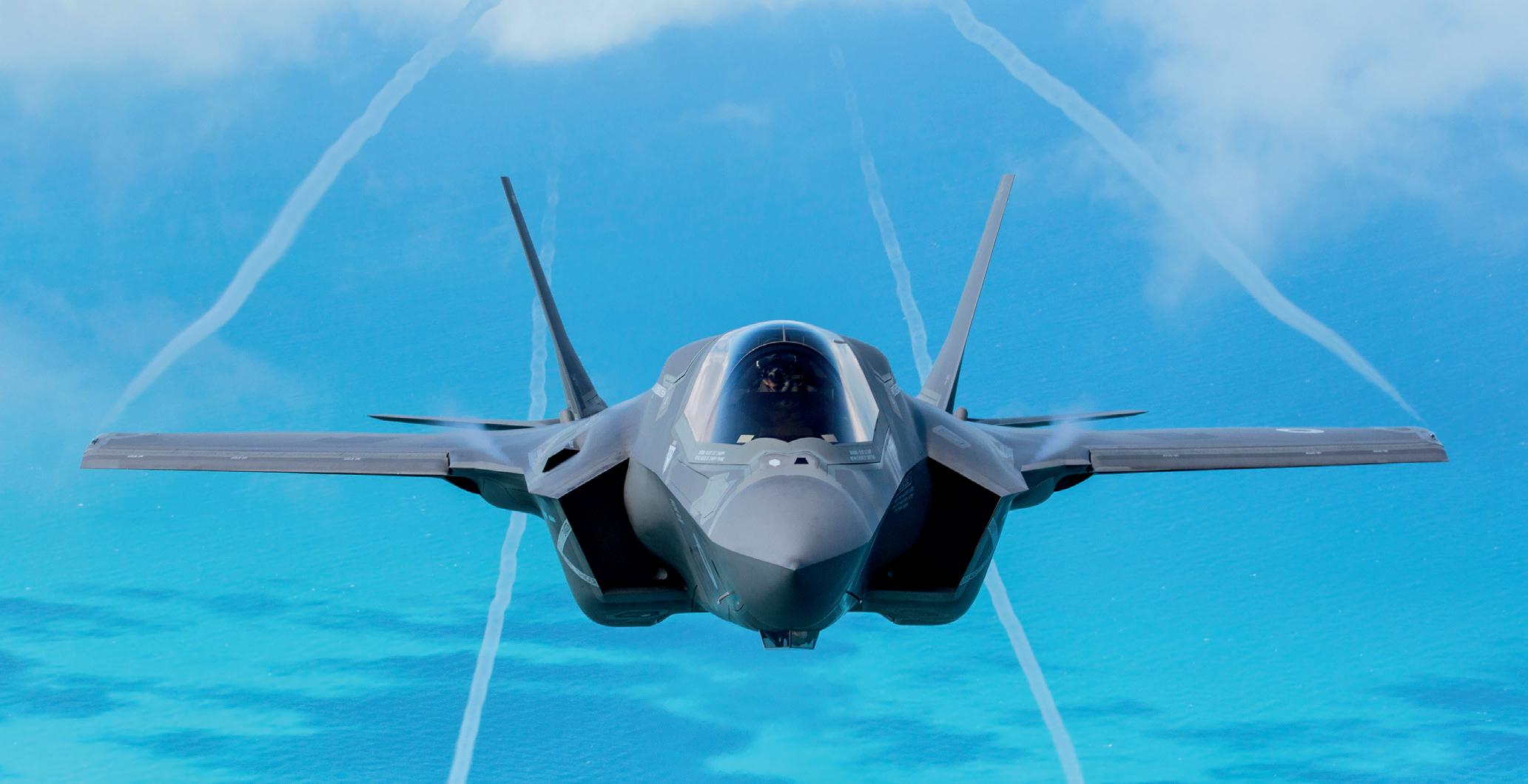
“Whoever can handle the quickest rate of change, survives…” – Colonel John Boyd
The RAF has been at the very forefront of technology since its foundation as an independent Service in 1918 – from exploiting the war ghting potential of powered ight itself and using it to revolutionise land and maritime warfare, through to the advent of airborne radar, jet propulsion, precision attack and, now, groundbreaking ights powered by synthetic fuels. Technology and innovation is in our DNA. Our immediate future is no di erent; the RAF’s Chief Technology O cer, Cecil Buchanan, recently documented the exponential changes that are likely to de ne the future environment in which we will be required to operate, ght and win.
These exponential changes are convergent; one will continue to accelerate change in another, which itself will then accelerate further. Buchanan quotes McKinsey: “We will see the same relative di erence in technologies over the next 10 years as we have seen over our rst 100 years”. Foremost in these convergent technologies are computing power, digitisation, AI and available data.
One might therefore conclude, from Colonel John Boyd’s insight into survival, that a new race is on; a digital manifestation of his A Discourse on Winning and Losing, particularly his OODA (Observe, Orient, Decide, Act) loop, where our ability to adapt and adopt to the phenomenal rate of change in digital technologies will see us overwhelm our adversary, or lose to them without our really understanding how or why we lost.
We must not be seduced by the past two decades of aerial con ict; our fourth- and fth-generation
technologies have enjoyed domain superiority over our adversaries; however, in the future it will be our ability to decide and act e ectively that will de ne our e ective use of Air Power. Our historical planning cycle will be proven to be ine ective and redundant by those operating at machine-speed. Accordingly, in the future we will win, or lose, ever faster.
Defence will, typically, have sought to understand, study, corral and de ne data standards that allow information exchange; but, in this case, relevant technologies are changing exponentially faster than our typical processes. If we maintain this approach of certainty, we might spend valuable time carefully de ning an already obsolete standard. On the contrary, our experiments have shown that modern digital ‘Babel sh’ protocols are able to swiftly share and read between standards.
Outside Defence, other sectors such as retail, banking, entertainment and logistics are already gaining business advantage by harnessing highpower compute to accelerate and improve their own complex operations. These commercial, open-source standards can be ‘wrapped’ with appropriate security for military use and are good enough now. We understand the inherent vulnerabilities and we can accredit to the highest classi cations.



Assuming that we have the appetite to use and build on these tools, we can begin to apply AI technologies, ranging from simple bulk data processing to neural net algorithms. In Al cases, the more data we have, the better our results; we must rst ensure that all of our programmes have the authority and means to collect, own and reuse our data.






We must not seek to move that data everywhere or sanction mass duplication; instead, we must progress an agile, but resilient, approach, moving mass data only when we need to and providing mesh resilience to our pathways. Once we have these data and access fundamentals in place, we can start to apply AI tools.

Work within the RAF so far has concentrated on machine-speed command and control (C2) experimentation. Our present C2 methods are almost exclusively reliant on human interpretation, processing and decision-making. In parallel, we have fewer people and an ever more complex, capable and dynamic environment. In this ‘data tsunami’, our over-reliance on humans is limiting our ability to command global air and space operations e ectively, at the speed of relevance. Adopting AI in C2 is not just about improving; it will become critical to manage the modern battlespace e ectively.
Although the RAF has been running its interoperability, connectivity and data platform
experiments and concept demonstrators for a few years under the Babel sh, Raven and Nexus series, we have just concluded our rst experiments in AI in C2 under the Air Power 4.0 demonstrations. These have already shown machine-readable Air Tasking Orders, dynamic interpretation of the live/ synthetic environment and a monitoring function to alert human operators of divergence from a plan long before we might normally identify it.
We have already introduced machine-delivered plan optimisation against a series of operator-de ned rules. When a mission plan alters or falters, our algorithm will spot it rst and provide an optimised replan of a complex mission within seconds. We recognise that we are still in the digital foothills and that our experiment constraints are signi cant, yet the solutions that Air Power 4.0 appears to o er to mission commanders are those that we would recognise on operations today; however, they are de ned in magnitudes shorter time. We will continue to progress these experiments and will, before the end of 2023, start to baseline AI performance against experienced human mission planners.
Against our converging technology exponentials, we will have more data, more computing power and better learning AI. Moreover, by fully utilising our data, modelling and synthetic environments, our machines will start to learn o ine; indeed, Air Power 4.0 already runs on our Gladiator Single-Synthetic Environment. We predict that AI-augmented human decision-making in Air C2 is two to three years from being an operational reality.
Fundamentally, we have the opportunity now to experiment, adopt and develop existing tools and standards, to enhance and deliver decision and operational supremacy now and over time. Whichever approach and technologies we adopt, we must not leave such success to our adversaries, but must keep the RAF and our war ghters at the leading edge such that when we ght, we win rst time, every time.
Demonstrations have already proven that AI can spot when an operational plan deviates or falters (IMAGE: SHUTTERSTOCK)
In February 2022, Dr Arif Mustafa became the RAF’s rst Chief Digital Information O cer. David Hayhurst asks him what his job entails and how he will enhance RAF capabilities
The Chief Digital Information
O cer is helping the RAF turn the huge volumes of data that aircraft like the RC-135W Rivet Joint (pictured) collect into valuable information (PHOTO: MOD/ CROWN COPYRIGHT)

Tasked with overseeing and implementing the digital transformation strategy that must provide the RAF with next-generation technologies and capabilities, Dr Arif Mustafa, the RAF’s rst Chief Digital Information O cer (CDIO), describes the short- and long-term goals for RAF Digital, following the exhaustive diagnostics that were recently conducted to determine the current digital capability status.
“The short-term strategy is looking at getting the basics right – in particular, our infrastructure, applications and communications technologies. That means making sure that they’re t for purpose, while ensuring that our security and protection against potential cyber
threats is intact, as well as guaranteeing an adequate governance process for making the right digital investments,” explains Dr Mustafa.
Along with ensuring that critical innovation can be delivered, much of the future transformation strategy will demand having the mechanisms, tools and strategies needed to turn the vast amounts of data collected by the RAF into valuable information. “To do that, you need to be ambidextrous in terms of balancing the needs of today and tomorrow. The nature of the RAF’s role in defending the nation has changed dramatically over the past few years,” the CDIO points out.
He feels that this can no longer be centred primarily around air power in the long-established
sense of the quality of aircraft, weaponry and people. “To gain and maintain critical advantage in the future, we must be able to use our data and information e ectively. We must be able to harness all the intelligence and data generated and captured by our aircraft and systems. We must leverage the opportunities o ered by new technologies, such as arti cial intelligence (AI), to improve our ability to interpret our data and turn it into timely, valuable information, enabling a richer appreciation of how to ful l any mission with which the RAF may be tasked.
“Digital dominance, for me, is about being able to do that really e ectively,” continues Dr Mustafa. “I can’t see any future air force being realistically at the forefront of what it does if it cannot ensure that air power and digital capability can adequately go hand in hand.”
Perhaps the most integral factor in furthering these dual considerations is increasing cyberawareness and capabilities within the RAF as a whole. “It’s not just the digital organisation that uses digital tools – it’s everybody. We are blessed within the RAF that we have really smart people who have a solid background in technology in general, many also having a keen interest in cyber technologies. We are keen to engage with them and harness their energy, to help us pursue our cyber goals,” insists Dr Mustafa.
There are currently around 3,000 people in the RAF who are in the cyberspace profession, working alongside Civil Service colleagues from the information professions. “This is a powerful and expert cohort, yet we also have weekend coders from outside these professions. For instance, we have people with computer science and AI quali cations who are pilots,” Dr Mustafa points out. “As expert users, combined with their digital skills, they have been instrumental in designing and developing applications that are making a positive di erence in our ability to execute missions. In short, we have a Whole Force capability, beyond the core digital organisation, that is astute, diligent, knowledgeable and capable in digital excellence.”
Key to supporting and nurturing this core body of digital capability is the wealth of talent to be found within the RAF’s very rich and diverse stakeholder ecosystem, including both academia and the private sector. The latter includes the major multinational contractors that have longstanding relationships with the RAF, as well as start-ups and scale-ups, mid-sized companies and large consultancies. Accordingly, regular brie ngs involving multidisciplinary teams are held with all categories of stakeholders to de ne and explain the RAF Digital’s strategic objectives. Increasingly, this is paying dividends. For example, recently, the RAF started to address an issue of building a digital model for aircrew
pipeline planning. A stakeholder with experience working with a mainstream airline company was able to provide critical input. “That’s a good example of using the ‘bigger brain’ to help us drive to a better solution faster,” says Dr Mustafa.


Within the RAF, teams such as 90 Signals Unit, RAFX (eXperimental), the Rapid Capabilities O ce and the rapid application development organisation Appivate, are driving critical digital innovation. Appivate now routinely works with pilots, engineers, ground crew and other personnel to identify various issues, and to work with RAF sta to co-create applications.
The Tanker app, developed in collaboration with Appivate, is an excellent example of how the RAF is using digital applications to enhance operational capability and e ciency (PHOTO: MOD/CROWN COPYRIGHT)
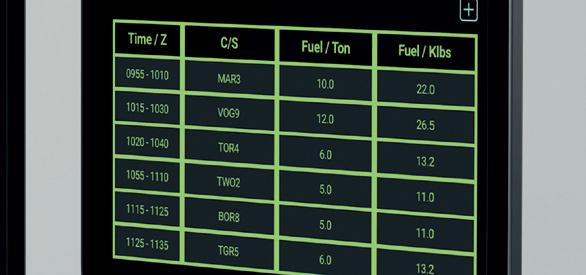
A recently delivered example is the Tanker app. Created with the support of Appivate. According to the CDIO, “It accelerates the planning process allowing us to be more responsive and gives aircrew capacity to spend more time on other aspects of the mission. Tanker automates minimum give-and-burn calculations for aircrews, which greatly improves fuelling an aircraft correctly, thereby aiding the RAF’s sustainability and its Net Zero 2040 objectives. “That’s a good example of something we have delivered that is having an impact on the way we undertake our missions,” concludes the CDIO.


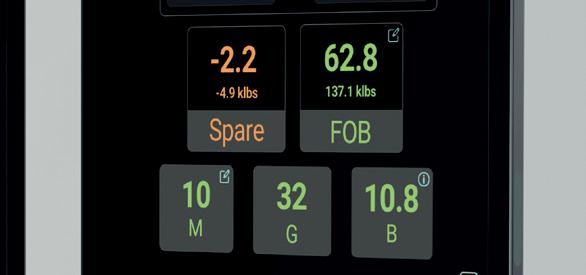


“It’s not just the digital organisation that uses digital tools – it’s everybody”
The RAF has created two game-changing components of the UK’s Combat Cloud – the Nexus data approach and Raven, a exible and scaleable software-de ned communications capability. Group Captain Ian Bews from Air Capability Strategy, and Wing Commander Dave Collins from 90 Signals Unit reveal how Nexus and Raven were developed and how they are enhancing the UK’s military capability
In the future, military combat clouds will enable real-time data sharing that will increase situational awareness and deliver decisive decision-making intelligence
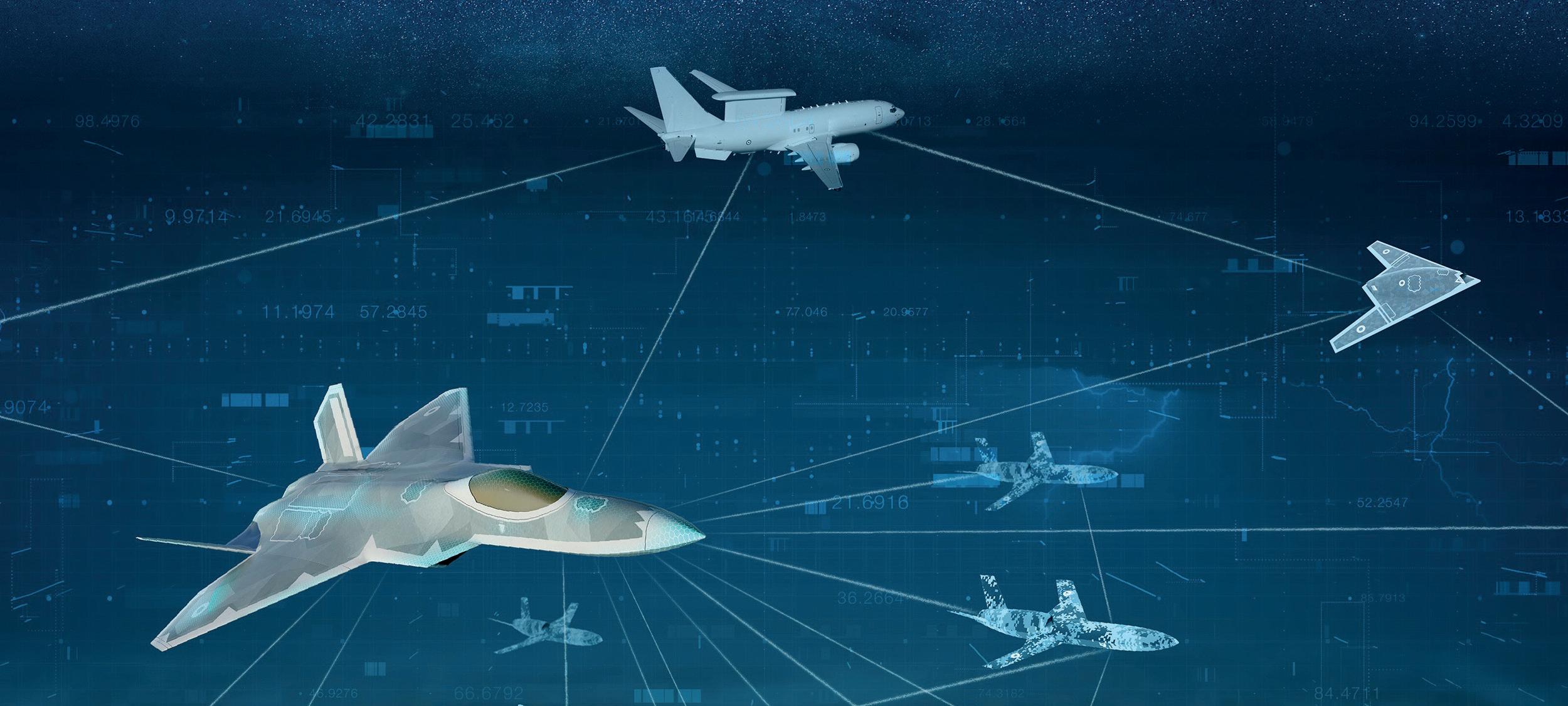
(IMAGE: LEONARDO)
“Information is no longer just an enabler, it is a fully- edged national lever of power… a ‘weapon’ to be used from strategic to tactical levels for advantage” – Joint Concept Note 2/18 – Information Advantage
Having the right information at the right time has always been critical to commanders. In the digital age, where more data and information are available than ever before, nding the right information, then deciding upon our course of action and acting e ectively, faster than our adversary, is critical. The RAF has taken a revolutionary approach to this challenge, where its aviators are rapidly developing digital tools through the Nexus and Raven projects. We now live in a digital-information age; dayto-day life involves access to much more information
near-instantly than the industrial age that preceded it. Warfare is rapidly evolving to re ect this major change within society. Commanders and personnel at all levels will expect and need more information, much faster than previously, and will need digital assistance to nd, process and make sense of this volume. As technology evolves, our new platforms –such as F-35B Lightning, P-8A Poseidon, E-7A Wedgetail and Protector – all generate more data than our existing networks and structures can handle; therefore, much of this data is currently discarded. This raw data must be curated, processed, searchable and fused to generate information, and this large volume of information must be exploited so that our war ghters have a better understanding of what is happening before the enemy does.
Traditional procurement methods for military capability do not always o er the agility needed to keep up with the pace of digital change and,
therefore, the RAF needed to take a di erent approach. These projects sought to combine the knowledge, experience and insight of our aviators with carefully selected industry partners to accelerate development, rather than handing over a list of requirements for industry to deliver.
Nexus and Raven are two complementary projects that aim to provide commanders and their sta with the information they need to make decisions at the speed of relevance within the Next Generation RAF. Nexus helps make sense of data and connects it to those that need it; Raven is a way to move that information around.
Nexus is a novel approach to data and information that enables the ‘combat cloud’. It has been developed in-house by the RAF’s Rapid Capabilities O ce (RCO) Air Information
Experimentation Team. Nexus’s unique selling point is that it can connect any data source to any exploitation point to turn it into useful information, regardless of platform, and across all classi cations. By labelling data in a common format, and then only moving this metadata, Nexus makes best use of limited connectivity to create a searchable and useable information layer in any digital stack. It then allows the transfer of bulk data by exception if required.
It is also a hosting platform on which applications and services can be rapidly developed, allowing the display and manipulation of multiple data streams at di erent classi cations within a single system. With possible uses spanning logistic tracking through to linking aircraft sensors and commanders, Nexus’s rst operational capability demonstration uses a mapping and display tool to combine open-source information with classi ed frontline data to improve situational awareness.
Raven is a digital communications capability optimised for air operations that was designed in-house by RAF personnel in 90 Signals Unit, based at RAF Leeming. It o ers a secure, exible, scalable digital backbone to enable operations in the information age. Raven delivers secure voice and data services at all security classi cations with a dramatically reduced size, weight and environmental impact, compared to current capabilities. Able to link many users, it provides the comms ‘glue’ that brings together squadrons, headquarters, sensors and platforms across all domains.
Raven was created by a team of technicians at 90 Signals Unit who had experience of deploying communications systems on operations and exercises around the world. Frustrated by the shortcomings of current technology, they set out to prove that better integration of commercial
and open-source software with hardware optimised for the RAF could create a system with better performance at a greatly reduced cost.
At the heart of Raven’s success is its design philosophy built on three principles: security at the heart of the design to ensure rapid accreditation; a focus on services and information, rather than speci c systems or applications; and getting capability into the hands of users at the earliest opportunity within the development cycle.
For Nexus, the RCO set up an RAF-led, contractor-supported team, which meant that all Nexus intellectual property is wholly Ministry of Defence-owned. This then allows the RAF to roll out Nexus to support all aircraft and systems, even when they are provided by di erent companies.

In both cases, the key to the success of the project is people. Empowering our aviators, giving them the opportunity to develop their skills, and giving a sense of ownership has resulted in solutions that are better suited to the challenging requirements of the RAF today and tomorrow.
Both Raven and Nexus are currently operational concept demonstrators. However, unlike many traditional projects at this stage in development, they are in use on live operations both in the UK and overseas. The challenge that the RAF is now addressing is how to get capabilities like Nexus and Raven, which have been developed away from the traditional procurement pipeline, into full service, while retaining the agility and ownership to ensure that they can be rapidly developed to meet new requirements. This requires changing to a product mindset rather than a project approach, with constant spiral development replacing traditional linear capability development. These problems are now being solved as we move Nexus and Raven into core delivery to ensure the RAF continues to deliver operational advantage for the UK within the information age.
Group Captain Gary Darby, Head of the Joint Counter-UAS O ce (JCO), tells Alan Dron how his team is developing counter-drone capabilities while keeping a close eye on the costs
C-UAS is already playing a key role in improving the RAF’s understanding of how it can employ technology in response to the threat posed by hostile drones (PHOTO: MOD/ CROWN COPYRIGHT)
The threat from uncrewed aerial systems (UAS) has never been greater or more evident, as the con icts between Ukraine and Russia, and Armenia and Azerbaijan have undeniably highlighted. Intelligence has clearly shown that, in both these con icts, each participant has made extensive use of UAS, for reconnaissance and attack missions.
It is not surprising then that counter-UAS (C-UAS) activity has become more vital than ever, and the UK is consequently stepping up its activities
in the eld. Coordinating this activity is the task of the Minsitry of Defence (MOD)’s Joint C-UAS O ce (JCO), which, among its multiple lines of e ort, aims to oversee emerging technologies that may be of use in defeating unmanned aerial platforms. “What we’re trying to do is avoid stovepipes,” says Group Captain (Gp Capt) Gary Darby, head of the JCO. “The risk is that, with limited resources, we can’t a ord to develop capability in isolation; we need to coordinate, cohere, in uence and exploit every opportunity across Defence,” he continues.
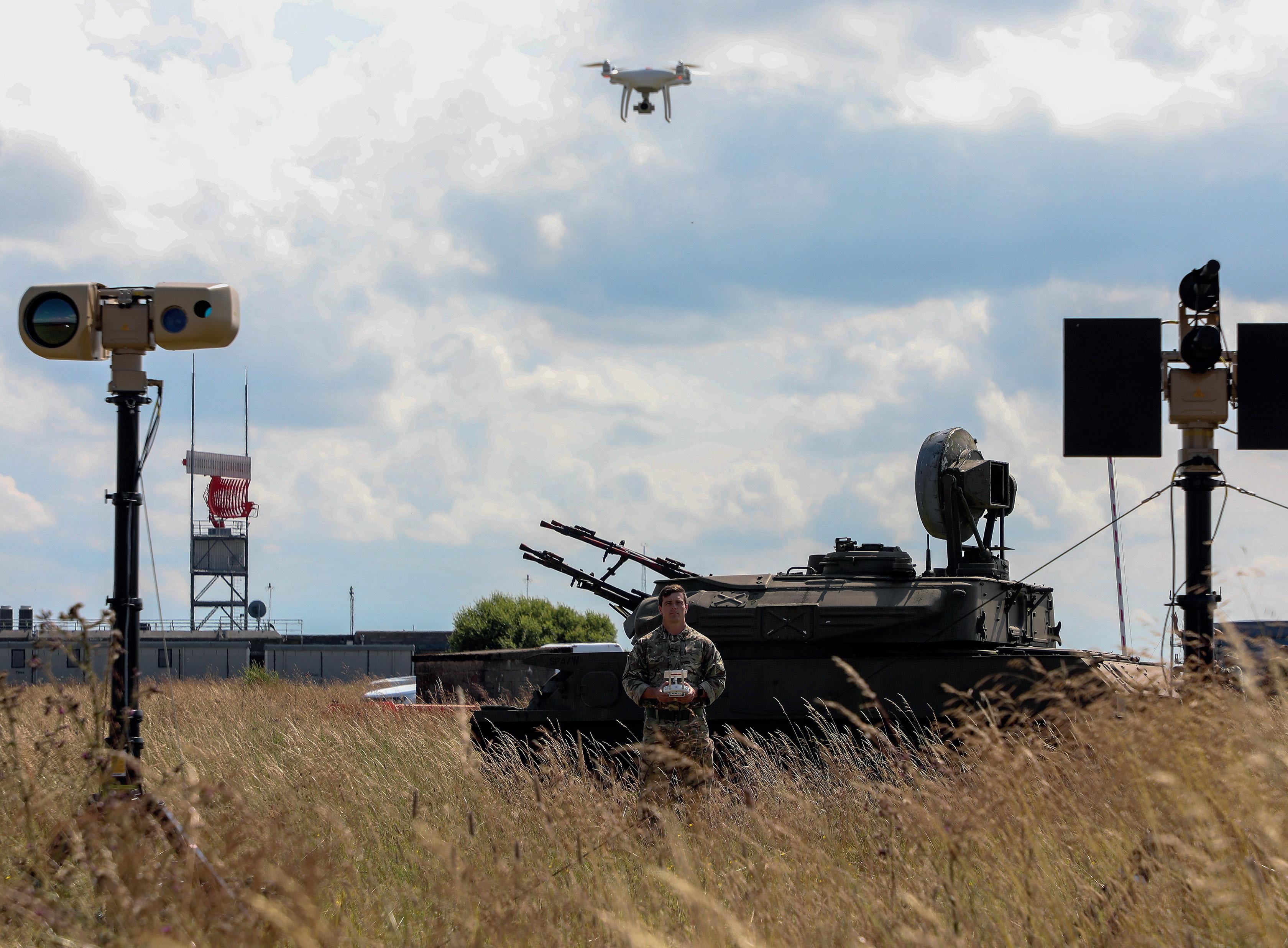
The JCO aims to be a force multiplier, making the most of limited Defence resources. Individual single services cannot necessarily devote as much time as they might like to engaging with industrial organisations that may have potential solutions to counter the UAS threat. For that reason, one of the JCO’s main roles is to act as a ‘matchmaker’ between companies with leadingedge C-UAS technologies and the Armed Services. “Companies will approach us and say, ‘We’ve got this capability, it’s new to market, it’s innovative.’”
This approach will trigger an hour-long virtual meeting, during which the company gives a presentation and undertakes a Q&A session. Once this initial stage has been completed, the JCO will speak to its Defence partners and ask whether they want to go and physically see the proposed C-UAS solution. This initial stage helps to identify capabilities that are proven and will t into Defence’s requirements, thus saving time and money for all of those involved.
Products that are of interest can be passed on to the Rapid Innovation Centre, delivered by defence systems company QinetiQ on behalf of the MOD. These can then be assessed at the West Freugh Range at Wigtownshire, south-west Scotland, where there is a fully calibrated scienti c test range. The costs of the company providing the product are covered by the MOD, allowing small, innovative start-up companies to get the same opportunity as major defence primes.
The product is then tested against UAS platforms. “We’re able to see how they perform and, equally importantly, industry can see how their products perform against our standards. We o er advice and they can see any gap between what the system does and what is needed,” explains Gp Capt Darby.
C-UAS operations have to adopt a multi-layered ‘onion’ approach. For example, while much publicity in recent years has been given to ri elike devices that can jam the electronic link between a drone and its operator, these will not work where the drone is autonomous and not reliant on constant direction from the ground.
In order to detect, track, identify and defeat a hostile device, “C-UAS is not usually a singular system, it’s an integrated system of systems,” Gp Capt Darby explains. Electronic sensors are used to identify a drone by its electronic signature; radar and optical cameras are used to track it; and kinetic or nonkinetic systems can be used to defeat it. The latter systems include evolving microwave or directed energy technology. “Time is our friend,” insists Gp Capt Darby. “The earlier we can detect incoming
UAS, the more time we have to bring e ectors into bear. The integration of ground, air and space-based detection systems will be fundamental to success.”
A further factor that has to be taken into account is the cost of downing a hostile UAS. A commercial, o -the-shelf drone might cost just a few hundred pounds, so it makes little sense scrambling a ghter jet to shoot it down with a missile costing several hundred thousand pounds, especially as the instances of swarm drone attacks are on the increase, as we’ve seen in Ukraine.
One area that the JCO is studying, therefore, is novel weapons that can bring down a UAS at much lower cost - for example, a directed energy weapon, drone-on-drone capabilities or a purpose-designed frangible cannon round.
While primarily focused on global military operations, Defence’s C-UAS capability also has a role in protecting the ‘Homeland’ and is often deployed to protect major events. The late Queen’s funeral and the Commonwealth Games were major national occasions covered by C-UAS defences.
The need for C-UAS research and deployments will only grow exponentially, says Gp Capt Darby: “We’re looking to expand signi cantly over the next 10 years.”
C-UAS is more cost-e ective for downing commercial, othe-shelf drones than using a fast jet, for example (PHOTO: MOD/ CROWN COPYRIGHT)
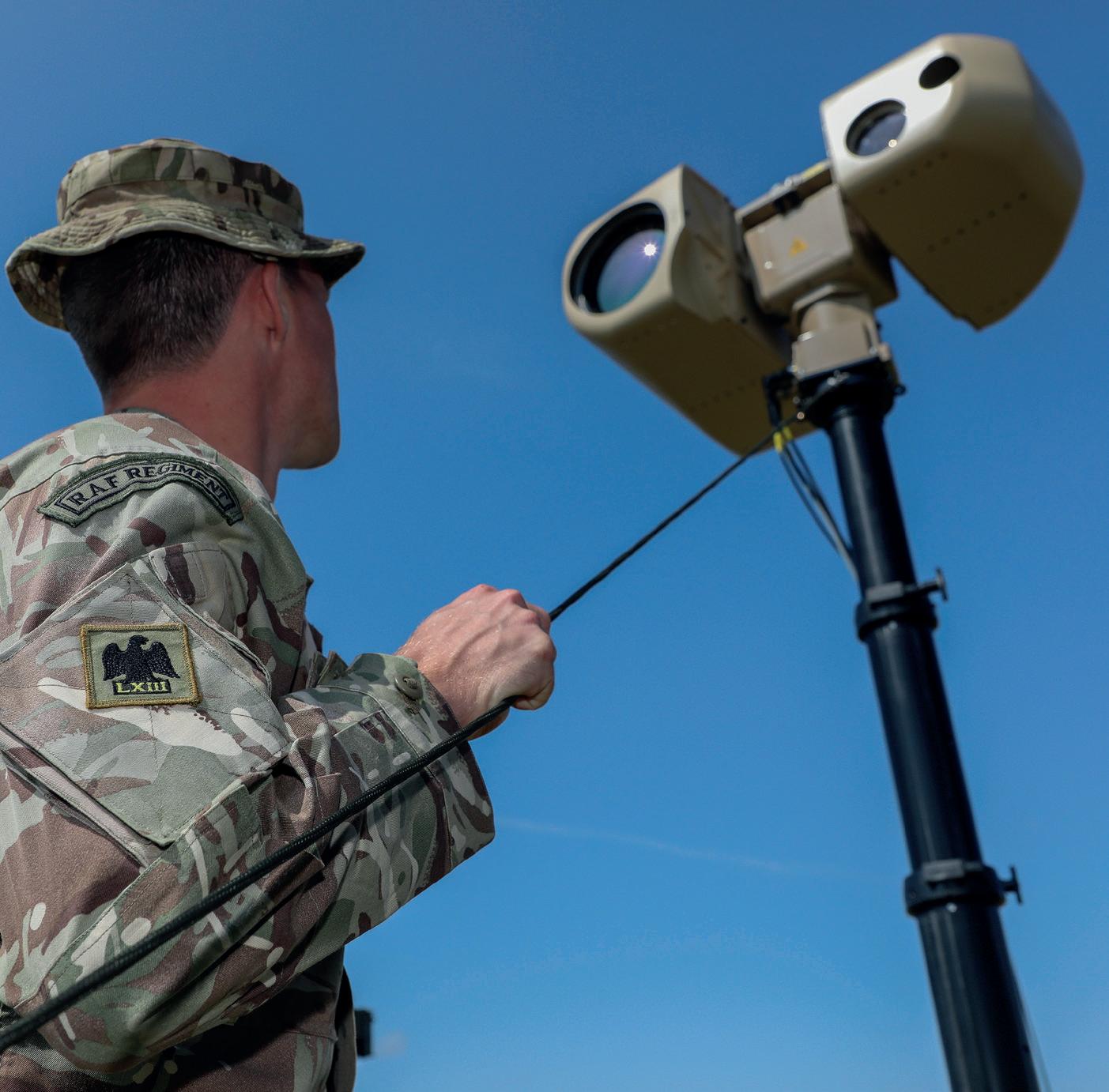
To deliver the people of the Next Generation Air Force, the RAF is driving forward attraction, recruitment and retention initiatives. Jenny Beechener asks Chief of Sta Personnel Air Vice-Marshal Maria Byford how the changes are taking shape and what bene ts are already being delivered to career opportunities
The RAF Air Cadets forms an excellent pathway into a career with the RAF and beyond (PHOTO: MOD/ CROWN COPYRIGHT)

The RAF needs a highly technical workforce to maintain its operational ghting edge, with science, technology, engineering and mathematics (STEM) skills at the forefront, alongside an exponential growth in the requirement for cyber and digital expertise. Air Vice-Marshal (AVM) Maria Byford, Chief of Sta Personnel, says that being an employer of choice when these skills are in short supply is driving changes in recruitment and retention across the force.
In a fundamental shift, the RAF is replacing its traditional structure of 68 Branches and Trades with 11 Professions. Since the process began in 2021, ve Professions have ‘graduated’: chaplaincy,
ying, legal services, medical and people operations. Expert advisory teams continue to map and de ne the competencies required to realise the remaining six Professions – air operations, cyberspace, engineering, intelligence, logistics, and security and resilience – between now and 2025. The new structure supports more exible career progression based on competencies derived from skills and experience, which can be matched to employment opportunities, creating exibility and greater choice for both the individual and the organisation.
Professions will also allow the RAF to reward and remunerate people in a more agile way that re ects these competencies, explains AVM Byford.
“Rather than focus on rank and seniority, the new system will recognise and reward specialist talent development and quali cations. An example would be an engineer who gains cyberspace competencies, giving them the opportunity to slip streams, as well as to acquire a broader career base.” This is particularly relevant in ensuring a more uid route for skilled individuals joining the RAF later in their career. “The new structure aligns more seamlessly with the careers people would have outside the armed forces, enabling lateral entry and exible journeys between di erent types of employment,” explains AVM Byford.
In another move away from traditional work patterns, exibility extends to employment terms and conditions that give individuals more choice in how they balance work and life. “We are developing more agile journeys between types of employment, ranging from full commitment Regular service to the Part-Time Voluntary Reserve. We also bene t from a pool of Volunteer ex-Regular Reserves that we can call on for their skills and experience, which allows individuals to ex their commitment and readiness to pursue other interests or employment opportunities, and still be able to contribute to our ghting power.”
This is increasingly relevant in a post-Covid world in which workforce expectations have changed. “We need to match what our industry partners are doing to guard against losing talent to the defence and aerospace sectors, including working with them around managing career pathways.” For example, an individual might train and work for the RAF during the rst half of their career, before moving to the defence sector in the second half. In the words of AVM Byford, “We have Managed Career Pathway agreements in place with certain industry partners that enable aviators to follow this route at a set point in their career, ensuring a full return on the training investment and meaning that the partner then knows when they can access those skilled individuals.”
Take-up of exible working arrangements has also risen as aviators choose to adjust their worklife balance: applications for Alternative Working Arrangements have tripled since 2020, while over 200 aviators have chosen Flexible Service, enabling a scale-down of commitment and/or readiness for a de ned period. Overall, almost 3,000 sta (10% of total employees) have applied for work-life balance options, which allows them to manage and prioritise other competing demands.
Broadening the appeal of the RAF remains a key focus. “The highly technical skills we need are in short supply, so we have to reach all the available
talent in the UK workforce,” explains AVM Byford. “While 51% of the UK population are women, we are recruiting less than one in ve at present.” She focuses the conversation upon inclusion, rather than diversity, meaning everyone is treated fairly and has “equitable access”, levelling the playing eld for all applicants. “It’s about understanding and acknowledging that people are di erent, yet ensuring there is a working environment that makes everyone feel included and valued for their contribution.”
Attracting diverse talent also means increasing the RAF’s engagement with a broad range of communities and demographics. An excellent example is the Air Cadet Organisation, which brings over 42,000 young people into contact with the RAF and enables them to learn leadership skills, experience ying, take part in science and technology activities and have an opportunity to learn what service life might be like for them. “Our job is to enable access and show the cadets what the RAF is about, and what it can o er as an employer of choice. By increasing our attraction, we are doing all we can to recruit the very best people and successfully build a workforce that is t for the future.”
Casting the net more broadly over British society will improve access to the skills the RAF needs (PHOTO: MOD/ CROWN COPYRIGHT)



Air Vice-Marshal Fin Monahan, Director of the Developments, Concepts and Doctrine Centre (DCDC) at Shrivenham, outlines the role that the Centre plays in evolving UK Defence capability
“Iknow you do really great stu at DCDC. Although, I’m not quite sure what it is you actually do.” That’s what somebody from Head O ce said to one of my team recently and I know they’re not alone. As much as it’s nice as the new Director of the Development Concepts and Doctrine Centre to hear that people think we do great stu , if they don’t know what that stu is, we’re missing a trick. I wonder, what would you say DCDC does? Do you think what we do is relevant to you?
We were established – originally as the Joint Doctrine and Concepts Centre – as a result of the 1998 Strategic Defence Review. Defence needed to have a clearer long-term vision of how our forces operate and the way they would need to develop. Without a conscious e ort to look forward, the risk that we would just prepare to re- ght the last war using the next generation of the same platforms and weapons was very real.
Long-term thinking can all too easily fall victim to a full inbox and today’s urgent issues – what one of my Swedish colleagues calls “the thundering present”. So, for the past 23 years we have been the Defence think tank examining the future, as well as drawing lessons from current operations and exercises.
As a think tank, we don’t make policy decisions or investment choices, but we seek to
inform those that do. And we do so across the full range of force development issues, through our futures, concepts, doctrine and legal work.


If you’re familiar with only one thing we do at DCDC, there’s a fair chance it’s our Global Strategic Trends (GST) programme, which delivers what we call strategic foresight and takes a very broad view of the world. What are the factors that will shape the environment, the economy, society and global geopolitical systems? Where will power lie? What technologies might be available in future that we should be thinking about now?






We will publish the seventh edition of GST early in 2024. It will provide the long-term context for the Ministry of Defence (MOD) and wider Government as they conduct the next Security and Defence Review. But it has wider impact too; many of our allies and partners use it to inform their own policy and planning processes; NATO uses it as one of the start points for Alliance foresight work; and it is also used across the world by academics, think tanks and private-sector organisations, as well as other Government Departments. The secret of GST’s success is the global network of contributors that make it a truly global publication.

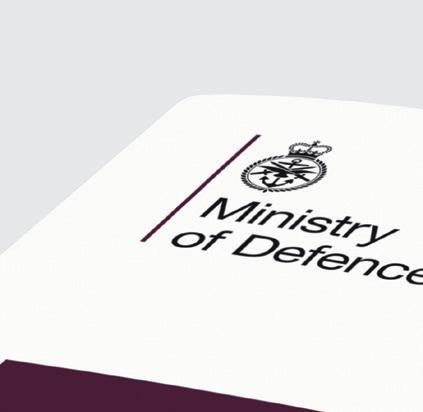

As well as informing others, GST is the basis for our thoughts on the Future Operating Environment for military organisations. What threats and opportunities might emerge; what operations might we be conducting, in what environment, with what capabilities, alongside whom? And, secondly, our thoughts on a Future Operating Concept – how might we organise and employ the military instrument, in concert with allies and partners, to seize the opportunities and tackle the threats we anticipate?
Concepts are ideas. Unless, and until, they are adopted and operationalised by the Department they don’t represent policy; they are not how we actually operate and ght now. But they can be hugely in uential in stimulating debate at all levels of Defence. They can also, and sometimes need to, make uncomfortable reading, challenging conventional wisdom and our attachment to treasured capabilities, approaches and mindsets. What we at DCDC need to develop – and, arguably, others in Defence also need to develop – is an ability to test and experiment on a much greater scale, leveraging the opportunities presented by arti cial intelligence, machine learning and other emerging technologies to re ne our thinking.
Having said you’re most likely to have heard of our GST programme, if you have served in UK Defence or NATO, you are likely to have used – consciously or otherwise – our joint doctrine. Doctrine captures the fundamental principles and philosophies that guide military actions; this is our ‘way of war’. Unlike concepts, doctrine represents current Defence and NATO policy – it is, therefore, authoritative.
If you’ve gone to sta college, doctrine is what you were taught, even if it wasn’t labelled that way. If you have planned or been on operations or supported the civil authorities during the pandemic or following a natural disaster, pretty much every aspect of your activities and the training beforehand will have been guided by doctrine. Thus we refer to doctrine as the guide rail for operations; it is what we use as the basis for teaching in our training schools and sta colleges – not only in the UK, but across NATO. And it is in NATO that we really see how powerful the doctrine tool is. Since the inception of the Alliance, doctrine has played a major role in aligning language and common military philosophies and principles, such that we have a common and extremely e ective way of operating and war ghting across 31 nations that have very di erent languages, cultures and histories.
For more than 10 years, it has been MOD policy to use NATO doctrine wherever we can,
thereby reinforcing our interoperability within the Alliance. Indeed, as a single nation, we hold the most custodianships of joint doctrine within NATO, ensuring we have an in uential role in shaping how the Alliance operates and ghts today.
The nal string to our bow is a legal one. We have a small legal team whose work has far-reaching consequences. The team has custody of the Manual on the Law of Armed Con ict, intended to enable all of us to stay on the right side of the law in planning and conducting operations or training. If we get that wrong, the damage to individuals and to our reputation can be really signi cant. The legal team also conducts weapon reviews, identifying whether and how international law impacts on the introduction of new weapon systems.
All of that adds up to an organisation that is wrestling with issues that span from today to 30 years into the future. To bring challenge and fresh perspective to our work, we lean heavily on our allies and partners, including through the presence of 11 international sta with us at Shrivenham. Five of those are from Sweden, and this summer we will celebrate the 10th anniversary of also serving as the Swedish Armed Forces Concepts and Doctrine Centre. Knowing that a close partner relies on our products in this way is a great source of pride, but also brings a real sense of responsibility.
So, for the person from Head O ce who asked the question, I hope that I have explained what we actually do. Our work is fascinating and important in equal measure and it touches on the way we will operate and ght today and tomorrow. Please feel free to join the debate. Whether it’s discussing the future or thinking about new ways to employ the military today, you can have your say by following us on Twitter @MOD_ DCDC and @DirectorDCDC, or accessing our full range of products using the QR code.
Air-to-air refuelling training: almost every aspect of training is guided by doctrine – the fundamental principles and philosophies that guide military actions (PHOTO: MOD/ CROWN COPYRIGHT)

and Dutch air forces. It has demonstrated its impressive performance in military support operations, joint exercises with the United States Air Force (USAF), and in support of humanitarian missions to the Lebanon, Haiti and the evacuation of Brazilian nationals from Ukraine.
development. The company’s focus is on adapting techniques, technology and materials to deliver sustainable and a ordable solutions to meet the world’s aviation challenges.
Bosco da Costa Junior President and Chief Executive O cer, Embraer Defense & Security
Can you describe how Embraer is supporting the RAF’s


The RAF has been using Embraer aircraft to train pilots for over 35 years. This long association began in 1985, when the RAF selected the EMB-312 for pilot training. The relationship continues with the Phenom 100 Executive Jet, which delivers multiengine pilot training within the UK Military Flying Training System programme. In 2017, Embraer delivered the rst of ve Phenom Executive Jets to A nity Flight Training Services, and the eet continues to be operated by A nity from RAF Cranwell.
Today the C-390 multi-mission transport aircraft has rede ned the future of multimission airlift and air-to-air refuelling. It has been in service with the Brazilian Air Force since 2019 and has already been selected by the Portuguese, Hungarian
The A-29 Super Tucano is the close-air support aircraft of choice for more than 16 air forces, including USAF, especially in support of endemic and enduring counterinsurgency operations, where the combination of its low operating costs, rugged performance and 21st-century mission systems delivers highly coste ective and relevant air power.
Embraer is also focused on incorporating the very latest maintenance design concepts to drive down whole-life costs, o ering operating costs that are up to 30% less than those of our main competitors. Most notably, the C-390 multimission transport aircraft is already delivering exceptional reliability and availability levels, and the Brazilian Air Force has already achieved a mission completion rate of more than 99%.
Furthermore, Embraer’s Praetor and Phenom Executive Jets o er exceptional class-leading runway, range and capacity performance. They continue to support Government transportation and special mission operations in a variety of ISR and other roles.
At Embraer, over 4,000 employees are committed to research and
Embraer is guided by the UN Sustainable Development Goals, which are fundamental principles of the UN Global Compact. Embraer’s goal is to decarbonise our direct and indirect operations, focusing on carbon reduction and e ciency. This includes all Embraer’s processes, product development and the standards we demand from our supply chain.
Our priority is to join with strategic partners and invest in R&D for solutions such as electri cation and sustainable aviation innovations. A key feature of these activities is the creation of EVE, a ground-breaking Urban Air Mobility company, to deliver a safe, accessible and green air mobility ecosystem. It is also worth noting that the C-390 transport aircraft has already operated using sustainable aviation fuel.
“At Embraer, over 4,000 employees are committed to research and development”
Group Captain Ryan S Morris, Assistant Director Plans at the Directorate of Flying Training, o ers up a reassuring account of the current state of UK military ying training and a compelling insight into its future

The UK Military Flying Training System (UKMFTS) encompass the full breadth of fast-jet, multi-engine and rotary pilot training, as well as supporting various mission aircrew training requirements, and the system continues to evolve to meet front-line requirements. In the near term, Defence focuses on maximising the capacity of our system, while adapting it to support the contemporary operational environment. Beyond the 10-year horizon, what the next iteration of the system will look like is yet to be detailed, yet we remain focused on our established principles in that we must continue to inspire the workforce of the future through delivering
an e cient, world-class training system that will enable our Next Generation front-line forces. Reducing the fth-generation training gap while training enough jet pilots to meet front-line demand is a global issue. The enhancement of our basic fast-jet training pipeline through additional Texan aircraft, another ight training device (FTD), increased instructor numbers and improved training system design will provide a step-change in capacity and a solid foundation from 2025 to assure that we continue to meet this challenge. Additionally, our fast-jet training enhancement initiative has trialled a range of developing technologies and human performance concepts. It has demonstrated
Airbus helicopter Jupiter HT Mk1 (H145) provides advanced rotary-wing ying training
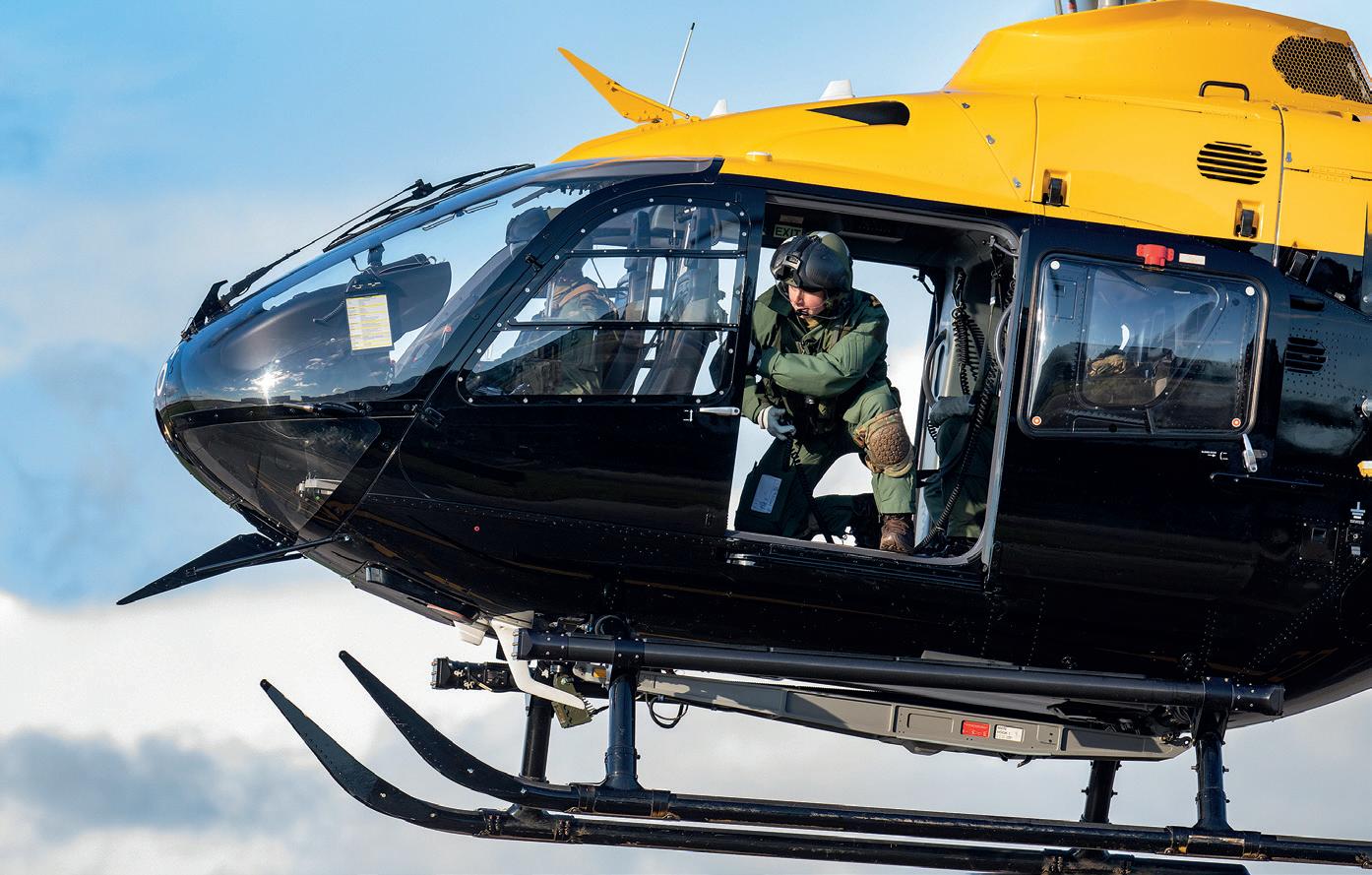
(PHOTO: MOD/CROWN COPYRIGHT)
potential for improved sortie preparation and mission rehearsal, and its end-to-end integration within the UKMFTS should improve capacity, increase rst-time pass rates, reduce time in training and provide a better trainee experience. UKMFTS also plans to develop its Hawk ying training devices with mixed-reality headsets and force-feedback controls to improve delity and enhance utility.
Another initiative is to develop capacity within the multi-engine pilot training pipeline by maximising the potential of existing enablers. Changes to training concepts are anticipated, and targeted tactical training will tailor operational skills to the needs of air mobility and ISTAR front-line requirement. Refocusing the instructor-pilot role could also provide greater opportunity for crewcooperation training, and adaptations to targeted delity simulators will provide opportunities to download additional training into the syllabus.
Later in the decade, further exciting developments are already in progress. Responding primarily to the RAF’s step-change in ISTAR capability, UKMFTS partners will deliver the Future ISTAR and Rear-Crew Training System (FIRCTS) in 2026. This investment will recapitalise the training infrastructure at RAF Cranwell and RNAS Culdrose, and will introduce state-of-theart synthetic training opportunities for trainees. The ageing Avenger aircraft and its associated ground/air mission systems will also receive a signi cant upgrade that will underpin this key training environment to provide a world-leading training facility.
Further fast-jet training enhancements are also anticipated, which aim to reduce the number of live ying hours consumed. A proposed development of linked Hawk ight simulators, with perfectly
synchronised controls to form a virtual tandem cockpit, is intended to improve student instructor training, support instructor continuous training and provide a safe environment to conduct remedial training for ab-initio pilots. Following this, a conceptual plan is to consider the employment of augmented reality in the live training environment. This capability would replicate formation or aggressor aircraft by displaying virtual entities to the pilot in the cockpit. While these areas remain conceptual, they have the potential to fundamentally change the way we train today and to ensure that the training system remains relevant.
UKMFTS must not stagnate, and ‘MFTS Next’ is only a decade away. Ahead of us lies an array of technologies that were not available 20 years ago. Each of these pose opportunities that need to be developed, yet evident themes are already present:
– Human Performance Performance coaching trials have highlighted the bene ts of mental rehearsal and virtual reality (VR) learning scenarios, and the use of biometrics, ‘Big Data’ and personalised learning presents exciting opportunities;
– Analytics The development of analytics into head-movement, eye-movement, decision-making processes and various other areas has been in progress for several years. Recent improvements in computerised algorithms and arti cial exploitation of the vast quantities of data becoming available has the potential to improve training practices;
– Automation Arti cially Intelligent (AI) instructors have the potential to o -load instructors and enhance self-learning;
– Immersion VR, mixed reality (MR) and augmented reality (AR) headset performance continues apace, and AI air tra c control has the potential to add real-world frictions in the simulated environment –an area that has been missing to date.
We do, however, continue to aim at a moving target, which presents a challenge that we cannot lose sight of. The rapidly changing human landscape from Millennial to Gen Z, and the newly emerging Gen Alpha cannot be ignored. That, together with the prospect of more capable and complex aircraft and new capabilities, means that we must continue to develop our system in a exible and agile manner, so that we remain ready to adapt to ever-changing demands. This remains a fundamental consideration and must be kept at the very forefront of our thoughts and planning, if we are to remain ahead of our potential adversaries.
This plan allocates trainees to classes in the Phase 2 pipelines, aiming to reduce their overall time in training, while achieving combat-ready status on their eventual front-line units.
What progress is Ascent making on its most pressing priorities and what di erence will this make to the UK military ight-training drumbeat?
Tim James Managing Director, Ascent Flight Training
How is Ascent Flight Training ensuring that the UK has su cient military aircrew in the pipeline?
Much has been reported recently on the health of all three phases of our Military Flying Training System (MFTS) – from recruitment and selection, through to the front-line Operational Conversion Units (OCUs).
Ascent, as one of several key industry partners within this system, has a critically important role to play in providing the right number and quality of trainees to the OCUs, at the right time, from our Phase 2 UKMFTS training pipelines.
Harmonisation of the overall training system is now well under way, with Ascent supporting through the provision of our annual Flying Training Plan, set against the Phase 2 requirements of all three Services, across our xed-wing, rotary-wing and rear-crew pipelines.
Ascent Phase 2 UKMFTS programmes have another busy year ahead, making full use of our 110 aircraft, more than 100 simulators and our joint instructional teams, operating across the six UKMFTS locations.
What have been the highlights in recent xed-wing training?
Looking to the future, Ascent continues to build and evolve the UKMFTS programmes to meet the emerging needs of our military services. The expansion of our xed-wing Basic Flying Training service at RAF Valley is progressing, with four additional Texan T1 aircraft already operational. The new infrastructure was completed in May 2023, and the additional simulators are on schedule for delivery later this year. This takes our capacity from 36 to 53 trainees per year from 2025, in this section of the fast-jet pipeline.
How is rotary-wing training progressing?
Our teams have, together, amassed more than 130,000 live- ying hours to date, complemented with over 85,000 simulator hours – providing trainees with an optimised live/synthetic experience for each stage of their Phase 2 journey. Trainees face increasingly demanding scenarios as they progress through the UKMFTS pipelines – testing their skills in disciplines that include low-level night ying and modern weapons employment – all with the aim of better preparing them for their operational careers.
Our rotary-wing operations across RAF Shawbury, RAF Valley and AAC Middle Wallop continue to test and prepare trainees. Both pilots and rear crew are operating in increasingly realistic whole-crew and multi-ship scenarios, the expansion of the programme to meet SDSR15 requirements is now well established, three additional H145 aircraft are operational, and our rotarywing only pipeline is well under way for Army and Royal Navy trainees.
Across all our UKMFTS pipelines, Ascent continues to invest for the future, and a signi cant amount of our focus is on the digital transformation of the system. We are now capturing and utilising the value in the large data sets generated from the training systems, using COTS applications to better understand performance and continuous development, while o ering safety improvements such as ight-data monitoring across our aircraft types.
“Across all our UKMFTS pipelines, Ascent continues to invest for the future”
Cybersecurity skills are in huge demand worldwide, and attracting su cient people to assure data and achieve information advantage is a challenging prospect. Alan Dron talks to Wing Commander Martin Smith of the Cyber Reserve Force to nd out how the RAF is tackling this issue
The idea of a Cyber Reserve Force that could tap into the expertise within the civilian world arose out of the 2010 Strategic Defence and Security Review, which recognised that the cyber threat was likely to grow exponentially in both scale and sophistication. There was clearly a need to improve the UK’s defensive and o ensive cyber capabilities, as well as provide ‘information assurance’, explains Wing Commander (Wg Cdr) Martin Smith of the Cyber Reserve Force.
Boosting numbers within the cyber realm meant looking to the civilian world for assistance.
One important move was the recognition that civilian expertise might come in all shapes and sizes; for that reason, the physical and tness requirements of the mainstream Reserves have not been applied to the cyber specialists.
Today, there are four new Reserve cyber units across Defence – two tri-service, one Royal Navy and one RAF, along with an existing British Army unit – initially created after an advertising campaign on the LinkedIn website. The RAF cyber strength supports o ensive and defensive capabilities in the tri-service units and 6 Cyber Reserve Squadron (6 CR), which is a squadron of 90 Signals Unit alongside its

The range of skills and the up-todate knowledge that reside in the civilian world and industry is vital for the future of the RAF (PHOTO: GABRIEL PEVIDE/ISTOCK)
regular sister squadron, 591 Signals Unit. The number of personnel in the unit is not being revealed.
Initial training is classroom-based, partly in recognition of the fact that the new recruits have not been through basic military training, because squadron members are not deployed on overseas operations. However, as you would expect, all entrants have to go through Developed Vetting, a highsecurity clearance process, before they join their units. “It’s a very niche capability that has bespoke terms and conditions of service (TCOS),” says Wg Cdr Smith.
One bene t of recruiting from the civilian world has been that informal networks between cyber specialists in industry have been used to bring in personnel: “A lot of recruitment is by word of mouth, or people looking for cyber jobs and coming across our web page. We’ve also done some more active recruiting, particularly looking for women, who make up around 14-15% of the UK cyber industry. We want to increase our female numbers.”
Many of the unit’s personnel hold senior positions in industry, such as the vice-president of a multinational cyber company. Another is a software engineer from the motor industry, while others are members of the National Crime Agency’s National Cyber Crime Unit and the wider cyber industry and academia. One, a Flight Sergeant in 6 CR and a senior operations manager at one of the police’s Regional Organised Crime Units, points out that he can bring “a di erent way of doing things that helps the Regular Forces understand their opportunities” in the cyber sector. It is vitally important that the Services gain that industry knowledge and experience, says Smith. Indeed, the Chief of the Air Sta has recognised the value of the Cyber Reserves, and directed that the RAF grows the Cyber Reserve presence in Northern Ireland, where there is an extremely strong cybersecurity sector.
Unusually, all join the RAF as Non-Commissioned O cers (NCOs) – usually at Corporal level – with timebased promotion to higher rank. However, this has posed a problem in a highly hierarchical organisation such as the military, where rank is usually equated with experience, capability and expertise, explains Smith. “Generally, in the Forces, the better you are, the higher you get promoted.” This means that a senior o cer can look at a cyber-Reservist’s rank and not realise the capability that lies behind a couple of stripes on an arm. “That’s a problem we have to get around.”
Another factor that the unit has to take into account is the speed at which cyber threats can evolve: a traditional kinetic weapon may
take a decade to reach operational service, but the cyber landscape can change within 12-18 months. That requires fast response times. “Those in industry see that, because they deal with it daily, and are able to bring that quick-moving knowledge into the armed forces,” notes Smith.
“The range of people applying is very interesting. We have over 20 people with PhDs and the vast majority have postgraduate degrees. Those without degrees will have years of signi cant industry experience and cyber quali cations.” That high level of background experience also means that they can dispense with the RAF’s Phase 2 training, which saves the Service money.
Among the recruits is one currently studying for a PhD in ‘ius ad bello and ius in bello ’ – the law relating to the lead-up to war and during war, which looks at issues such as the admissibility of cyber attacks on critical national infrastructure.
The Services were initially nervous about bringing in civilians on the bespoke TCOS, Smith acknowledges, “but they quickly saw that they were getting global-leading subject-matter experts.” The Air O cer Commanding No 2 Group recognised the contribution of the Cyber Reserves on operations in her speech to the Global Air Chiefs’ Conference in 2022, where she noted the role of Cyber Reserves in developing the Cyber Defence Plan for the RAF’s air-policing e ort in Romania, as part of Operation Biloxi.
A Typhoon returns to RAF Coningsby in April 2022 after participating in the air-policing e ort over Romania. Cyber Reserves played a signi cant role in developing the Cyber Defence Plan (PHOTO: MOD/ CROWN COPYRIGHT)
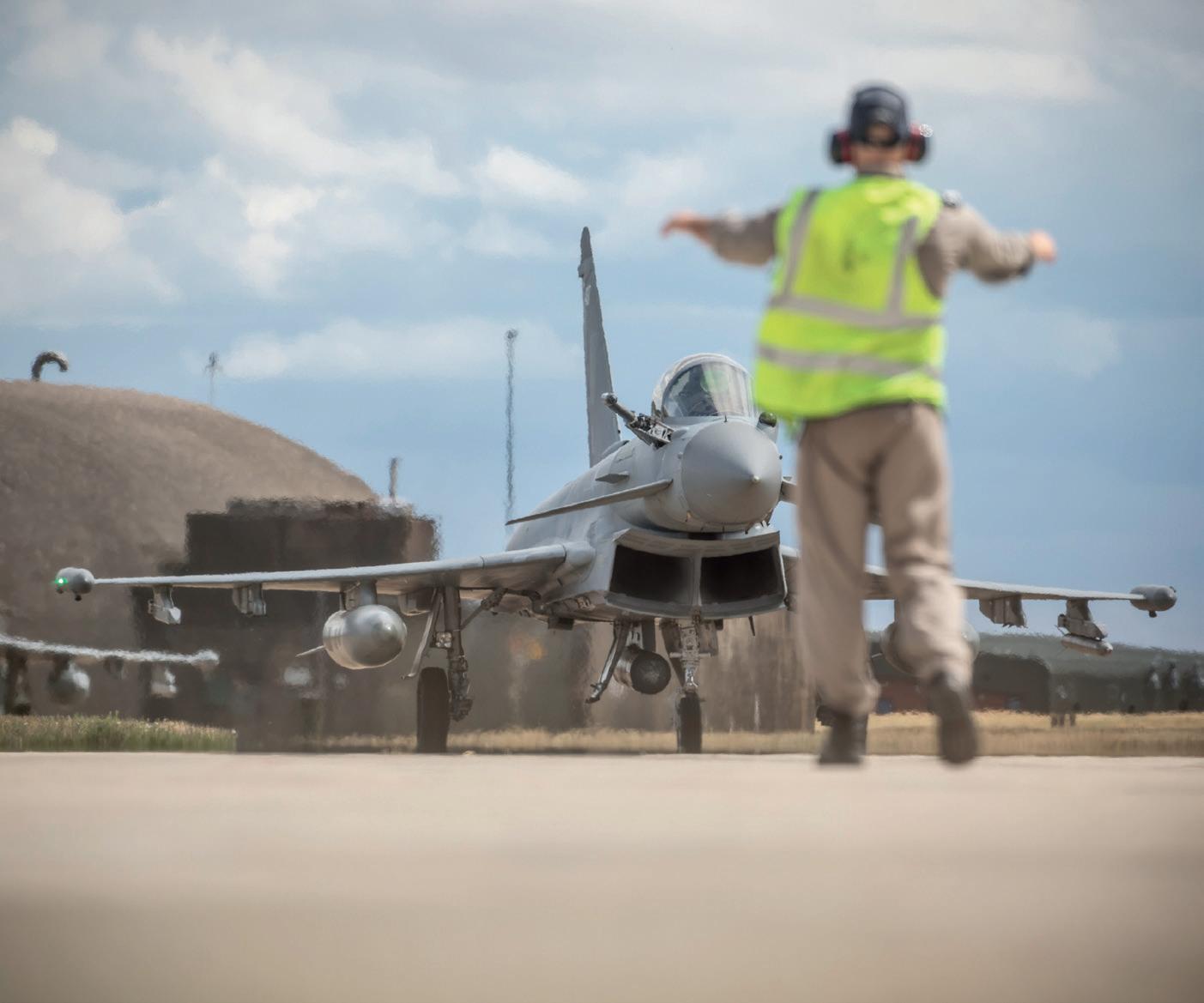
Group Captain Paul Sanger-Davies, Director of Air Studies (RAF), considers how the RAF can best develop its cognitive capabilities in order to outthink and out ght potential enemies
Cognitive superiority requires a diversity of thought that is often lacking within most western organisations (PHOTO: SHUTTERSTOCK)

“No one could have dreamed that we were being scrutinised. And yet across the gulf of space, minds immeasurably superior to ours regarded this earth with envious eyes and slowly, and surely they drew their plans against us”
This paraphrasing of the epic opening narration to one of the most iconic lms of the past century, War of the Worlds, relates to a clash of civilisations on a global scale. And it could equally apply to the epoch-de ning strategic challenges that we are facing in this century and will be facing well into the next. We now inhabit a world where those occupying di erent spaces across our globe are thinking di erently to us, in ways which we nd alien, and whose grand designs relating to the future international order
which governs our Earth and their place within it di er from ours. This becomes increasingly important when some states seem only too willing to use force to achieve their strategic ambitions.
So, if our future is increasingly likely to involve force being used against us, then how do we outthink in order to out ght our future enemies? And, if future thinking is as important as future ghting, why are we seemingly so bad at this when our potential adversaries are seemingly so good at it?
This challenge is even more di cult when we know so little about our future adversaries and, in comparison, they know so much about us, as we represent democratic and, therefore, relatively open societies, whereas they represent comparatively closed and, thus, opaque societies.
It is also exacerbated because, for many years, they have been placing their brightest and best
scholars within our leading academic institutions and harvesting our thought-leading ideas, then exporting, evolving and enhancing them. If you consider how many Masters and PhD-level studies are currently being undertaken around the world and who is undertaking them, you might nd that in areas of key technological evolution, including arti cial intelligence (AI), the vast majority are scholars from the East. And, if this trend is the case for one critical emerging technology, then it could also be true for others, including quantum computing and hypersonic propulsion.
This strategic challenge is compounded further when we bring the availability of future resources into play. From a UK perspective, the likelihood of receiving signi cantly more funding to invest in defence and security is increasingly unlikely, and we must therefore heed the sage advice of one of our greatest leaders and strategic thinkers, Winston Churchill, who so famously highlighted that, “Gentlemen, we are out of money; now we have to think.”
Diversity of thought is fundamental to addressing this strategic challenge. For, if we think and act in the same way, we will lack the diverse thinking we need to survive in a future world that is ever more complex, and where doing things as they have been done before simply will not be su cient. This is compounded further when considering that most of our future leaders attend the same careerdevelopment courses and academic institutions and are, therefore, likely to think and act in similar ways.
So, we need to encourage our future thinkers to think di erently and to think di erent things, and we also need to attract more people to our organisations who think di erently, using a multitude of di ering perspectives. This must entail supporting our next generation of strategic thinkers to think way outside of our current conceptual boxes and to develop their strategic acumen in the company of others who think di erently. We must also connect more regularly to those with other ideas, from other sectors and other nations.
This will encourage what Matthew Syed, in his book Rebel Ideas: The Power of Diverse Thinking, terms the ‘recombination’ of foundational ideas from di ering sectors, involving the cross-pollination of ideas that have never previously been connected. For instance, one of our foremost space scholars has recently been studying the applicability of classical ballet to space warfare, and how complex dance choreography could translate to orchestrating advanced space operations. This might seem like a ight of fancy, yet a leading historical military thinker, JFC Fuller, used a similar approach when considering the evolution of mechanised warfare.
And we must also embrace what is known as assumption reversal – including turning the foundational principles of our organisation on their heads. For instance, one of those would be that Air Forces use air bases. Yet what if Air Forces did not, or could not use air bases, as they were denied to us by our adversaries. In this case, if we had applied su cient diversity of thought to this scenario, we would be able to work around this challenge, adapt and overcome.
We also need to consider the impact of emerging and future technologies in our thinking, including how we most e ectively employ such technologies within the military context, and how the use of such technologies will change our thinking. For example, the power of current AI algorithms is only as good as the ability of those humans who write them. And they can only improve their e ectiveness by testing and learning from those data sets and underpinning scenarios that they have encountered. This means that, by utilising alien thinking, it is still possible to counter and defeat AI-enabled systems, because humans can think in ways that seem alien to the AI algorithms. Conversely, more and more exposure to advanced algorithmic-derived capabilities will encourage humans to think in di ering ways.
This was exempli ed by Lee Sedol, the world champion player of Go, when playing AlphaGo, which used seemingly alien moves when playing against him. Following this experience, Lee Sedol highlighted that he started to alter and evolve his own game style, following his experience of trying to counter moves that had not yet been conceived by other humans.
So, when we seek to gain and then maintain cognitive supremacy over those who think di erently to us, we have to encourage those within our ranks who think di erently and engage with those who have di ering perspectives to our own. Only in this way will we be able to outthink and then out ght our future adversaries.
DeepMind’s AlphaGo system was able to conceive of moves in the strategy game Go that no human being had even considered (PHOTO: SHUTTERSTOCK)

Jenny Beechener asks the Commandant of the Tedder Academy of Leadership, Group Captain Emma Keith, how she ensures that leadership and command education is accessible to everyone across the Whole Force and how the Academy encourages leadership at all levels of the RAF
Predicting the skills that will be needed to lead the RAF in 10 years’ time and beyond is quite a challenge. The Tedder Academy of Leadership (TAL) has embraced this task by contemplating what impact global strategic trends – fast-paced technology, climate change, human migration, global age disparities and polarisation – will have on the future RAF.
TAL has also considered the core values and ethos required to underpin the behaviours of its future workforce. A collegiate approach to these
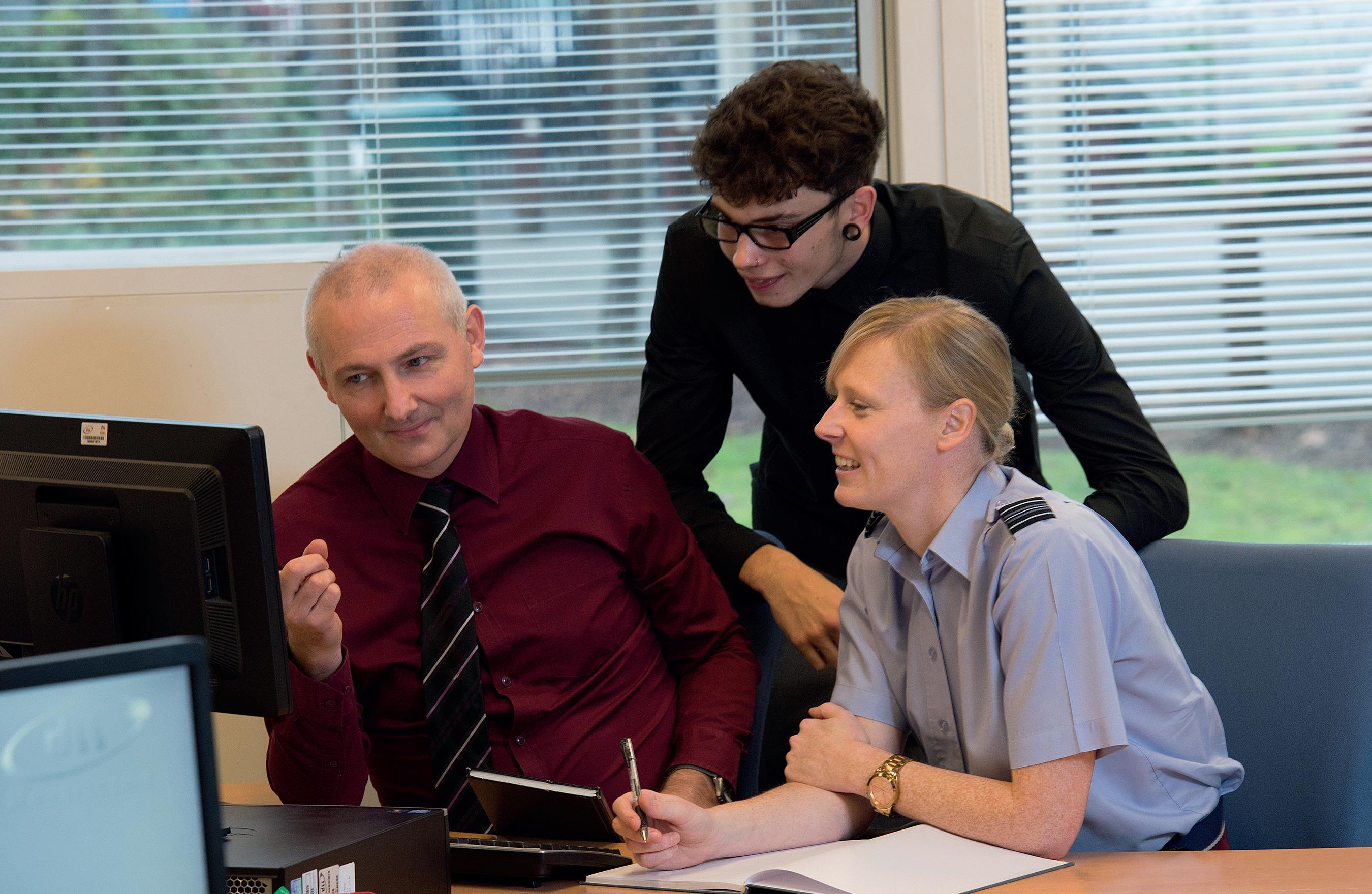
questions has been essential, recognising that all members of the Whole Force (military, civil service, and contractors) must integrate and work together to achieve the high performance required to face the current and future operating context.
The Academy Commandant, Group Captain (Gp Capt) Emma Keith, says great leadership “can produce discretionary e ort and deliver competitive edge”, especially at a time of scal constraint and stretched resource. “The world is in such a period of change; we have had periods of rapid change
before, such as the invention of electricity, yet, due to the scale of global connectivity, the pace of change is increasingly complex and multifaceted.
“One interesting element about current leadership is the requirement to operate and think across multiple disciplines. For example, the military and, arguably, society require leaders who not only understand technology, yet also the human impact of technology. How many computer scientists are also philosophers? As it is extremely rare to nd one individual with all the required knowledge to cover all angles of a decision, there is a need for leaders to garner and capitalise on the knowledge of experts at all levels of the organisation.”
Gp Capt Keith explains that TAL itself must be open to challenge to ensure it does not operate in an echo chamber of military leadership. One initiative to exploit diversity of thought and invite alternate perspectives is the creation of a new senior advisory panel, bringing together experts from business, academia and the military to provide comment and challenge. The Academy also regularly engages with the Royal Navy and the Army, as well as air forces around the world.
“The only way we will successfully confront future challenges is by truly harnessing collective knowledge,” says Gp Capt Keith. “People at the top of organisations should understand that they need to be learning too; it is a continuous journey, and they must have the self-awareness

to know when they haven’t got a skill set and work to bring it into their team.”
TAL’s philosophy to support and engage leaders at all levels is supported in practical ways. As people learn and engage with material di erently, TAL has created ‘Tedder: Your Way’ – a resource bank of products, including podcasts, visual media and interviews – to allow more choice. An annual conference and ‘Lead & Learn’ webinars are further ways to ignite leadership conversations across the RAF. The Academy also engages with a broader audience through posts on Twitter and Instagram. More in-depth studies into speci c leadership topics are encouraged through Spotlight articles and nomination of a Book of the Month.
The multigenerational nature of the RAF is another interesting element to consider. Gp Capt Keith highlights, “There’s a lot of discussion about transitioning the RAF to meet the needs of the Next Generation, yet, as a multi-generational workforce with the working age extended to 60, it is imperative to ensure that the Service meets the needs of all members of its workforce and extracts the talent from every person, irrelevant of generation.
“The senior elements of the Service must absolutely listen to the younger people and be pro-active about transitioning the organisation to meet the requirements of the future, yet wisdom and experience must not be dismissed. The correct balance of old and new will create the real magic; the challenge is how to ensure that crossgenerational learning and listening takes place.”
She expands, “If senior personnel move into ‘tell’ mode or do not listen e ectively then their strategies and ideas will not connect. The conversation must be respectful to what each generation brings to bene t the whole. One example of seeing this in practice is the creation of ‘RAF MentorMe’, a platform designed to allow the mentee to nd the mentor right for them; yet, importantly, it is open to the Whole Force, so a military person can learn from a civil servant or a contractor who has had di erent training and life experiences. Of note, the scheme promotes reverse mentoring, encouraging senior leaders to pair with junior sta to receive feedback and encounter alternate perspectives.”
RAF Force Development Centres play an important role in sharing the leadership strategy across the Whole Force. TAL representatives work closely with these centres, which are located at every station, and use them to promote leadership development opportunities. The Academy also sponsors a selection of people of all ranks to study leadership and to improve knowledge and understanding across the Service. This creates further ‘Tedder Advocates’ out on Units.

Gp Capt Keith believes leadership must not be limited to positions of authority, but extends
to everyone. A rank or role can give you powers of authority, but it cannot provide respect; to gain respect, you must lead. An individual with no subordinates or position of authority can still lead – they can lead their peers by role-modelling good behaviour and setting an example. An individual can also lead themselves; to lead yourself encompasses two-parts: self-awareness and self-management. Self-awareness on its own is not enough, you must do something about the behaviour to truly lead yourself.
Interestingly, Gp Capt Keith does not like the term ‘follower’, despite it being used in literature and other militaries. She thinks that ‘follower’ as a term on its own is too passive. It needs a word in front of it – for example, ‘engaged follower’ or ‘responsible follower’. In an organisation where di cult decisions need to be made at every level, the term ‘follower’ on its own should be questioned, as we do not want people to follow aimlessly. There are leaders at all levels, recognising that those leaders must have followership skills. This is a subtle, yet important, distinction. A leader with followership skills knows how to support their chain of command and retains the ability to lead themselves, to role model and, ultimately, to be accountable for their own contribution to a situation as an engaged and thinking person.
Mission command, the RAF’s fundamental leadership philosophy, promotes the need to push
decisions down to the appropriate level, to provide the what and why, yet to allow the person enacting a plan to deliver on the how. This concept allows greater agility and freedom of action at speed. The Ukraine war has shown us the importance of being responsive and uid, responding at speed to a constantly shifting context. “Mission command requires every single person involved to be connected and to have accountability to the situation they are a part of to make the RAF a truly highperforming team,” says Gp Capt Keith.
Equally challenging is recognising that future leaders in the RAF may require very di erent pathways. One example is a potential increase in workforce neurodiversity within areas such as cyber. What does leadership look like in this structure and how do you motivate and promote in new ways? Making the transition from today’s rigid leadership structure to one that supports a more uid future environment requires elements of positive risk and a deeper understanding and recognition of di erent perspectives and skillsets.
In considering what skills leaders will require in the future, the Academy also identi es the “growing importance of in uence and persuasion skills”. In a more connected world, a leader is unlikely to have positional authority over every person who will have input into a task. The use of contractors across Defence is one example where people outside the direct chain of command have an impact on outcomes for military personnel. Leaders will need to recognise the need for greater engagement across multiple teams using modern means of communication. A broader perspective is more likely to engender team synergy and generate better outcomes.
Diversity of thought is a much-used phrase and, while it is imperative to have di erent views to come to a sophisticated answer, it is important to recognise that diverse teams can generate challenge. According to Gp Capt Keith, “You have to accept that it may take longer to make decisions, because diversity of thought, by its very nature, means considering and incorporating di ering viewpoints. We speak a lot about the need for leaders to listen to all ideas and views, yet they must also know when to decide. It is not the same as collaboration and at some point a leader is going to have to move forward. Leadership needs to harness that diversity and know when to act.”
It is vital that a leader provides clarity to a team on the ownership of a decision; is this a democratic decision determined by the group, or is the leader asking for ideas and input, but will then make the nal decision? This clarity can avoid dissatisfaction when ideas are not progressed.
TAL is responsible for setting the strategic direction of leadership within the RAF, so the team is asking itself these challenging questions and how it can support the organisation and workforce to provide exceptional leadership at all levels. Gp Capt Keith comments that “high-performing teams do not look for excuses. They are not blind to the challenges; they acknowledge them, but they seek solutions. Ultimately, every member of the Whole Force needs to play their part in building a high-performing RAF that is t to defend the interests of the UK at home and abroad, now and into the future”.
An individual can lead themselves with selfawareness and self-management (PHOTO: MOD/ CROWN COPYRIGHT)

“Mission command requires every single person involved to be connected and to have accountability to the situation they are a part of”
Honourable Group Captain Kevin Billings from 601 Squadron explains why it is the right time to double down on the RAF’s commitment to addressing climate change
The production of synthetic fuels on the battle eld will not only reduce CO2 emissions, it will also negate the need for vulnerable convoys
In spite of the immediate challenges of the war in Ukraine and belt-tightening across our air forces and militaries, now is the time to be more resolute than ever in confronting climate change – not simply to address the threat, but also to embrace it as an opportunity to change the face of warfare as we know it. Our ability to develop and use energy and sustainability as an asymmetrical advantage will be the deciding factor in the next war, and the time to start thinking that way and building it is now.
The way we have historically designed and used our armed forces is being disrupted. Centralised command and control, long logistics chains, expensive, gas-guzzling vehicles and heavily manned equipment, concentrated forward deployments of many personnel are all being undermined. Each one is becoming more vulnerable to arti cial intelligence (AI)-enabled weaponry and software-centric targeting.
The future force will be persistently engaged in a posture de ned by constant competition and

will require greater autonomy from its strategic base in order to generate greater agility, increased responsiveness and more precision within shorter, more resilient kill chains. Therefore, the adoption of more sustainable, green technologies is central to providing operational advantage to the future force. It should be viewed as a vital ingredient of any future ‘O set Strategy’ – one that seeks to maintain advantage over potential adversaries over long periods of time, while preserving peace wherever possible.
services the needs of the 5,000 forward-deployed troops and their electric/hybrid vehicle eet, yet, by its very nature, it also releases the force from having to protect the logistics tail that serviced the diesel generator farms of old. Moreover, combining these reactors with the portable air capture systems that are being developed today will allow the production of synthetic fuel in situ for all deployed heavy vehicles and supporting aviation – without any net contribution to CO 2 emissions.
To paraphrase Lieutenant General Richard Wardlaw, this is an opportunity to reset the paradigm faced by commanders over the last two millennia, unleashing operational commanders from the single biggest constraint on their freedom of manoeuvre – from Alexander to Montgomery to Mattis! Let environmental technologies become the means for a revolution in campaigning, one in which the emphasis shifts from logisticians planning to sustain at reach, to scientists and engineers designing for self-sustainment.
To put this into relatable terms, in Afghanistan and Iraq over 60% of allied casualties were taken as a direct result of enabling and protecting supply convoys. So, imagine instead a situation where the deployment of a micro-nuclear generator not only
In addition, the current development of the ‘Factory in a Box’ (deployed ISO units) and the decision to design equipment with 3D-printable parts will make a substantial di erence to the amount of deployed stocks, reducing the movement of inventory by nearly 40%. Furthermore, the introduction of directed-energy weapon systems, together with access to their required energy sources, will e ectively introduce the production of ammunition on the front line. Reducing the volume of ammunition that needs to be moved and stored will liberate Joint Force Commanders in terms of planning force movements. Perhaps most signi cantly, the decisions we make today to e ectively leverage digitisation, data, edge-processing, AI and machine learning will accelerate the adoption and exploitation of
In 2022, 34 of the world’s leading air chiefs signed a declaration to address climate change (PHOTO: MOD/ CROWN COPYRIGHT)
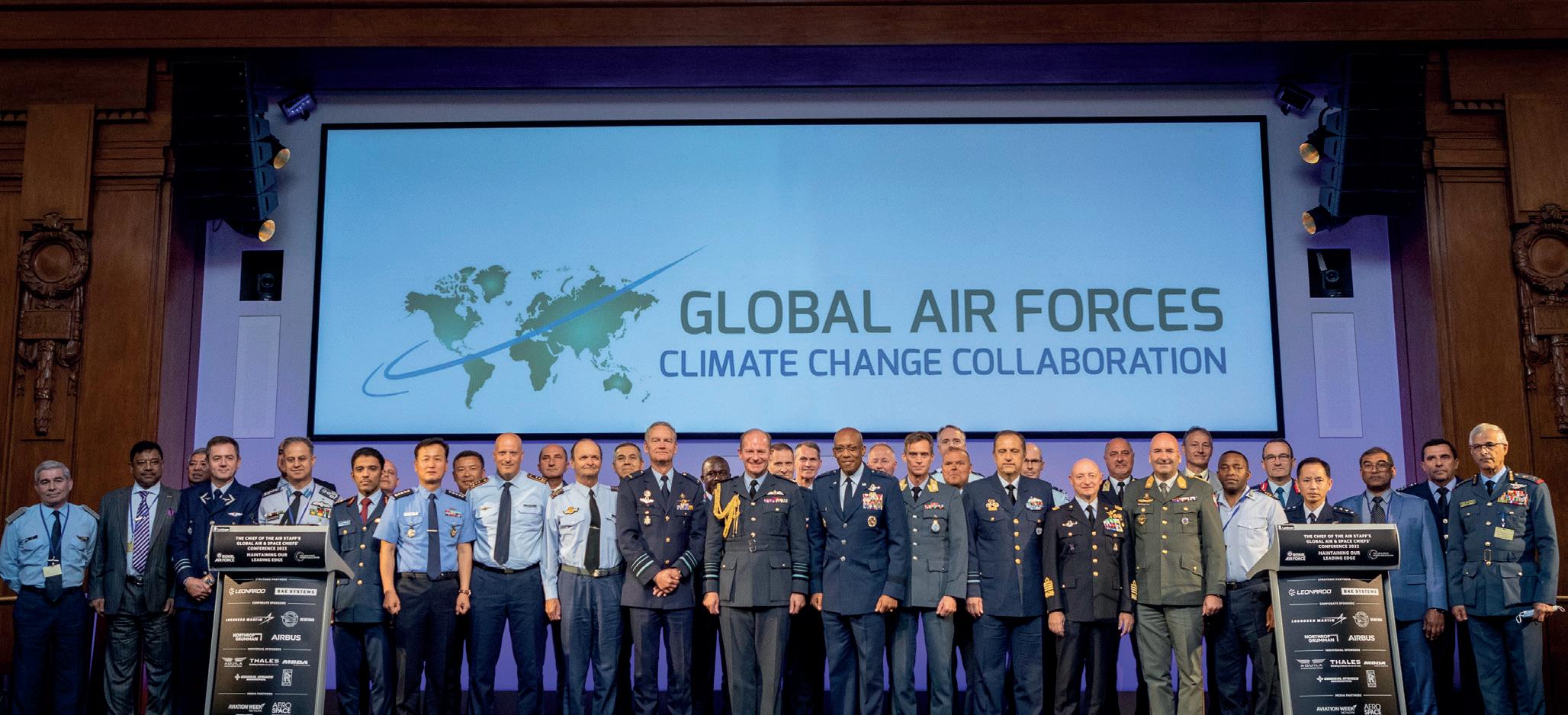
“The decisions we make today... will accelerate the adoption and exploitation of technologies to achieve dramatic improvements in how we orchestrate and employ our forces”
In November 2022, an RAF Voyager ew over Oxfordshire, powered by 100% sustainable aviation fuel –a world- rst for a military aircraft of its size (PHOTO: MOD/ CROWN COPYRIGHT)

technologies to achieve dramatic improvements in how we orchestrate and employ our forces and their capabilities. This will enable humans to focus on doing what humans do well, while having machines doing what machines do well. This will undoubtedly increase the resilience, sustainability and lethality of our forces. For example, using advanced technologies to consistently identify, track and strike targets 80% faster than we are currently able to do will result in fewer resources being expended to achieve our goals and, most importantly, this will save the lives of those we send into harm’s way.
Around the same time that Russia was ruthlessly besieging the city of Lysychansk, 34 air chiefs from six continents stood on the stage at the Institution of Engineering and Technology in London during the 2022 Chief of the Air Sta ’s Global Air and Space Chiefs’ Conference, having just signed a historic declaration recognising the existential challenge posed by climate change. This demonstrated their collective commitment to collaborate and share best practices, expertise, resources and research capacity to accelerate
progress towards the collective goal of optimising energy use, while simultaneously reducing greenhouse gas emissions and increasing mission e ectiveness.
In the year that has followed, the Global Air Forces Climate Change Collaboration (GAFCCC) has seen the participation of some 50 air forces across the globe, both in person and virtually, on topics ranging from deploying a net-zero expeditionary air base, to harvesting jet fuel from the air, to training the next generation of pilots.
This foresight and collective commitment recognises that tackling the challenge of climate change cannot be done in isolation. The GAFCCC is an alliance that is, perhaps, broader and more focused than any other comparable alliance in the world. Yet, as extraordinary as the technologies and ideas being shared are, the real power of the GAFCCC is the remarkable people that it is bringing together, the multiplier e ect of their ideas and the connections that strengthen the bonds shared among freedom-loving air forces and militaries.
With the strength of this alliance, the time to build our climate-enabled future is now. It will not only contribute to reducing the threat of climate change, it will also provide signi cant war- ghting advantages.
